Hubble Space Telescope 2019
Astronomy and Telescopes
Related resources
Hubble Status and Imagery in the Period 2019
• 27 December 2019: This swirling mass of celestial gas, dust, and stars is a moderately luminous spiral galaxy named ESO 021-G004, located just under 130 million light-years away. 1)
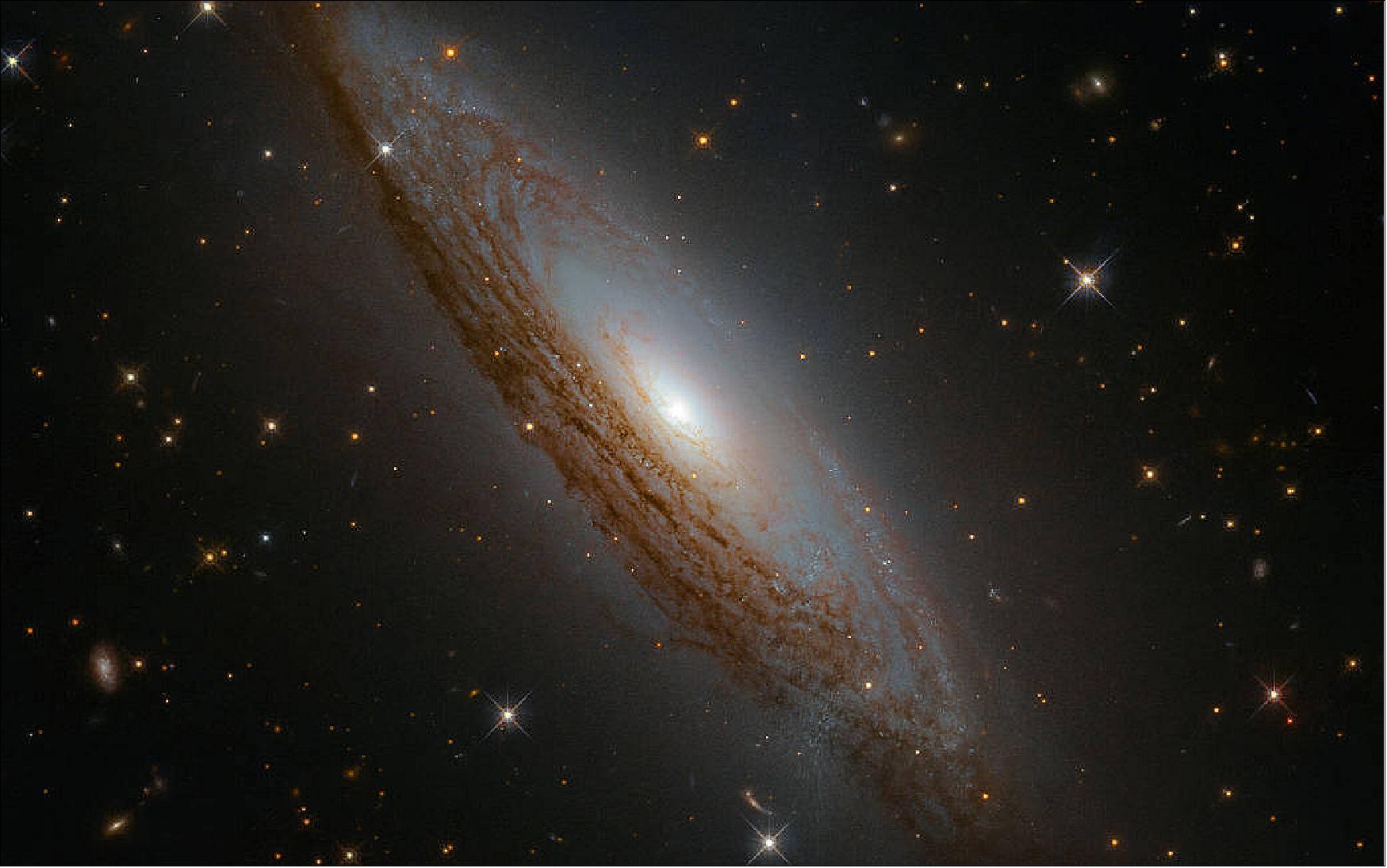
• 19 December 2019: New Type of World is Unlike Anything Found in the Solar System. When astronomers look around the solar system, they find that planets can be made out of almost anything. Terrestrial planets like Earth, Mars, and Venus have dense iron cores and rocky mantles. The massive outer planets like Jupiter and Saturn are mostly gaseous and liquid. Astronomers can't peel back their cloud layers to look inside, but their composition is deduced by comparing the planet's mass (as calculated from its orbital motion) to its size. The result is that Jupiter has the density of water, and Saturn has an even lower density (it could float in a huge bathtub). These gas giants are just 1/5th the density of rocky Earth. 2) 3)
![Figure 2: This illustration depicts the Sun-like star Kepler 51 and three giant planets that NASA's Kepler space telescope discovered in 2012–2014. These planets are all roughly the size of Jupiter but a tiny fraction of its mass. This means the planets have an extraordinarily low density, more like that of Styrofoam rather than rock or water, based on new Hubble Space Telescope observations. The planets may have formed much farther from their star and migrated inward. Now their puffed-up hydrogen/helium atmospheres are bleeding off into space. Eventually, much smaller planets might be left behind. The background starfield is correctly plotted as it would look if we gazed back toward our Sun from Kepler 51's distance of approximately 2,600 light-years, along our galaxy's Orion spiral arm. However, the Sun is too faint to be seen in this simulated naked-eye view [image credit: NASA, ESA, and L. Hustak, J. Olmsted, D. Player and F. Summers (STScI)]](/api/cms/documents/163813/5502378/Hubble2019_Auto49.jpeg)
- Now astronomers have uncovered a completely new class of planet unlike anything found in our solar system. Rather than a "terrestrial" or "gas giant" they might better be called "cotton candy" planets because their density is so low. These planets are so bloated they are nearly the size of Jupiter, but are just 1/100th of its mass. Three of them orbit the Sun-like star Kepler 51, located approximately 2,600 light-years away.
- The puffed-up planets might represent a brief transitory phase in planet evolution, which would explain why we don't see anything like them in the solar system. The planets may have formed much farther from their star and migrated inward. Now their low-density hydrogen/helium atmospheres are bleeding off into space. Eventually, much smaller planets might be left behind.
- "Super-Puffs" may sound like a new breakfast cereal. But it's actually the nickname for a unique and rare class of young exoplanets that have the density of cotton candy. Nothing like them exists in our solar system.
- New data from NASA's Hubble Space Telescope have provided the first clues to the chemistry of two of these super-puffy planets, which are located in the Kepler 51 system. This exoplanet system, which actually boasts three super-puffs orbiting a young Sun-like star, was discovered by NASA's Kepler space telescope in 2012. However, it wasn't until 2014 when the low densities of these planets were determined, to the surprise of many.
- The recent Hubble observations allowed a team of astronomers to refine the mass and size estimates for these worlds — independently confirming their "puffy" nature. Though no more than several times the mass of Earth, their hydrogen/helium atmospheres are so bloated they are nearly the size of Jupiter. In other words, these planets might look as big and bulky as Jupiter, but are roughly a hundred times lighter in terms of mass.
- How and why their atmospheres balloon outwards remains unknown, but this feature makes super-puffs prime targets for atmospheric investigation. Using Hubble, the team went looking for evidence of components, notably water, in the atmospheres of the planets, called Kepler-51 b and 51 d. Hubble observed the planets when they passed in front of their star, aiming to observe the infrared color of their sunsets. Astronomers deduced the amount of light absorbed by the atmosphere in infrared light. This type of observation allows scientists to look for the telltale signs of the planets' chemical constituents, such as water.
- To the amazement of the Hubble team, they found the spectra of both planets not to have any telltale chemical signatures. They attribute this result to clouds of particles high in their atmospheres. "This was completely unexpected," said Jessica Libby-Roberts of the University of Colorado, Boulder. "We had planned on observing large water absorption features, but they just weren't there. We were clouded out!" However, unlike Earth's water-clouds, the clouds on these planets may be composed of salt crystals or photochemical hazes, like those found on Saturn's largest moon, Titan.
- These clouds provide the team with insight into how Kepler-51 b and 51 d stack up against other low-mass, gas-rich planets outside of our solar system (Figure 3). When comparing the flat spectra of the super-puffs against the spectra of other planets, the team was able to support the hypothesis that cloud/haze formation is linked to the temperature of a planet — the cooler a planet is, the cloudier it becomes.
- The team also explored the possibility that these planets weren't actually super-puffs at all. The gravitational pull among the planets creates slight changes to their orbital periods, and from these timing effects planetary masses can be derived. By combining the variations in the timing of when a planet passes in front of its star (an event called a transit) with those transits observed by the Kepler space telescope, the team better constrained the planetary masses and dynamics of the system. Their results agreed with previous measured ones for Kepler-51 b. However, they found that Kepler-51 d was slightly less massive (or the planet was even more puffy) than previously thought.
- In the end, the team concluded that the low densities of these planets are in part a consequence of the young age of the system, a mere 500 million years old, compared to our 4.6-billion-year-old Sun. Models suggest these planets formed outside of the star's "snow line," the region of possible orbits where icy materials can survive. The planets then migrated inward, like a string of railroad cars.
- Now, with the planets much closer to the star, their low-density atmospheres should evaporate into space over the next few billion years. Using planetary evolution models, the team was able to show that Kepler-51 b, the planet closest to the star, will one day (in a billion years) look like a smaller and hotter version of Neptune, a type of planet that is fairly common throughout the Milky Way. However, it appears that Kepler-51 d, which is farther from the star, will continue to be a low-density oddball planet, though it will both shrink and lose some small amount of atmosphere. "This system offers a unique laboratory for testing theories of early planet evolution," said Zach Berta-Thompson of the University of Colorado, Boulder.
- The good news is that all is not lost for determining the atmospheric composition of these two planets. NASA's upcoming James Webb Space Telescope, with its sensitivity to longer infrared wavelengths of light, may be able to peer through the cloud layers. Future observations with this telescope could provide insight as to what these cotton candy planets are actually made of. Until then, these planets remain a sweet mystery.
![Figure 3: This illustration depicts the Sun-like star Kepler 51 and three giant planets that NASA's Kepler space telescope discovered in 2012–2014. These planets are all roughly the size of Jupiter but a tiny fraction of its mass. This means the planets have an extraordinarily low density, more like that of Styrofoam rather than rock or water, based on new Hubble Space Telescope observations. The planets may have formed much farther from their star and migrated inward. Now their puffed-up hydrogen/helium atmospheres are bleeding off into space. Eventually, much smaller planets might be left behind. The background starfield is correctly plotted as it would look if we gazed back toward our Sun from Kepler 51's distance of approximately 2,600 light-years, along our galaxy's Orion spiral arm. However, the Sun is too faint to be seen in this simulated naked-eye view. [image credit: NASA, ESA, and L. Hustak, J. Olmsted, D. Player and F. Summers (STScI)]](/api/cms/documents/163813/5502378/Hubble2019_Auto48.jpeg)
- The Hubble Space Telescope is a project of international cooperation between NASA and ESA (European Space Agency). NASA's Goddard Space Flight Center in Greenbelt, Maryland, manages the telescope. The Space Telescope Science Institute (STScI) in Baltimore conducts Hubble science operations. STScI is operated for NASA by the Association of Universities for Research in Astronomy in Washington, D.C.
• 16 December 2019: Galaxies come in a range of shapes and sizes. Spiral galaxies are characterized by a bright core and vast, pinwheeling arms of gas, dust and stars – NGC 1175 is such a galaxy, and also hosts something known as a ‘bar’ of material that slices through its center. Bars affect how material circulates throughout a galaxy, and look uniquely intriguing from afar. 4)
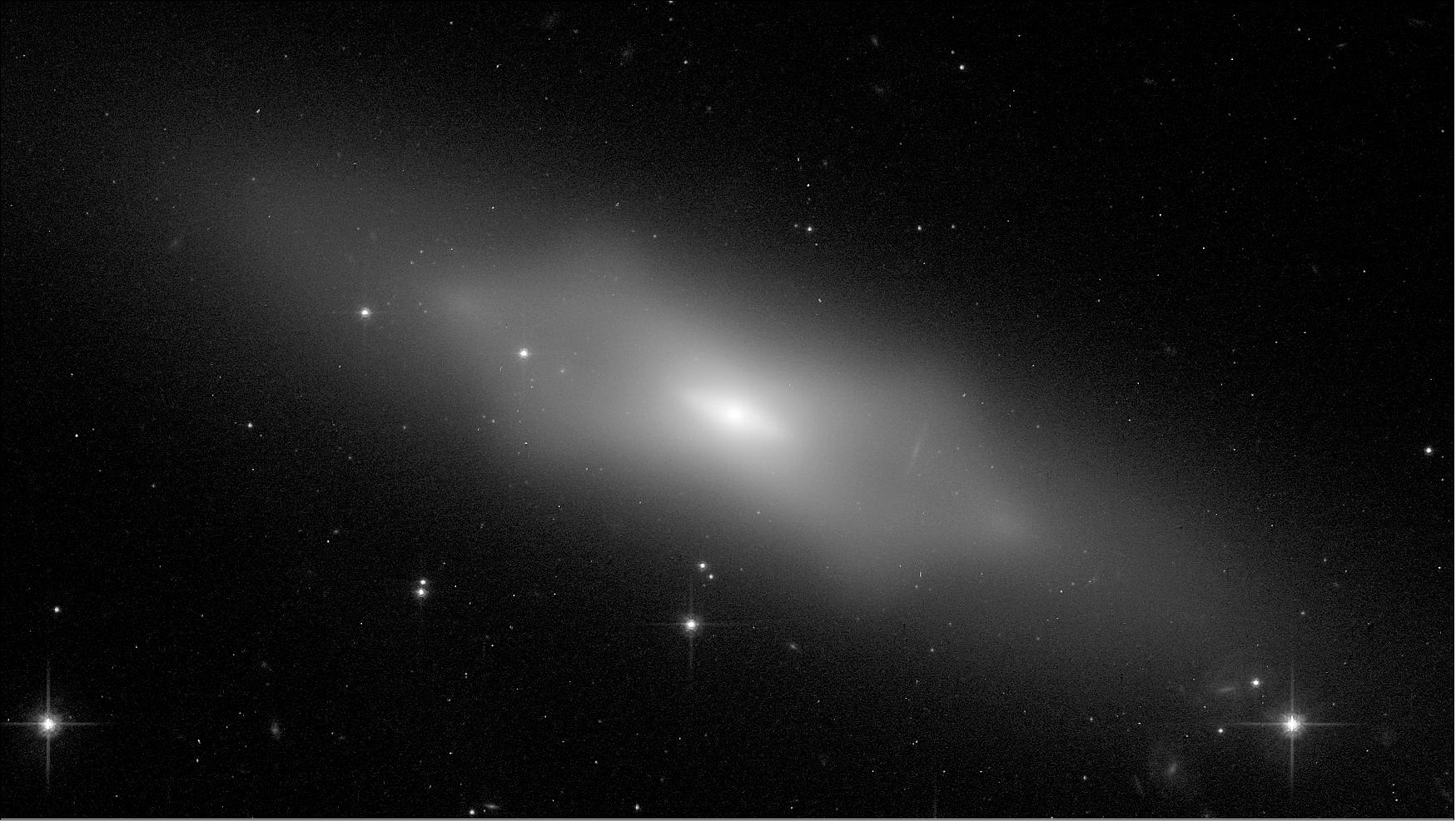
- And there’s more. When viewed edge-on, galaxies like this one have an even more peculiar morphology: their inner regions appear to be thicker in some directions than others, causing them to adopt a shape that is boxy and resembles an unshelled peanut or giant ‘X’.
- NGC 1175 was observed as part of a Hubble proposal named ‘Gems of the Galaxy Zoos’, for which a number of citizen scientists voted on the galaxies they wanted Hubble to observe when the telescope had gaps of time between scheduled projects. Voting took place on the Zooniverse platform. This image comprises infrared data gathered by Hubble’s Advanced Camera for Surveys on 18 July 2019.
- Despite studies implying that our very own cosmic home, the Milky Way, has an ‘X’-shaped core, it remains unclear how and when these boxy bulges formed. A recent study led by ESA research fellow Sandor Kruk used high-resolution Hubble data to explore galaxies more distant than NGC 1175. They found that these boxy bulges began forming some seven billion years ago, when the Universe was around half its current age. Their formation is related to that of galactic bars, which are thought to have formed about two billion years before the intriguingly shaped bulges began to emerge. The stars within these bars orbit the galactic center in complex, dynamic ways, with an array of vertical motions that contribute to the galaxies’ observed central boxy morphology.
- Hubble has spied a number of boxy/peanut-shaped galaxies, including the beautiful NGC 4710. Further research into these intriguing galaxies will be made possible by ESA’s upcoming Euclid mission, which will be able to survey how often these bulges crop up across a much larger number of galaxies, and by the James Webb Space Telescope (JWST), Hubble’s successor, which will be able to observe incredibly distant galaxies like these in order to better understand their history and formation. JWST is a joint project of NASA, ESA and the Canadian Space Agency.
• 13 December 2019: The NASA/ESA Hubble Space Telescope has once again captured comet 2I/Borisov streaking through our solar system on its way back into interstellar space. At a breathtaking speed of over 175,000 km/hour, Borisov is one of the fastest comets ever seen. It is only the second interstellar object known to have passed through the Solar System. 5) 6)
- Comet 2I/Borisov is only the second interstellar object known to have passed through our Solar System. In this image taken by the NASA/ESA Hubble Space Telescope, the comet appears in front of a distant background spiral galaxy.
- The galaxy's bright central core is smeared in the image because Hubble was tracking the comet. Borisov was approximately 326 million kilometers from Earth in this exposure. Its tail of ejected dust streaks off to the upper right.
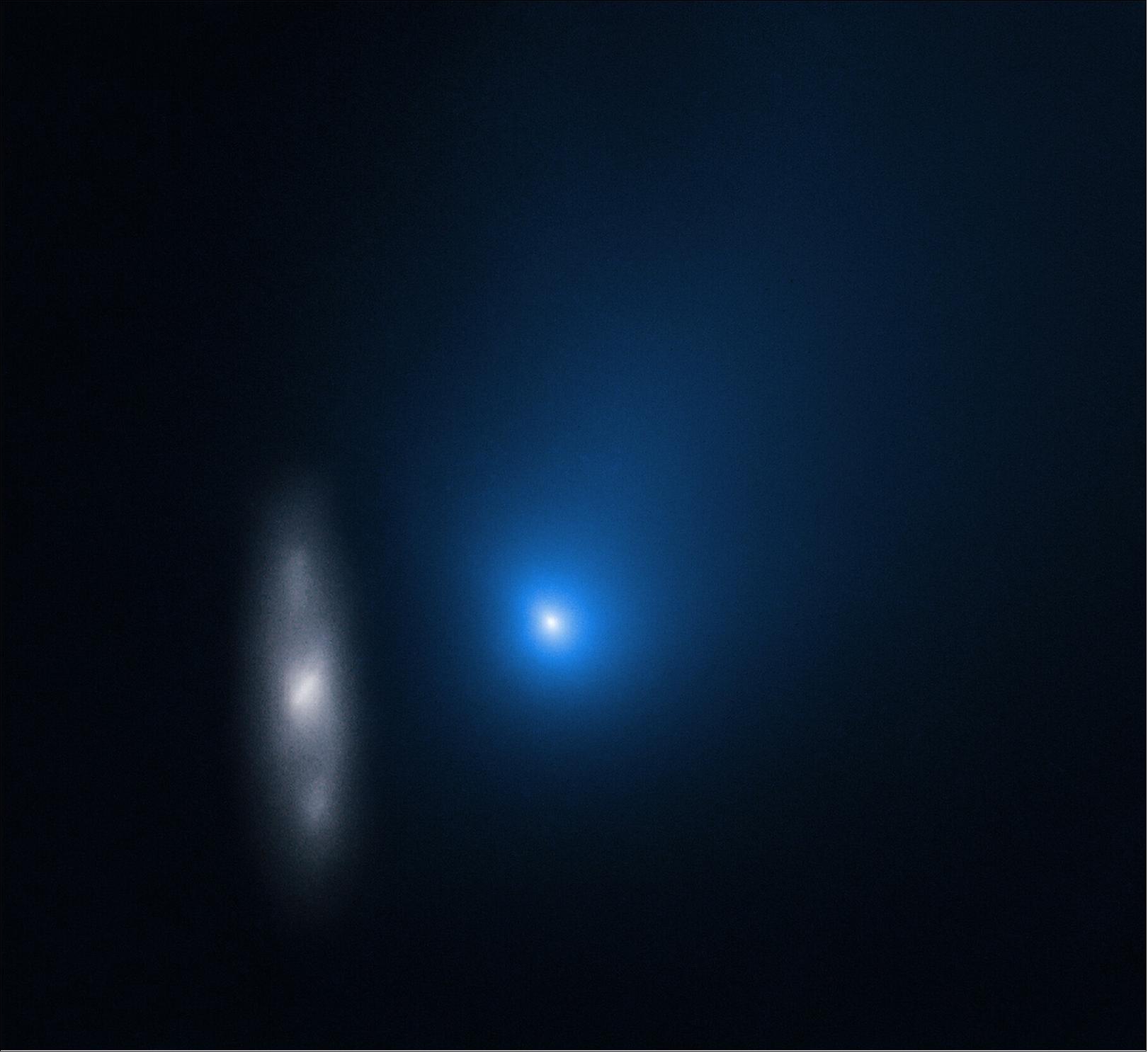
• 06 December 2019: Some of the most dramatic events in the Universe occur when certain stars die — and explode catastrophically in the process. 8)
- Such explosions, known as supernovae, mainly occur in a couple of ways: either a massive star depletes its fuel at the end of its life, become dynamically unstable and unable to support its bulk, collapses inwards, and then violently explodes; or a white dwarf in an orbiting stellar couple syphons more mass off its companion than it is able to support, igniting runaway nuclear fusion in its core and beginning the supernova process. Both types result in an intensely bright object in the sky that can rival the light of a whole galaxy.
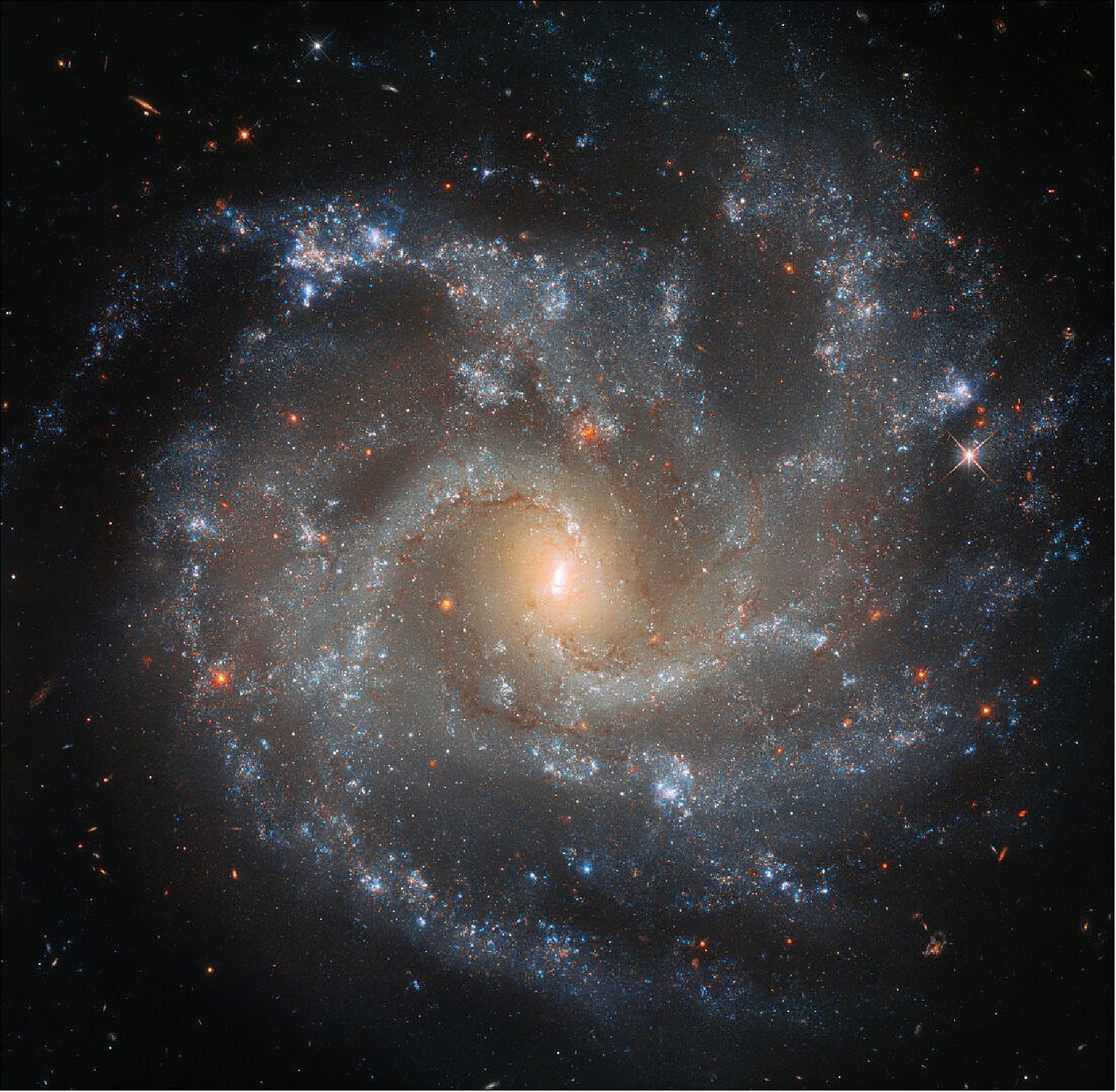
• 29 November 2019: Some galaxies are closer friends than others. While many live their own separate, solitary lives, others stray a little too close to a near neighbor and take their relationship to the next level. 9)
- The NASA/ESA Hubble Space Telescope has viewed a number of interacting pairs. These can have distinctive, beautiful, and downright odd shapes, ranging from sheet music to a spaceship entering a sci-fi-esque wormhole, a bouquet of celestial blooms, and a penguin fiercely guarding its precious egg.
- Arp 293 is located in the constellation of Draco (The Dragon), and lies over 250 million light-years from Earth.
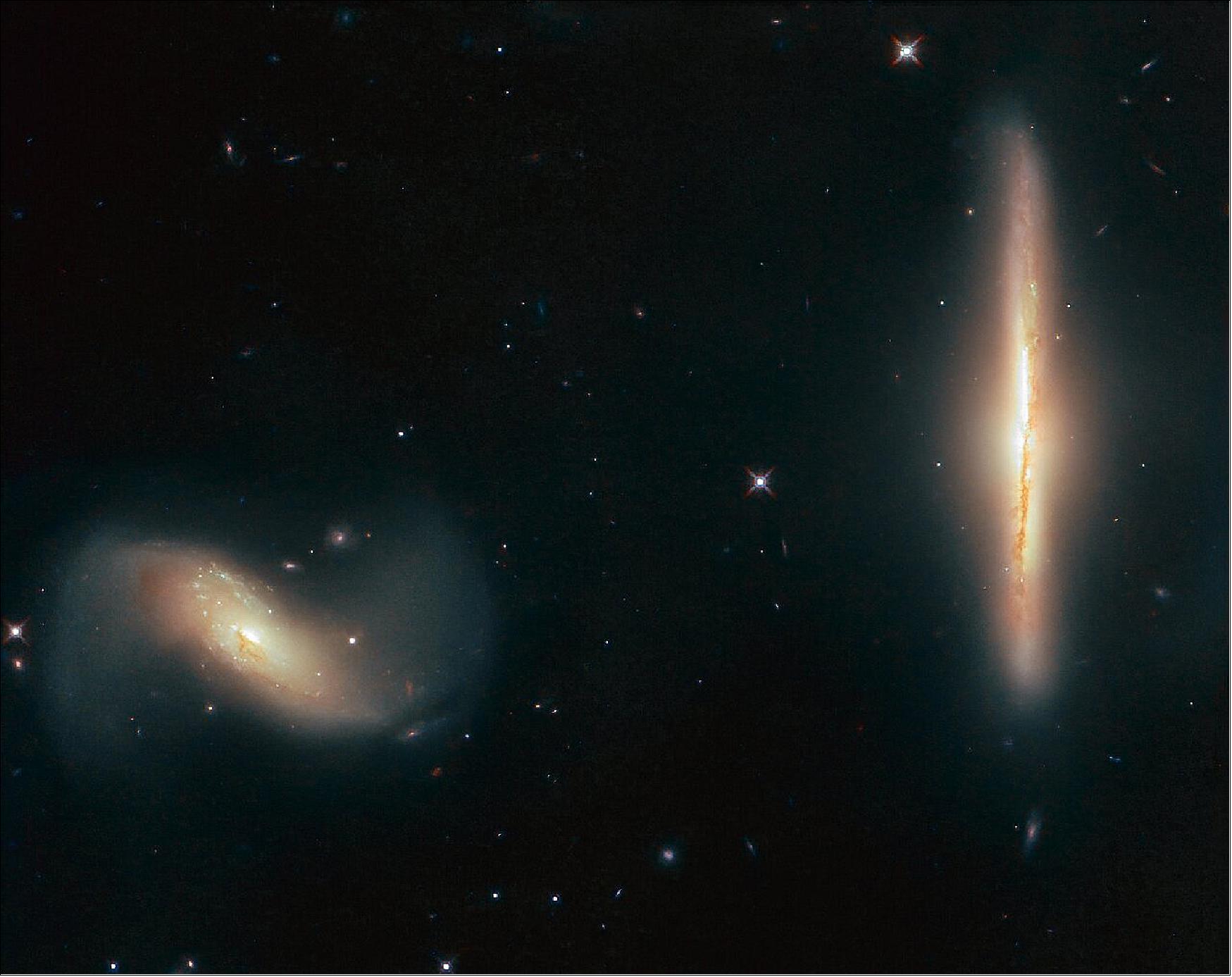
• 21 November 2019: New observations from the NASA/ESA Hubble Space Telescope have investigated the nature of the gamma-ray burst GRB 190114C. 10)
- Gamma-ray bursts are the most powerful explosions in the Universe. They emit most of their energy in gamma rays, light which is much more energetic than the visible light we can see with our eyes.
- In January 2019, an extremely bright and long gamma-ray burst (GRB) was detected by a suite of telescopes, including NASA's Swift and Fermi telescopes, as well as by the Major Atmospheric Gamma Imaging Cherenkov (MAGIC) telescopes. Known as GRB 190114C, some of the light detected from the object had the highest energy ever observed: 1Tera electron volt (TeV)—about one trillion times as much energy per photon as visible light. Scientists have been trying to observe such very high energy emission from GRBs for a long time, so this detection is considered a milestone in high-energy astrophysics.
- Previous observations revealed that to achieve this energy, material must be emitted from a collapsing star at 99.999% the speed of light. This material is then forced through the gas that surrounds the star, causing a shock that creates the gamma-ray burst itself. For the first time, scientists have observed extremely energetic gamma rays from this particular burst.
- “Hubble’s observations suggest that this particular burst was sitting in a very dense environment, right in the middle of a bright galaxy 5 billion light years away. This is really unusual, and suggests that this concentrated location might be why it produced this exceptionally powerful light,” explained one of the lead authors, Andrew Levan of the Institute for Mathematics, Astrophysics and Particle Physics Department of Astrophysics at Radboud University in the Netherlands. 11) 12)
- “Scientists have been trying to observe very high energy emission from gamma-ray bursts for a long time,” explained lead author Antonio de Ugarte Postigo of the Instituto de Astrofísica de Andalucía in Spain. "This new Hubble observation of accompanying lower-energy radiation from the region is a vital step in our understanding of gamma-ray bursts [and] their immediate surroundings."
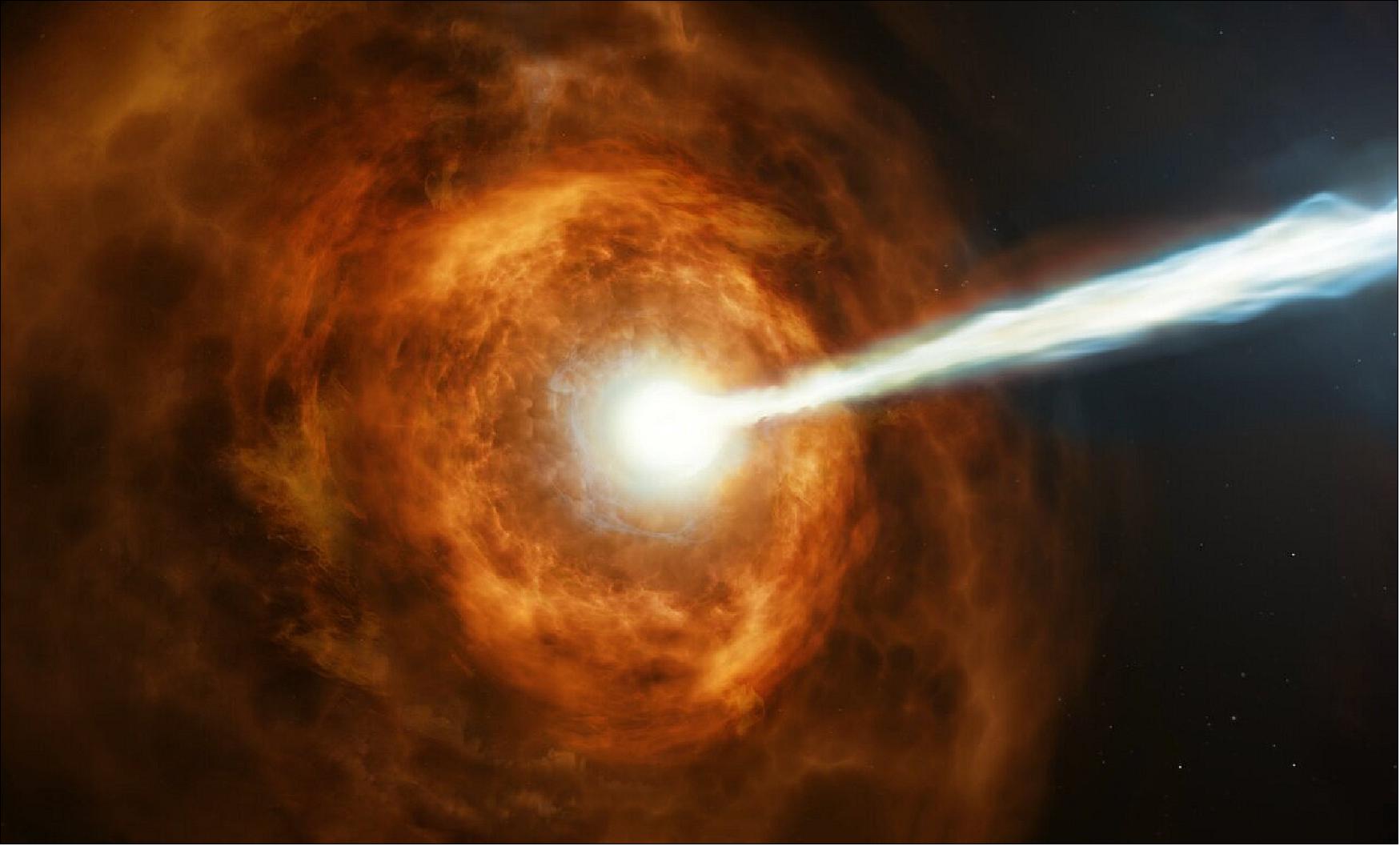
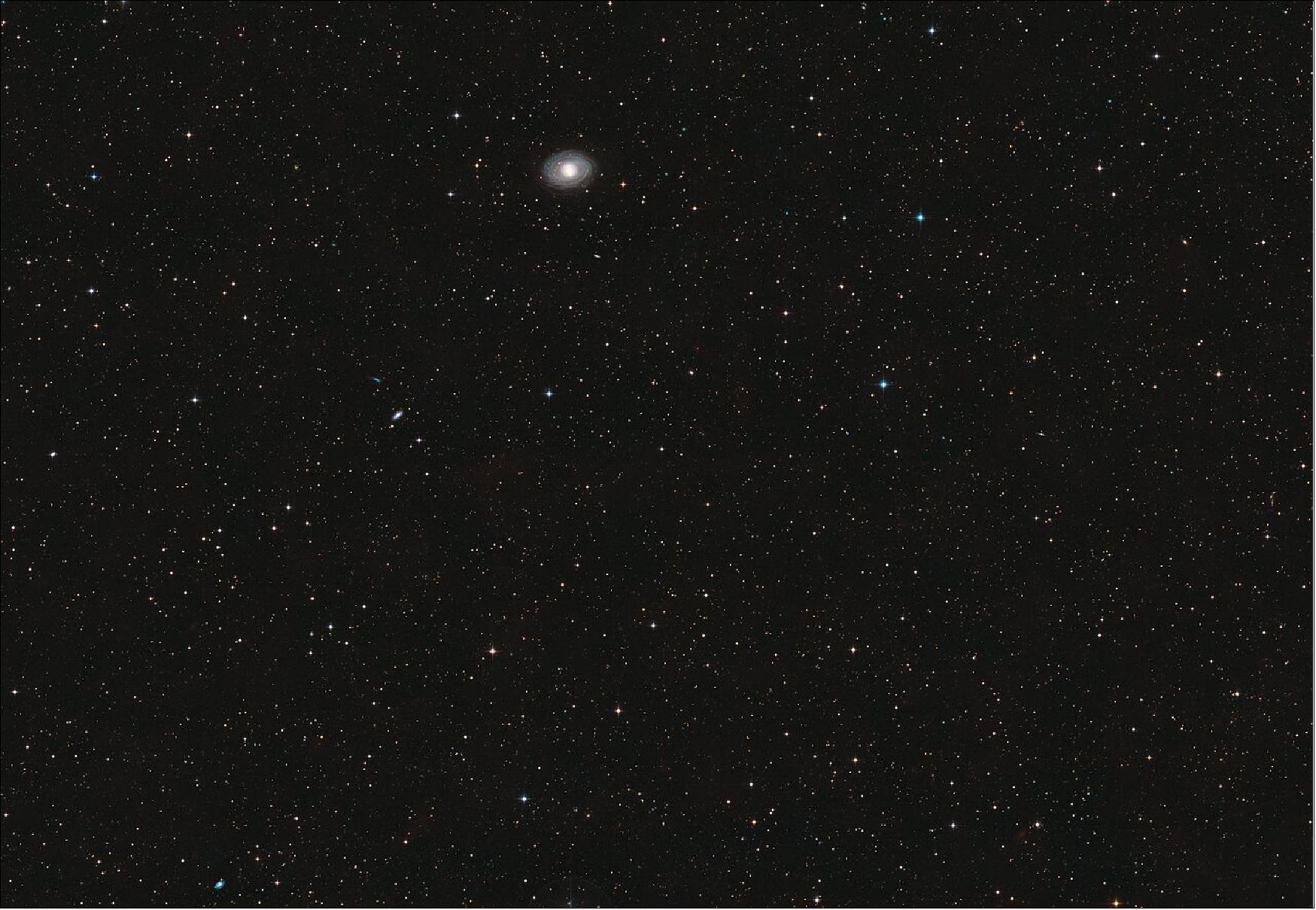
• 15 November 2019: The Universe is simply so vast that it can be difficult to maintain a sense of scale. Many galaxies we see through telescopes such as the NASA/ESA Hubble Space Telescope, the source of this beautiful Picture of the Week, look relatively similar: spiralling arms, a glowing center, and a mixture of bright specks of star formation and dark ripples of cosmic dust weaving throughout. 13)
- This galaxy, a spiral galaxy named NGC 772, is no exception. It actually has much in common with our home galaxy, the Milky Way. Each boasts a few satellite galaxies, small galaxies that closely orbit and are gravitationally bound to their parent galaxies. One of NGC 772’s spiral arms has been distorted and disrupted by one of these satellites (NGC 770 — not visible in the image here), leaving it elongated and asymmetrical.
- However, the two are also different in a few key ways. For one, NGC 772 is both a peculiar and an unbarred spiral galaxy; respectively, this means that it is somewhat odd in size, shape, or composition, and that it lacks a central feature known as a bar, which we see in many galaxies throughout the cosmos — including the Milky Way. These bars are built of gas and stars, and are thought to funnel and transport material through the galactic core, possibly fueling and igniting various processes such as star formation.
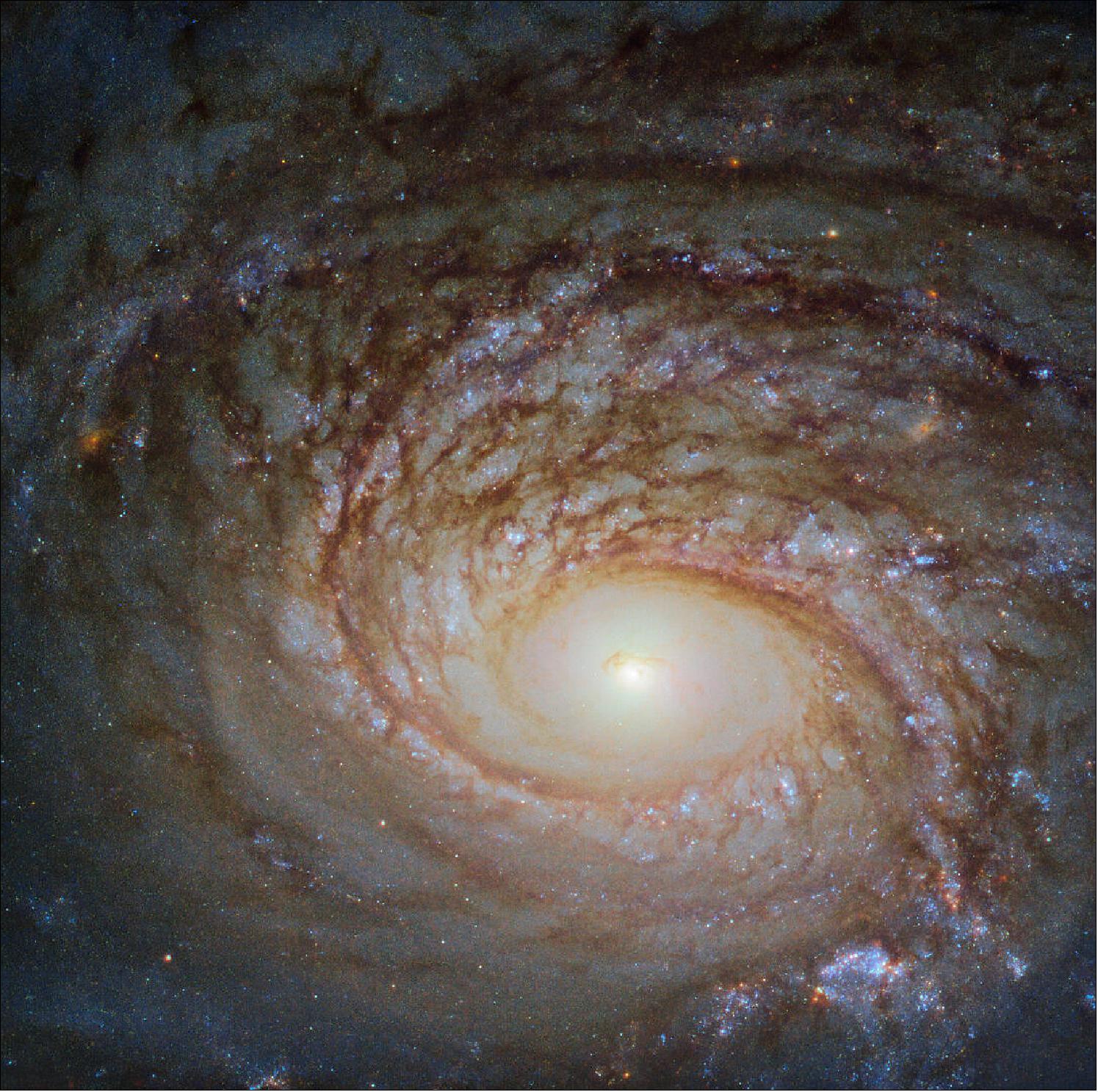
• 07 November 2019: This new image from the NASA/ESA Hubble Space Telescope shows an astronomical object whose image is multiplied by the effect of strong gravitational lensing. The galaxy, nicknamed the Sunburst Arc, is almost 11 billion light-years away from Earth and has been lensed into multiple images by a massive cluster of galaxies 4.6 billion light-years away [1]. 14)
Note [1]: The official designation of the Sunburst Arc galaxy is PSZ1 G311.65-18.48.
- The mass of the galaxy cluster is large enough to bend and magnify the light from the more distant galaxy behind it. This process leads not only to a deformation of the light from the object, but also to a multiplication of the image of the lensed galaxy.
- In the case of the Sunburst Arc the lensing effect led to at least 12 images of the galaxy, distributed over four major arcs. Three of these arcs are visible in the top right of the image, while one counterarc is visible in the lower left — partially obscured by a bright foreground star within the Milky Way.
- Hubble uses these cosmic magnifying glasses to study objects otherwise too faint and too small for even its extraordinarily sensitive instruments. The Sunburst Arc is no exception, despite being one of the brightest gravitationally lensed galaxies known.
- The lens makes various images of the Sunburst Arc between 10 and 30 times brighter. This allows Hubble to view structures as small as 520 light-years across — a rare detailed observation for an object that distant. This compares reasonably well with star forming regions in galaxies in the local Universe, allowing astronomers to study the galaxy and its environment in great detail.
- Hubble’s observations showed that the Sunburst Arc is an analogue of galaxies which existed at a much earlier time in the history of the Universe: a period known as the epoch of reionization — an era which began only 150 million years after the Big Bang [2].
Note [2]: The further we look into space, the further back we look in time. This allows astronomers to study different epochs of the Universe, by studying objects at different distances.
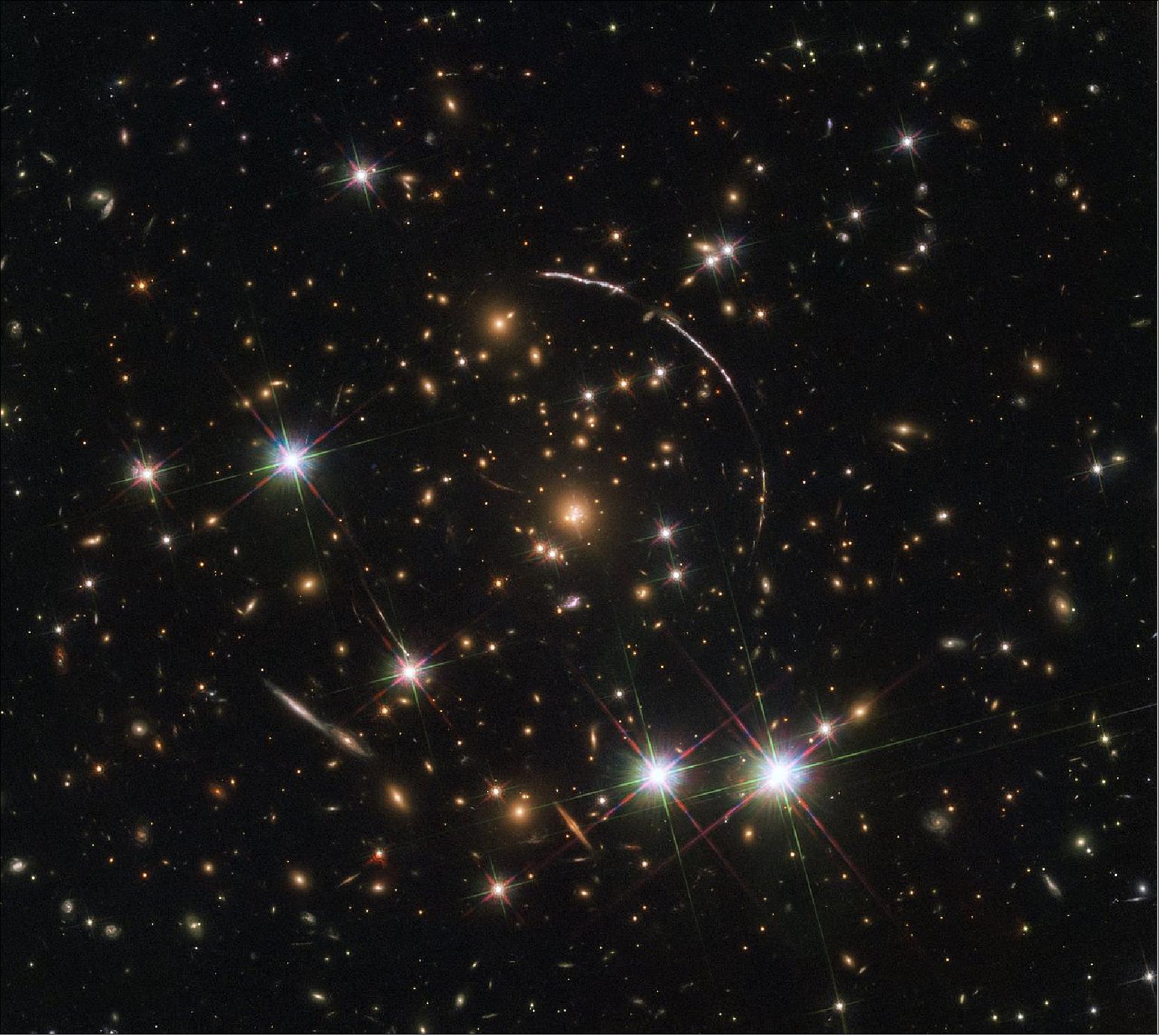
- The epoch of reionization was a key era in the early Universe, one which ended the “dark ages”, the epoch before the first stars were created when the Universe was dark and filled with neutral hydrogen [3].
Note [3]: Ionization is the process of gaining or losing electrons to leave electrically charged particles. The era is known as reionization because, after the Big Bang, matter formed first into protons and electrons. Then, during the era of recombination — about 380,000 years after the Big Bang — neutral hydrogen formed from these particles for the first time.
- Once the first stars formed, they started to radiate light, producing the high-energy photons required to ionize the neutral hydrogen [4].
Note [4]: While an ionized hydrogen atom consists of only the core of the atom (one proton) a neutral hydrogen atom contains a nucleus of one proton which is orbited by one electron.
- This converted the intergalactic matter into the mostly ionized form in which it exists today. However, to ionize intergalactic hydrogen, high-energy radiation from these early stars would have had to escape their host galaxies without first being absorbed by interstellar matter. So far only a small number of galaxies have been found to “leak” high-energy photons into deep space. How this light escaped from the early galaxies remains a mystery.
- The analysis of the Sunburst Arc helps astronomers to add another piece to the puzzle — it seems that at least some photons can leave the galaxy through narrow channels in a gas rich neutral medium. This is the first observation of a long-theorized process [5]. While this process is unlikely to be the main mechanism that led the Universe to become reionized, it may very well have provided a decisive push.
Note [5]: The paper outlining these observations will appear in Science on 8 November 2019.
• 01 November 2019: Merope is located just out of the frame at the top right (Figure 12). Light from the star is reflected from the surface of the cloud, which illuminates it to become what astronomers call a reflection nebula. The beams of light at the upper right from the star are an effect produced by the telescope but the eerie wisps of light from the lower left to upper right are real. 15)
- Astronomers believe that radiation pressure from the star is acting like a sieve to separate dust particles of different sizes. As the nebula approaches Merope, the starlight decelerates dust particles, but the small particles slow down more than the large particles. As an effect, the almost straight lines that are reaching out towards Merope in this view are made of large particles, whereas smaller-sized particles lag behind to create the wispy structure on the lower left.
- The nebula will continue its approach towards Merope over the next few thousand years and will eventually move past the star, if it survives. Studying the nebula's interaction with the star is important as it provides a chance to observe interstellar material in an unusual situation and learn more about interstellar dust.
- The nebula near Merope was discovered in 1890 by E. E. Barnard using the 36 inch telescope at the Lick Observatory in California. This image was captured by the NASA/ESA Hubble Space Telescope on 19 September 1999 and was originally published in 2000.
![Figure 12: This ghostly image shows what can happen when an interstellar cloud passes too close to a star. Barnard's Merope Nebula, also known as IC 349, is a cloud of interstellar gas and dust travelling through the Pleiades star cluster at a relative speed of 11 km/s. It is passing close to the star Merope, located 0.06 light years away from the cloud, which is equivalent to about 3 500 times the distance between the Earth and the Sun. This passage is disrupting the nebula and creating the wispy effect seen in the image [image credit: NASA/ESA and The Hubble Heritage Team (STScI/AURA), George Herbig and Theodore Simon (University of Hawaii)]](/api/cms/documents/163813/5502378/Hubble2019_Auto3F.jpeg)
• 28 October 2019: Although galaxy collisions are common — especially in the early universe — most are not head-on impacts like the collision that likely created this Arp-Madore system 704 million light-years from Earth. This violent encounter gives the system an arresting ring structure, but only for a short amount of time. The crash has pulled and stretched the galaxies’ discs of gas, dust, and stars outward, forming the ring of intense star formation that shapes the “nose” and “face” features of the system. 16) 17)
- Ring galaxies are rare, and only a few hundred of them reside in our larger cosmic neighborhood. The galaxies have to collide at just the right orientation so that they interact to create the ring, and before long they will have merged completely, hiding their messy past.
- The side-by-side juxtaposition of the two central bulges of stars from the galaxies that we see here is also unusual. Since the bulges that form the “eyes” appear to be the same size, we can be sure that the two galaxies involved in the crash were of equal size. This is different from the more common collisions in which small galaxies are gobbled up by their larger neighbors.
- This galaxy system is catalogued as Arp-Madore 2026-424 (AM 2026-424) in the Arp-Madore “Catalog of Southern Peculiar Galaxies and Associations”. Astronomer Halton Arp published his compendium of 338 unusual-looking interacting galaxies in 1966. He later partnered with astronomer Barry Madore to extend the search for unique galactic encounters in the southern sky. Several thousand galaxies are listed in this 1987 survey.
- Hubble observed this unique system as part of a “snapshot” program that takes advantage of occasional gaps in the telescope’s observing schedule to squeeze in additional pictures. Astronomers plan to use this innovative Hubble program to take a close look at many other unusual interacting galaxies. The goal is to compile a robust sample of nearby interacting galaxies, which could offer insights into how galaxies grew over time through galactic mergers. By analyzing these detailed Hubble observations, astronomers will be able to decide which systems are prime targets for follow-up observations by the upcoming NASA/ESA/CSA James Webb Space Telescope, scheduled to launch in 2021.
![Figure 13: In celebration of Halloween, this new image from the NASA/ESA Hubble Space Telescope captures two galaxies of equal size in a collision that appears to resemble a ghostly face. This observation was made on 19 June 2019 in visible light by the telescope’s ACS (Advanced Camera for Surveys). This system is catalogued as Arp-Madore 2026-424 (AM 2026-424) in the Arp-Madore “Catalog of Southern Peculiar Galaxies and Associations”[image credit: NASA, ESA, J. Dalcanton, B. F. Williams, and M. Durbin (University of Washington)]](/api/cms/documents/163813/5502378/Hubble2019_Auto3E.jpeg)
• 25 October 2019: This galaxy's whirling arms tells us a story about what’s happening inside this galaxy. Stars are generally brighter and bluer when they are younger, so the blue patches mark sites of new star formation. Studying the structures of other galaxies is a key way to learn about the structure of our own, given that humans can’t leave the Milky Way to look back and see what it looks like from the outside. It helps to compare our observations of our home galaxy with those of nearby galaxies we can see in their entirety. 18)
![Figure 14: This image from the NASA/ESA Hubble Space Telescope shows IC 4653, a galaxy just above 80 million light-years from Earth. That may sound like quite a distance, but it’s not that far on a cosmic scale. At these kinds of distances, the types and structures of the objects we see are similar to those in our local area [image credit: ESA/Hubble & NASA, D. Rosario (CEA, Durham University) (CC BY 4.0)]](/api/cms/documents/163813/5502378/Hubble2019_Auto3D.jpeg)
• 18 October 2019: The galaxy NGC 4380 looks like a special effect straight out of a science fiction or fantasy film in this Hubble Picture of the Week, swirling like a gaping portal to another dimension. 19)
- In the grand scheme of things, though, the galaxy is actually quite ordinary. Spiral galaxies like NGC 4380 are one of the most common types of galaxy in the Universe. These colossal collections of stars, often numbering in the hundreds of billions, are shaped like a flat disc, sometimes with a rounded bulge in the center. Graceful spiral arms outlined by dark lanes of dust wind around the bulging core, which glows brightly and has the highest concentration of stars in the galaxy.
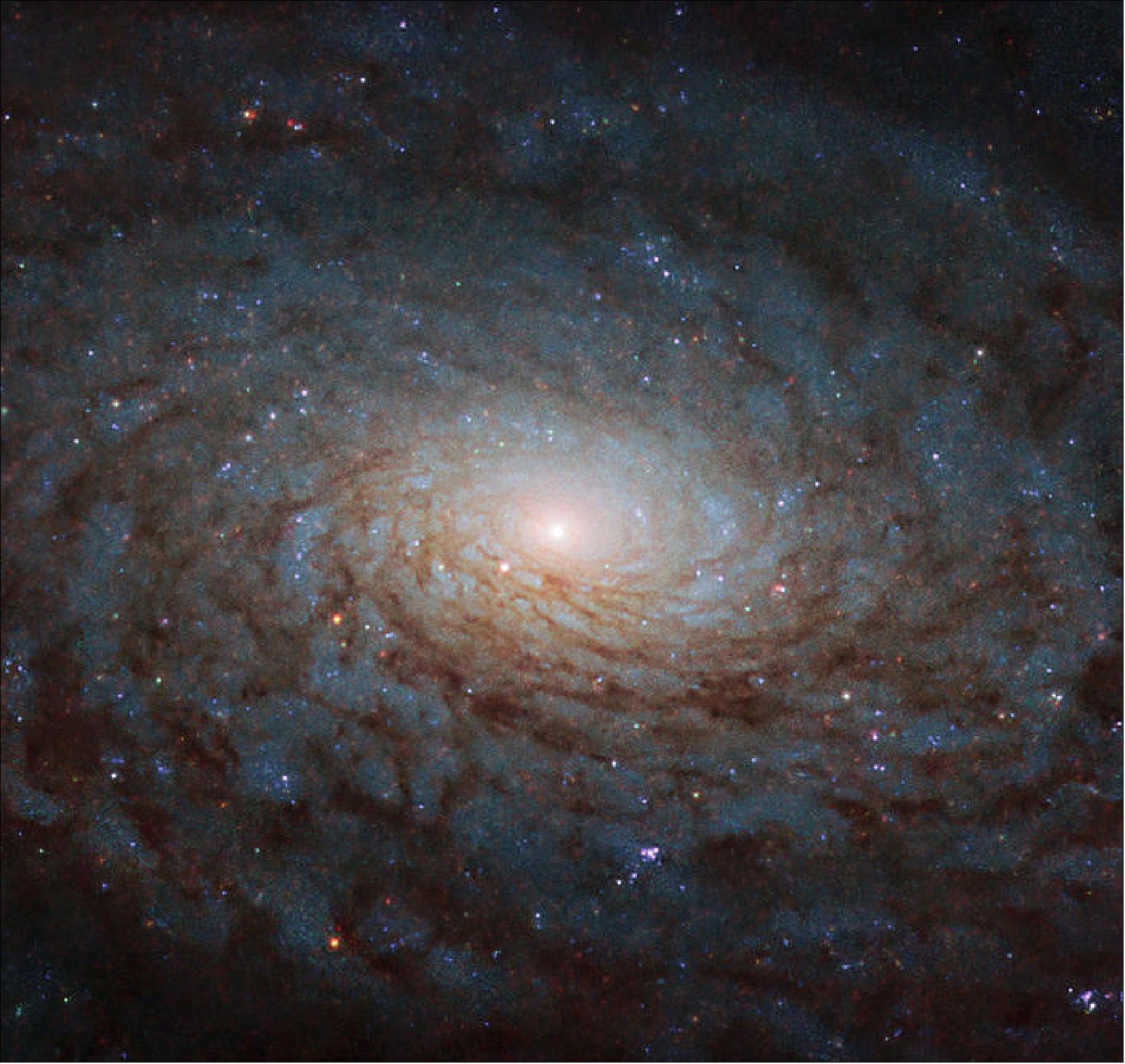
• 17 October 2019: You’ve probably never noticed it, but our solar system is moving along at quite a clip. Stars in the outer reaches of the Milky Way, including our Sun, orbit at an average speed of 130 miles per second (210 km/s). But that’s nothing compared to the most massive spiral galaxies. “Super spirals,” which are larger, brighter, and more massive than the Milky Way, spin even faster than expected for their mass, at speeds up to 350 miles per second (570 km/s). 20)
![Figure 16: The top row of this mosaic features Hubble images of three spiral galaxies, each of which with a mass several times as much as the Milky Way. The bottom row shows three even more massive spiral galaxies that qualify as “super spirals,” which were observed by the ground-based Sloan Digital Sky Survey. Super spirals typically have 10 to 20 times the mass of the Milky Way. The galaxy at lower right, 2MFGC 08638, is the most massive super spiral known to date, with a dark matter halo with a mass of at least 40 trillion Suns. — Astronomers have measured the rotation rates in the outer reaches of these spirals to determine how much dark matter they contain. They found that the super spirals tend to rotate much faster than expected for their stellar masses, making them outliers. Their speed may be due to the influence of a surrounding dark matter halo, the largest of which contains the mass of at least 40 trillion suns [image credit: NASA, ESA, P. Ogle and J. DePasquale (STScI ). Bottom row: SDSS, P. Ogle and J. DePasquale (STScI)]](/api/cms/documents/163813/5502378/Hubble2019_Auto3B.jpeg)
- Super spirals are exceptional in almost every way. In addition to being much more massive than the Milky Way, they’re also brighter and larger in physical size. The largest span 450,000 light-years compared to the Milky Way’s 100,000-light-year diameter. Only about 100 super spirals are known to date. Super spirals were discovered as an important new class of galaxies while studying data from the Sloan Digital Sky Survey (SDSS) as well as the NASA/IPAC Extragalactic Database (NED).
- “Super spirals are extreme by many measures,” says Patrick Ogle of the STSI (Space Telescope Science Institute) in Baltimore, Maryland. “They break the records for rotation speeds.”
- Ogle is first author of a paper that was published October 10, 2019 in the Astrophysical Journal Letters. The paper presents new data on the rotation rates of super spirals collected with the Southern African Large Telescope (SALT), the largest single optical telescope in the southern hemisphere. Additional data were obtained using the 5-meter Hale telescope of the Palomar Observatory, operated by the California Institute of Technology. Data from NASA’s Wide-field Infrared Survey Explorer (WISE) mission was crucial for measuring the galaxy masses in stars and star formation rates.
- Referring to the new study, Tom Jarrett of the University of Cape Town, South Africa says, “This work beautifully illustrates the powerful synergy between optical and infrared observations of galaxies, revealing stellar motions with SDSS and SALT spectroscopy, and other stellar properties — notably the stellar mass or ‘backbone’ of the host galaxies — through the WISE mid-infrared imaging."
- Theory suggests that super spirals spin rapidly because they are located within incredibly large clouds, or halos, of dark matter. Dark matter has been linked to galaxy rotation for decades. Astronomer Vera Rubin pioneered work on galaxy rotation rates, showing that spiral galaxies rotate faster than if their gravity were solely due to the constituent stars and gas. An additional, invisible substance known as dark matter must influence galaxy rotation. A spiral galaxy of a given mass in stars is expected to rotate at a certain speed. Ogle’s team finds that super spirals significantly exceed the expected rotation rate.
- Super spirals also reside in larger than average dark matter halos. The most massive halo that Ogle measured contains enough dark matter to weigh at least 40 trillion times as much as our Sun. That amount of dark matter would normally contain a group of galaxies rather than a single galaxy.
- “It appears that the spin of a galaxy is set by the mass of its dark matter halo,” Ogle explains.
- The fact that super spirals break the usual relationship between galaxy mass in stars and rotation rate is a new piece of evidence against an alternative theory of gravity known as MOND (Modified Newtonian Dynamics). MOND proposes that on the largest scales like galaxies and galaxy clusters, gravity is slightly stronger than would be predicted by Newton or Einstein. This would cause the outer regions of a spiral galaxy, for example, to spin faster than otherwise expected based on its mass in stars. MOND is designed to reproduce the standard relationship in spiral rotation rates, therefore it cannot explain outliers like super spirals. The super spiral observations suggest no non-Newtonian dynamics is required.
- Despite being the most massive spiral galaxies in the universe, super spirals are actually underweight in stars compared to what would be expected for the amount of dark matter they contain. This suggests that the sheer amount of dark matter inhibits star formation. There are two possible causes: 1) Any additional gas that is pulled into the galaxy crashes together and heats up, preventing it from cooling down and forming stars, or 2) The fast spin of the galaxy makes it harder for gas clouds to collapse against the influence of centrifugal force.
- “This is the first time we’ve found spiral galaxies that are as big as they can ever get,” Ogle says.
- Despite these disruptive influences, super spirals are still able to form stars. Although the largest elliptical galaxies formed all or most of their stars more than 10 billion years ago, super spirals are still forming stars today. They convert about 30 times the mass of the Sun into stars every year, which is normal for a galaxy of that size. By comparison, our Milky Way forms about one solar mass of stars per year.
- Ogle and his team have proposed additional observations to help answer key questions about super spirals, including observations designed to better study the motion of gas and stars within their disks. After its 2021 launch, NASA’s James Webb Space Telescope could study super spirals at greater distances and correspondingly younger ages to learn how they evolve over time. And NASA’s WFIRST mission may help locate more super spirals, which are exceedingly rare, thanks to its large field of view.
- The Space Telescope Science Institute is expanding the frontiers of space astronomy by hosting the science operations center of the Hubble Space Telescope, the science and operations center for the James Webb Space Telescope, and the science operations center for the future Wide Field Infrared Survey Telescope (WFIRST). STScI also houses the Mikulski Archive for Space Telescopes (MAST) which is a NASA-funded project to support and provide to the astronomical community a variety of astronomical data archives, and is the data repository for the Hubble, Webb, Kepler, K2, TESS missions and more.
• 14 October 2019: When astronomers use the NASA/ESA Hubble Space Telescope to study the deep sky, asteroids from our Solar System can leave their marks on the captured pictures of far-away galaxies or nebulae. But rather than be annoyed at the imprinted trails in Hubble images, astronomers realized they could use them to find out more about the asteroids themselves. 21)
- To do this, a team of ESA astronomers and software engineers started the Hubble Asteroid Hunter citizen science project in June, enlisting the public to help them find asteroids observed by chance in Hubble archival images. Through this project, over 1900 volunteers have identified more than 300,000 asteroid trails in nearly 11,000 images in only 1.5 months, completing the project with swiftness and enthusiasm that exceeded the team’s expectations.
- Astronomy-enthusiast Melina Thévenot from Germany was one of the project’s keen volunteers. While analyzing Hubble data, she found an asteroid trail on the foreground of a 2005 image of the Crab Nebula, one of the night sky's most famous objects.
- Inspired by this impressive combination, Melina decided to process the original Hubble image combining views taken in blue, green and red filters, to create the stunning color scene portrayed here. The faint trail of 2001 SE101, a main-belt asteroid discovered by the ground-based LINEAR survey in 2001, appears as a curved streak that crosses the image from bottom left to top right, near the nebula’s center.
- The Crab Nebula, also known as Messier 1 or M1, was the first object recorded by French astronomer Charles Messier in his famous catalogue of deep-sky objects. It is the expanding remnant of a bright supernova explosion observed by astronomers in 1054. Aside from the swirling cloud of gas and dust, the explosion left behind a rapidly rotating neutron star at the center of the nebula, also visible in this image as the leftmost star in the bright pair at the center of the picture.
- While the chance alignment of a relatively nearby object – the asteroid – with the distant nebula is fascinating, it is not completely unexpected. In fact, the Crab Nebula, which has been observed by Hubble on nearly 300 occasions, fortuitously lies close to the ecliptic – the orbital plane where most asteroids reside in the Solar System – so it was only a matter of time before one of them ‘photobombed’ an observation of this iconic supernova remnant.
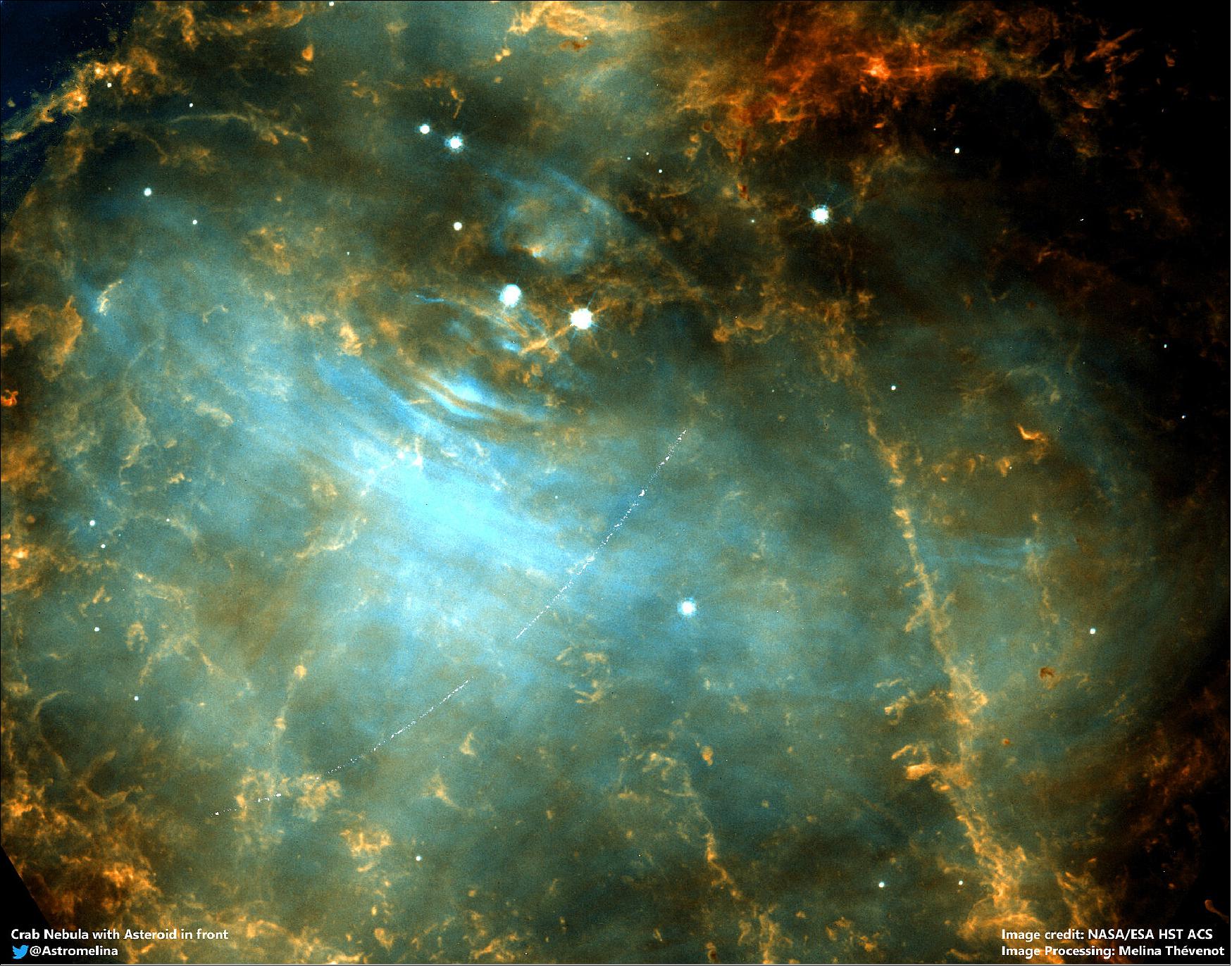
- Now that volunteers have perused the platform to spot and mark asteroid trails, it is astronomers’ turn to get to work. Knowing the date and time when the Hubble images were taken, they can use the trails marked in the pictures to infer asteroids’ positions and velocities. This means they can determine the orbits and future trajectories of known and previously unknown asteroids with greater precision than before.
- This knowledge is especially important for near-Earth objects: precisely determining the orbits of these asteroids can help protect our planet from possible impacts.
- Meanwhile, the ESA team is planning to add new data to the Hubble Asteroid Hunter project soon, so users will have another chance to inspect Hubble images in search of passing asteroids. Stay tuned!
- This stunning scene and the Hubble Asteroid Hunter project were made possible thanks to Zooniverse, the world’s largest citizen-science platform. The project was initiated by ESA research fellow Sandor Kruk, graduate student Max Mahlke, software engineers Elena Racero and Fabrizio Giordano from the ESAC Science Data Center (ESDC) near Madrid, Spain, and Bruno Merín, head of the ESDC.
• 16 October 2019: NASA's Hubble Space Telescope has given astronomers their best look yet at an interstellar visitor — comet 2I/Borisov — whose speed and trajectory indicate it has come from beyond our solar system. 22)
- Comet 2I/Borisov is only the second such interstellar object known to have passed through the solar system. In 2017, the first identified interstellar visitor, an object officially named 'Oumuamua, swung within 24 million miles of the Sun before racing out of the solar system. "Whereas 'Oumuamua appeared to be a rock, Borisov is really active, more like a normal comet. It's a puzzle why these two are so different," said David Jewitt of the University of California, Los Angeles (UCLA), leader of the Hubble team who observed the comet.
- As the second known interstellar object found to enter our solar system, the comet provides invaluable clues to the chemical composition, structure and dust characteristics of planetary building blocks presumably forged in an alien star system a long time ago and far away.
- "Though another star system could be quite different from our own, the fact that the comet's properties appear to be very similar to those of the solar system's building blocks is very remarkable," said Amaya Moro-Martin of the Space Telescope Science Institute in Baltimore.
- Hubble photographed the comet at a distance of 260 million miles from Earth. The comet is falling past the Sun and will make its closest approach to the Sun on Dec. 7, 2019, when it will be twice as far from the Sun as Earth.
- The comet is following a hyperbolic path around the Sun, and currently is blazing along at an extraordinary speed of 110,000 miles per hour. "It's traveling so fast it almost doesn't care that the Sun is there," said Jewitt.
- By the middle of 2020 the comet will streak past Jupiter's distance of 500 million miles on its way back into interstellar space where it will drift for untold millions of years before skirting close to another star system.
![Figure 19: This is a time-lapse sequence compressing Hubble Space Telescope observations of comet 2I/Borisov, spanning a seven-hour period. As the second known interstellar object to enter our solar system, the comet is moving along at a breakneck speed of 110,000 miles per hour. To photograph the comet Hubble has to track it, like a photographer tracking a racetrack horse. Therefore, background stars are streaked in the exposure frames. An artificial satellite also crosses the field of view. Hubble reveals a central concentration of dust around an unseen nucleus [image credit: NASA, ESA and J. DePasquale (STScI)]](/api/cms/documents/163813/5502378/HubbleBorisov2019.gif)
- Crimean amateur astronomer Gennady Borisov discovered the comet on Aug. 30, 2019. After a week of observations by amateur and professional astronomers all over the world, the International Astronomical Union's Minor Planet Center and the Center for Near-Earth Object Studies at NASA's Jet Propulsion Laboratory in Pasadena, California, computed a trajectory for the comet, which confirms that it came from interstellar space.
- Until now, all cataloged comets have come from either a ring of icy debris at the periphery of our solar system, called the Kuiper belt, or the hypothetical Oort cloud, a shell of comets about a light-year from the Sun, defining the dynamical edge of our solar system.
- Borisov and 'Oumuamua are only the beginning of the discoveries of interstellar objects paying a brief visit to our solar system, say researchers. According to one study there are thousands of such interlopers here at any given time, though most are too faint to be detected with current-day telescopes.
- Observations by Hubble and other telescopes have shown that rings and shells of icy debris encircle young stars where planet formation is underway. A gravitational "pinball game" between these comet-like bodies or planets orbiting other stars can hurtle them deep into space where they go adrift among the stars.
- Future Hubble observations of 2I/Borisov are planned through January 2020, with more being proposed.
- "New comets are always unpredictable," said Max Mutchler, another member of the observing team. "They sometimes brighten suddenly or even begin to fragment as they are exposed to the intense heat of the Sun for the first time. Hubble is poised to monitor whatever happens next with its superior sensitivity and resolution."
• 11 October 2019: The NASA/ESA Hubble Space Telescope sees galaxies of all shapes, sizes, brightnesses, and orientations in the cosmos. Sometimes, the telescope gazes at a galaxy oriented sideways — as shown here. The spiral galaxy featured in this Picture of the Week is called NGC 3717, and it is located about 60 million light-years away in the constellation of Hydra (The Sea Serpent). 23)
- NGC 3717 is not captured perfectly edge-on in this image; the nearer part of the galaxy is tilted ever so slightly down, and the far side tilted up. This angle affords a view across the disc and the central bulge (of which only one side is visible).
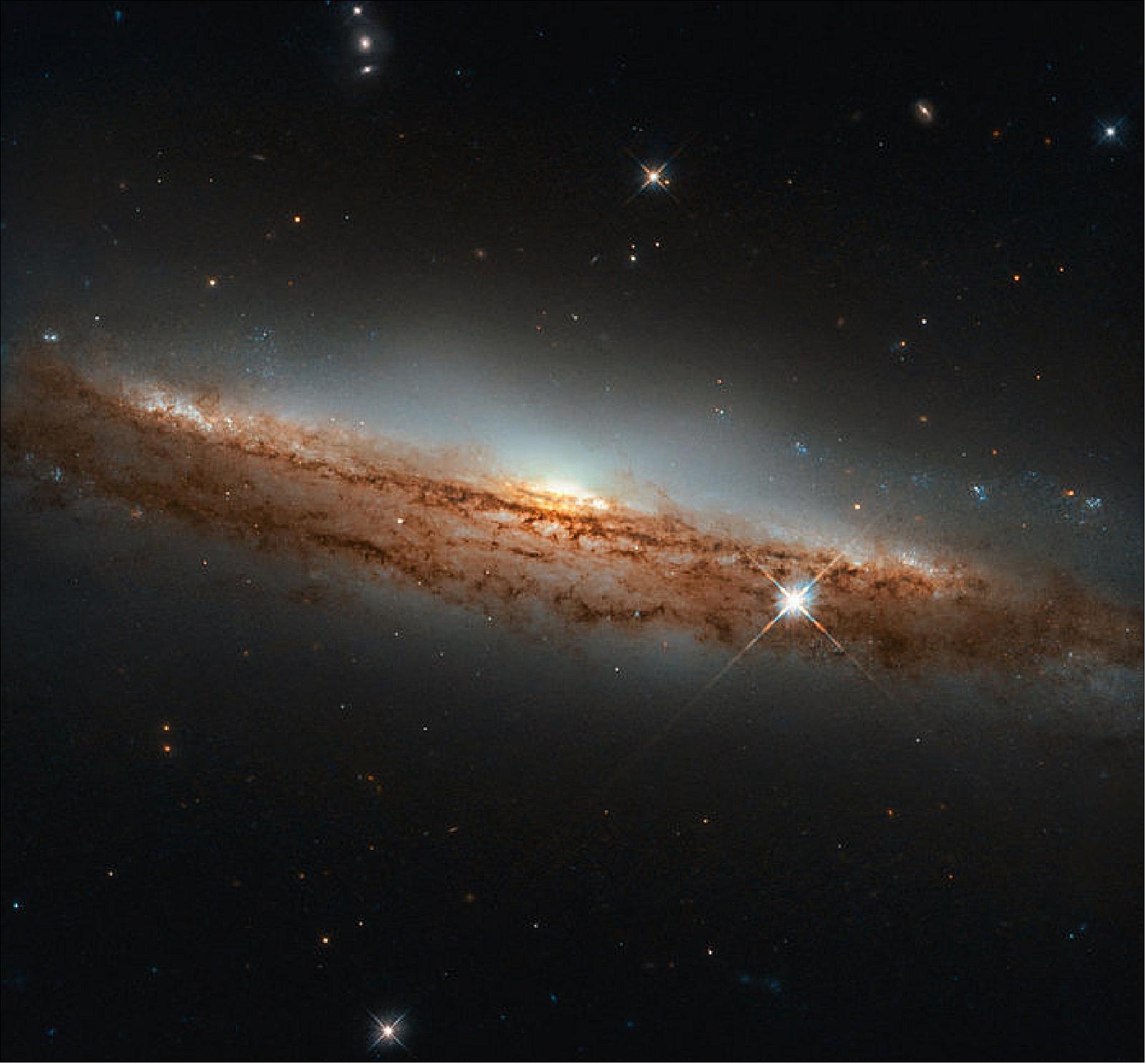
• 04 October 2019: Often referred to by its somewhat drier New General Catalogue designation of NGC 4194, this was not always one entity, but two. An early galaxy consumed a smaller gas-rich system, throwing out streams of stars and dust out into space. These streams, seen rising from the top of the merger galaxy, resembles the writhing snakes that Medusa, a monster in ancient Greek mythology, famously had on her head in place of hair, lending the object its intriguing name. 24)
- The legend of Medusa also held that anyone who saw her face would transform into stone. In this case, you can feast your eyes without fear on the center of the merging galaxies, a region known as Medusa's eye. All the cool gas pooling here has triggered a burst of star formation, causing it to stand out brightly against the dark cosmic backdrop.
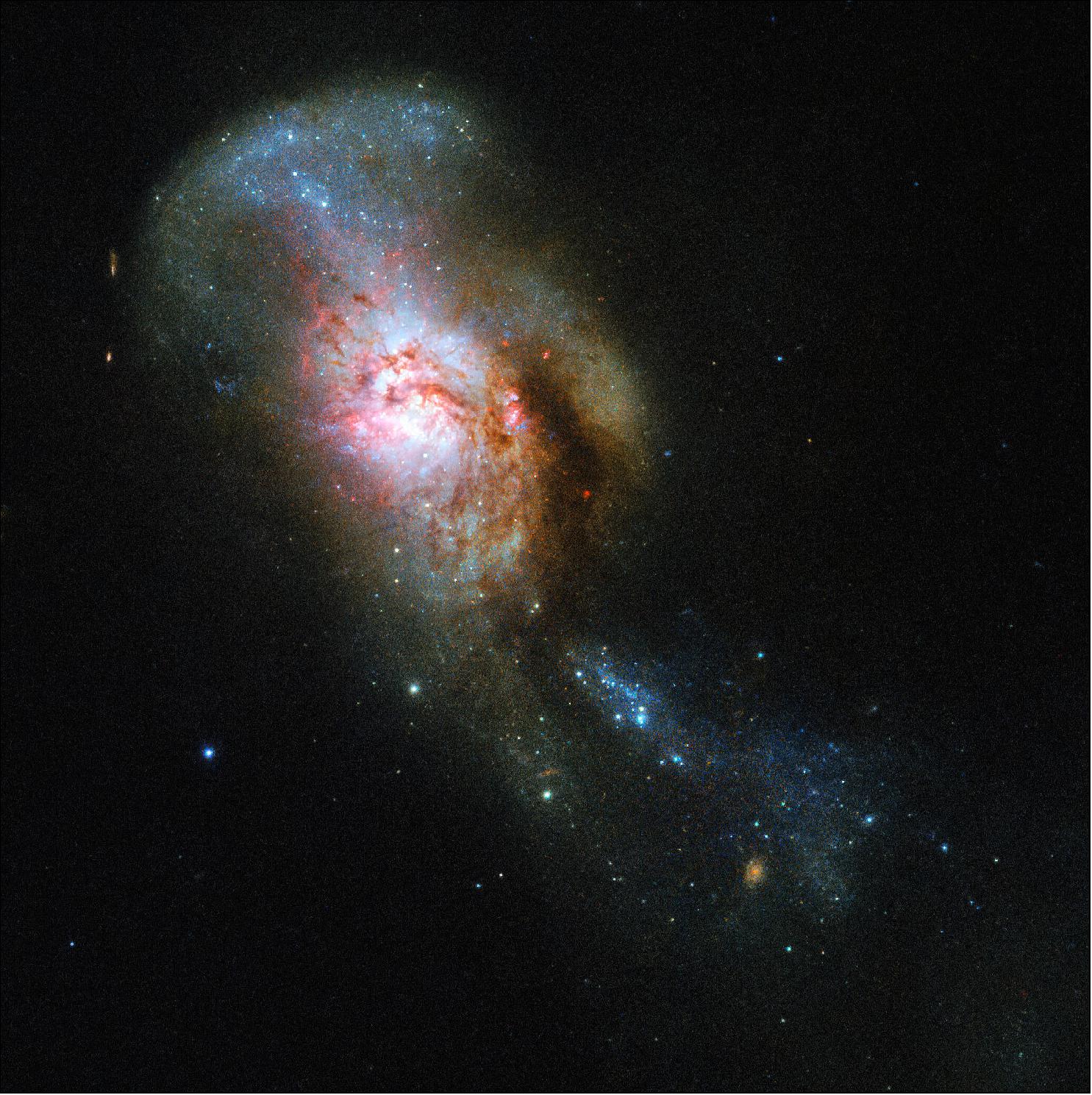
• 23 September 2019: Messier 86 is part of the Virgo Cluster of galaxies and is situated about 50 million light-years from Earth. The galaxy is moving through space remarkably quickly — its current trajectory is bringing it in our direction, back towards the center of its cluster from the far side, at the incredible speed of over 875,000 km/hr! Because of the speed with which it is moving through the cluster, Messier 86 is undergoing a process known as ram-pressure stripping; the resistive material filling the gaps between individual cluster galaxies is pulling at the gas and dust in Messier 86 and stripping them out as the galaxy moves, creating a long trail of hot gas that is emitting X-ray radiation. 25) 26)
- Astronomers are using Hubble observations such as this to study elliptical and lenticular galaxies, both of which are often found at the centers of galaxy clusters. By studying the cores of these galaxies, astronomers hope to determine details of the central structure and to analyze both the history of the galaxy and the formation of its core.
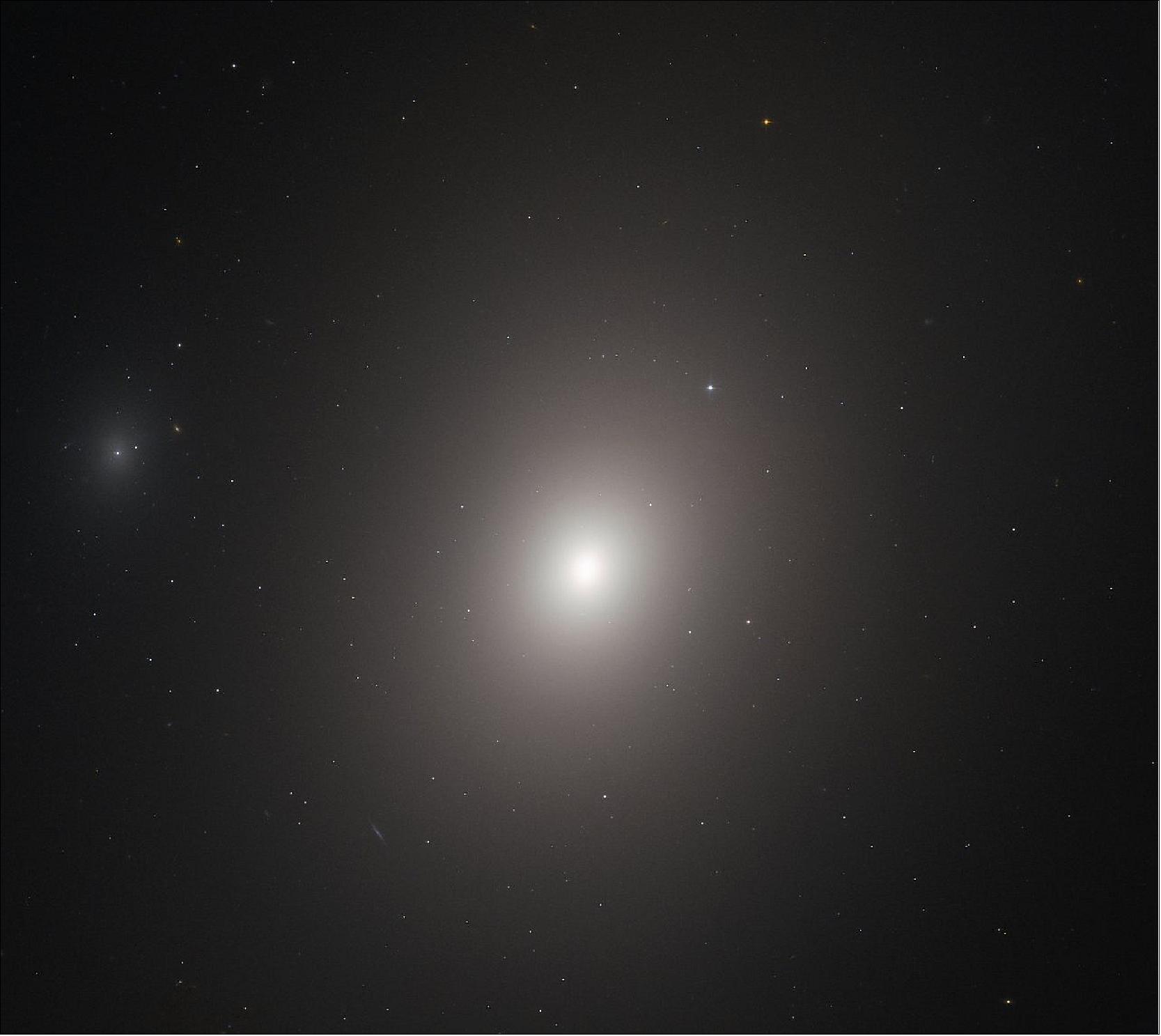
• 20 September 2019: Many of the best-loved galaxies in the cosmos are remarkably large, close, massive, bright, or beautiful, often with an unusual or intriguing structure or history. However, it takes all kinds to make a Universe — as demonstrated by this Hubble Picture of the Week of Messier 110. 27) 28)
- Messier 110 may not look like much, but it is a fascinating near neighbor of our home galaxy, and an unusual example of its type. It is a member of the Local Group, a gathering of galaxies comprising the Milky Way and a number of the galaxies closest to it. Specifically, Messier 110 is one of the many satellite galaxies encircling the Andromeda Galaxy, the nearest major galaxy to our own, and is classified as a dwarf elliptical galaxy, meaning that it has a smooth and almost featureless structure. Elliptical galaxies lack arms and notable pockets of star formation — both characteristic features of spiral galaxies. Dwarf ellipticals are quite common in groups and clusters of galaxies, and are often satellites of larger galaxies.
- Because they lack stellar nurseries and contain mostly old stars, elliptical galaxies are often considered ‘dead’ when compared to their spiral relatives. However, astronomers have spotted signs of a population of young, blue stars at the center of Messier 110 — hinting that it may not be so dead after all.
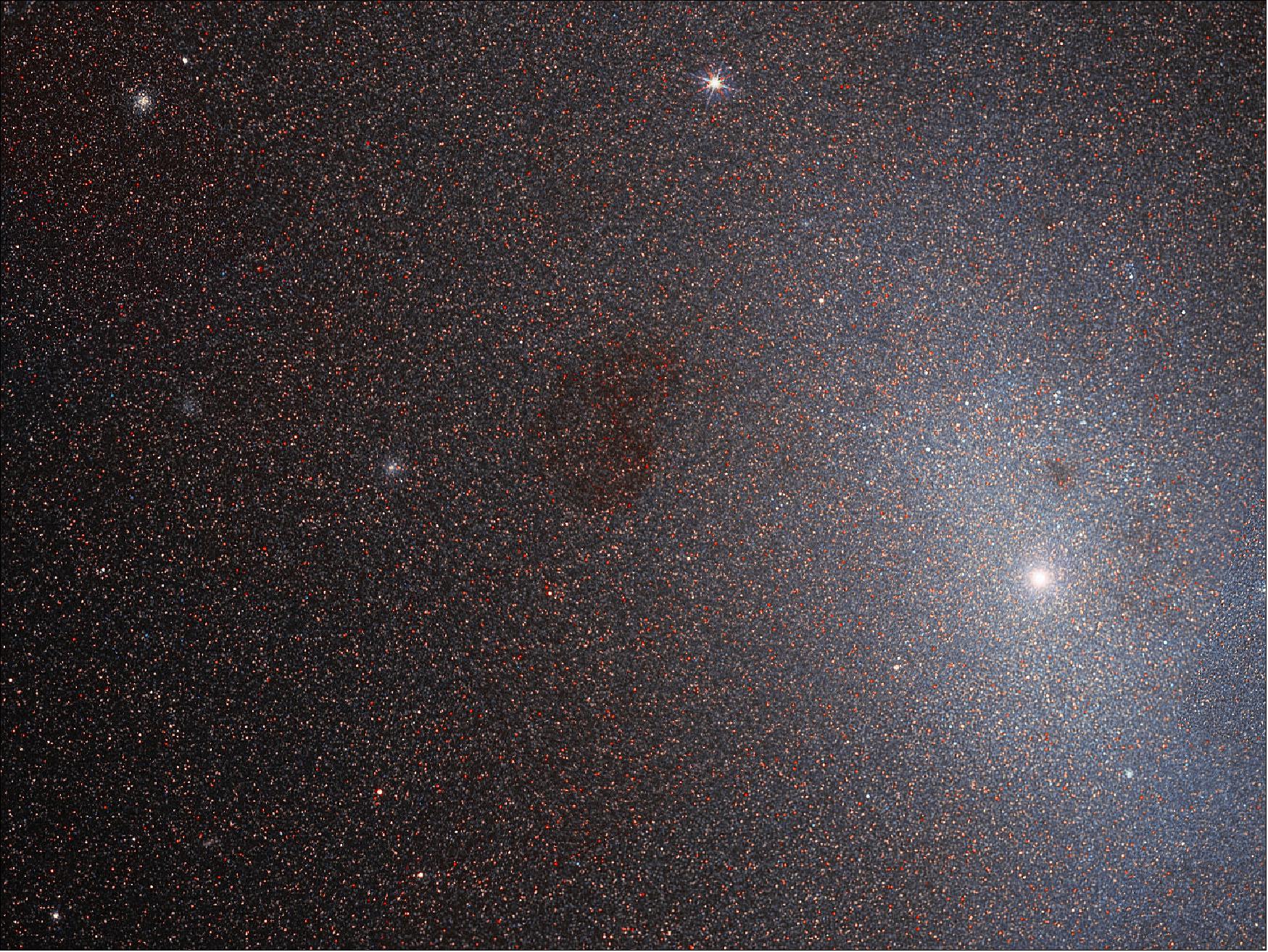
• 12 September 2019: Saturn is so beautiful that astronomers cannot resist using the Hubble Space Telescope to take yearly snapshots of the ringed world when it is at its closest distance to Earth. 29)
- These images, however, are more than just beauty shots. They reveal a planet with a turbulent, dynamic atmosphere. This year's Hubble offering, for example, shows that a large storm visible in the 2018 Hubble image in the north polar region has vanished. Smaller storms pop into view like popcorn kernels popping in a microwave oven before disappearing just as quickly. Even the planet's banded structure reveals subtle changes in color.
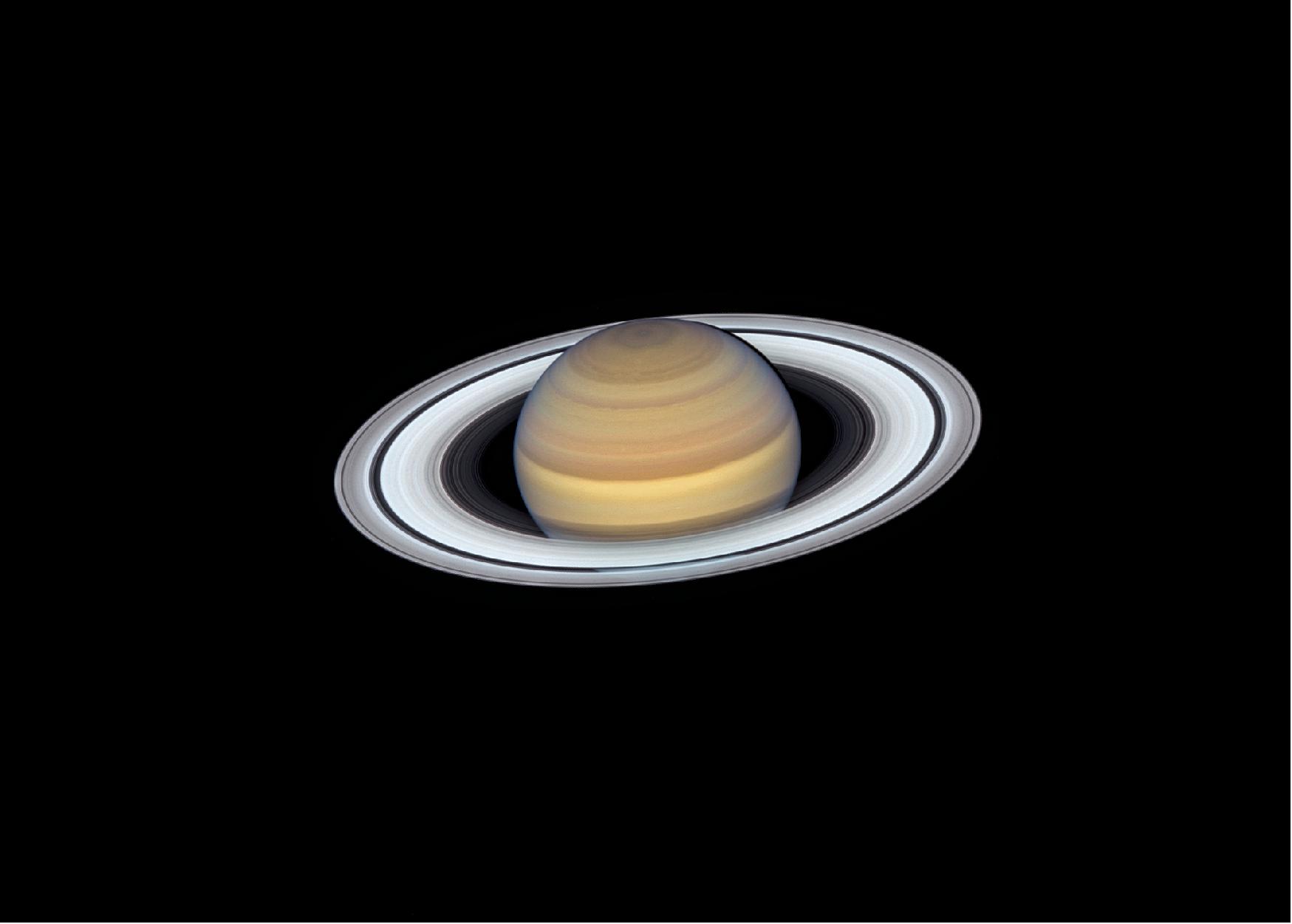
- But the latest image shows plenty that hasn't changed. The mysterious six-sided pattern, called the "hexagon," still exists on the north pole. Caused by a high-speed jet stream, the hexagon was first discovered in 1981 by NASA's Voyager 1 spacecraft.
- Saturn's signature rings are still as stunning as ever. The image reveals that the ring system is tilted toward Earth, giving viewers a magnificent look at the bright, icy structure. Hubble resolves numerous ringlets and the fainter inner rings.
- This image reveals an unprecedented clarity only seen previously in snapshots taken by NASA spacecraft visiting the distant planet. Astronomers will continue their yearly monitoring of the planet to track shifting weather patterns and identify other changes. The second in the yearly series, this image is part of the Outer Planets Atmospheres Legacy (OPAL) project. OPAL is helping scientists understand the atmospheric dynamics and evolution of our solar system's gas giant planets.
• 11 September 2019: With data from the NASA/ESA Hubble Space Telescope, water vapor has been detected in the atmosphere of a super-Earth within the habitable zone by UCL (University College London) researchers in a world first. K2-18b, which is eight times the mass of Earth, is now the only planet orbiting a star outside the Solar System, or exoplanet, known to have both water and temperatures that could support life. 30) 31)
- The UCL team used archive data from 2016 and 2017 captured by the NASA/ESA Hubble Space Telescope and developed open-source algorithms to analyze the starlight filtered through K2-18b's atmosphere. 32) The results revealed the molecular signature of water vapor, also indicating the presence of hydrogen and helium in the planet's atmosphere.
- The discovery, published today in Nature Astronomy, is the first successful atmospheric detection of an exoplanet orbiting in its star's habitable zone, at a distance where water can exist in liquid form. 33)
- The authors believe that other molecules, including nitrogen and methane, may be present but they remain undetectable with current observations. Further studies are required to estimate cloud coverage and the percentage of atmospheric water present.
- The planet orbits the cool dwarf star K2-18, which is 110 light years from Earth in the constellation of Leo. Given the high level of activity of its red dwarf star, K2-18b may be more hostile than Earth and is likely to be exposed to more radiation.
- K2-18b was discovered in 2015 and is one of hundreds of super-Earths – planets with masses between those of Earth and Neptune – found by NASA's Kepler spacecraft. NASA's TESS mission is expected to detect hundreds more super-Earths in the coming years.
- Co-author Ingo Waldmann (UCL CSED), said: "With so many new super-Earths expected to be found over the next couple of decades, it is likely that this is the first discovery of many potentially habitable planets. This is not only because super-Earths like K2-18b are the most common planets in our Milky Way, but also because red dwarfs – stars smaller than our Sun – are the most common stars."
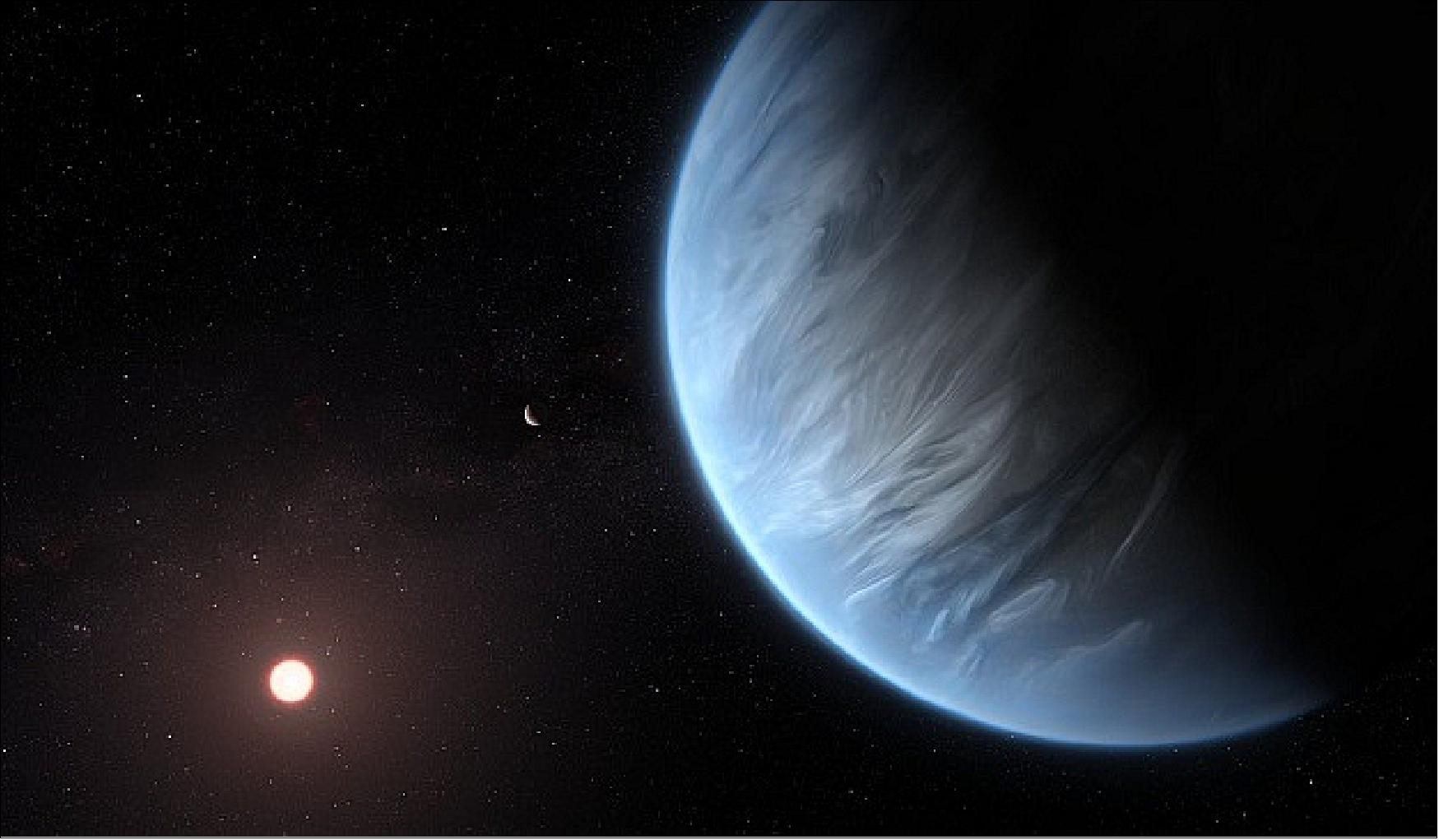
- The next generation of space telescopes, including the NASA/ESA/CSA James Webb Space Telescope and ESA's ARIEL mission, will be able to characterize atmospheres in more detail as they will carry more advanced instruments. ARIEL is expected to launch in 2028 and will observe 1000 planets in detail to get a truly representative picture of what they are like.
- Professor Giovanna Tinetti (UCL CSED), co-author and Principal Investigator for ARIEL, said: "Our discovery makes K2-18b one of the most interesting targets for future study. Over 4000 exoplanets have been detected but we don't know much about their composition and nature. By observing a large sample of planets, we hope to reveal secrets about their chemistry, formation and evolution."
- "This study contributes to our understanding of habitable worlds beyond our Solar System and marks a new era in exoplanet research, crucial to ultimately placing the Earth, our only home, into the greater picture of the Cosmos," said Angelos Tsiaras.
• 09 September 2019: Previous research on the formation and evolution of star clusters has suggested that these systems tend to be compact and dense when they form, before expanding with time to become clusters of both small and large sizes. New Hubble observations in the Large Magellanic Cloud (LMC) galaxy have increased our understanding of how the size of star clusters in the LMC changes with time[1]. 34)
Note [1]: The observations were achieved from a set of long exposures acquired with the NASA/ESA Hubble Space Telescope’s Wide Field Camera 3 (WFC3) and Advanced Camera for Surveys (ACS) for five old star clusters in the Large Magellanic Cloud galaxy, secured under proposal 14164 (PI: Sarajedini).
- Star clusters are aggregates of many (up to one million) stars. They are active systems in which the mutual gravitational interactions among the stars change their structure over time (known to astronomers as "dynamical evolution"). Because of such interactions, heavy stars tend to progressively sink towards the central region of a star cluster, while low-mass stars can escape from the system. This causes a progressive contraction of the cluster core over different timescales and means that star clusters with the same chronological age can vary greatly in appearance and shape because of their different “dynamical ages”.
- Located nearly 160,000 light-years from Earth, the LMC is a satellite galaxy of the Milky Way which hosts star clusters covering a wide range of ages. This differs from our own Milky Way galaxy which primarily contains older star clusters. The distribution of sizes as a function of age observed for star clusters in the LMC is very puzzling, as the young clusters are all compact, while the oldest systems have both small and large sizes.
- All star clusters, including those in the LMC, have been found to host a special type of re-invigorated stars called blue stragglers [2]. Under certain circumstances, stars receive extra fuel that bulks them up and substantially brightens them. This can happen if one star pulls matter off a neighbor, or if they collide.
Note [2]: Blue stragglers are so called because of their blue color, and the fact that their evolution lags behind that of their neighbors.
- As a result of dynamical aging, heavier stars sink towards the center of a cluster as the cluster ages, in a process similar to sedimentation, called “central segregation”. Blue stragglers are bright, making them relatively easy to observe, and they have high masses, which means that they are affected by central segregation and can be used to estimate the dynamical age of a star cluster [3].
Note [3]: Blue stragglers combine being relatively bright and having high mass by the standards of globular cluster stars, but they are not the only stars within these clusters that are either bright or massive.
- Francesco Ferraro of the University of Bologna in Italy and his team used the Hubble Space Telescope to observe blue stragglers in five (coeval) old LMC star clusters with different sizes and succeeded in ranking them in terms of their dynamical age. 35)
- “We demonstrated that different structures of star clusters are due to different levels of dynamical ageing: they are in different physical shape despite the fact that they were born at the same cosmic time. This is the first time that the effect of dynamical ageing has been measured in the LMC clusters” says Ferraro.
- “These findings present intriguing areas for further research, since they reveal a novel and valuable way of reading the observed patterns of LMC star clusters, providing new hints about the cluster formation history in the LMC galaxy,” adds co-author Barbara Lanzoni.
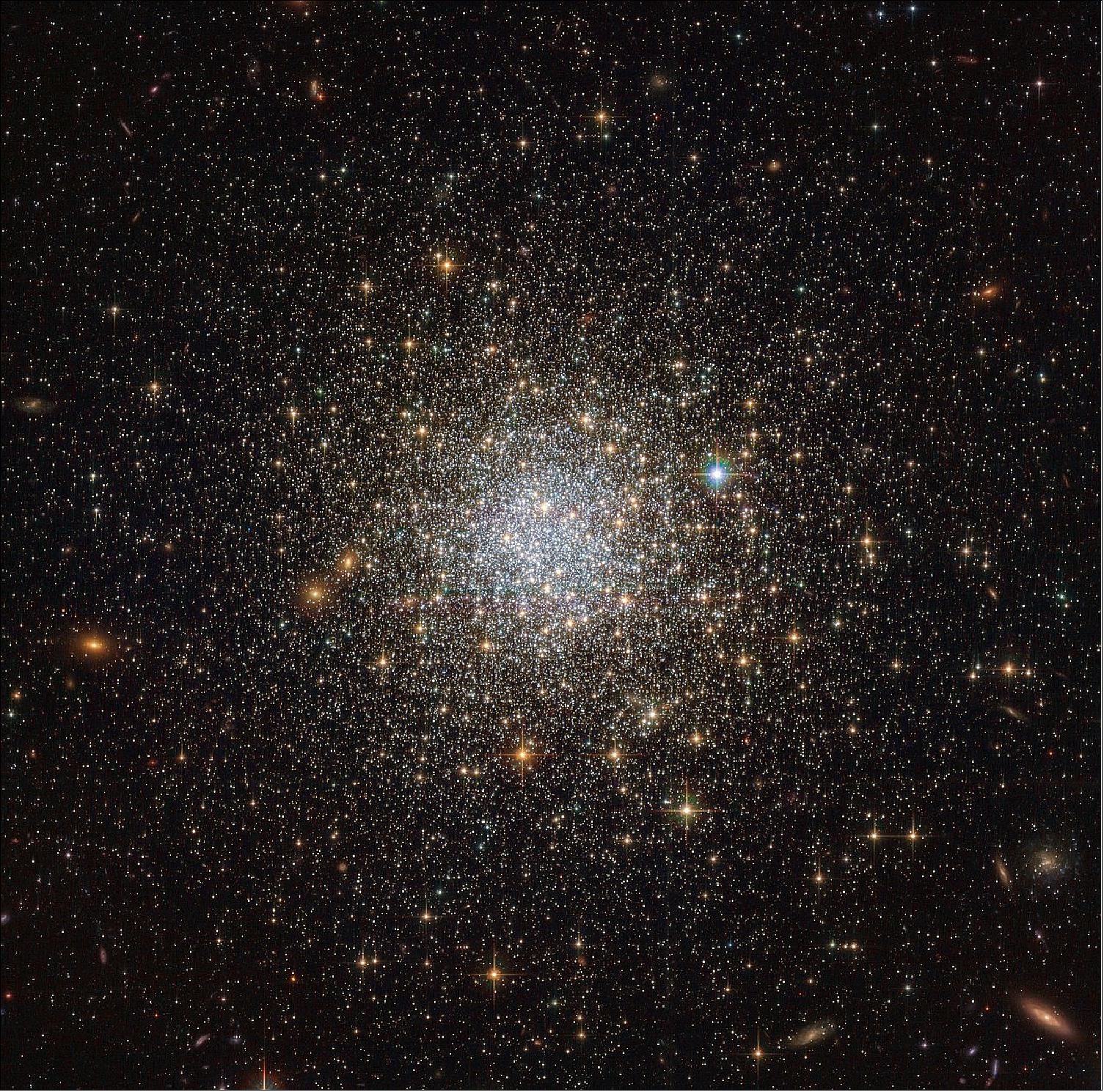
• 06 September 2019: This Picture of the Week shows a dwarf galaxy named UGC 685. Such galaxies are small and contain just a tiny fraction of the number of stars in a galaxy like the Milky Way. Dwarf galaxies often show a hazy structure, an ill-defined shape, and an appearance somewhat akin to a swarm or cloud of stars — and UGC 685 is no exception to this. Classified as an SAm galaxy — a type of unbarred spiral galaxy — it is located about 15 million light-years from Earth. 36)
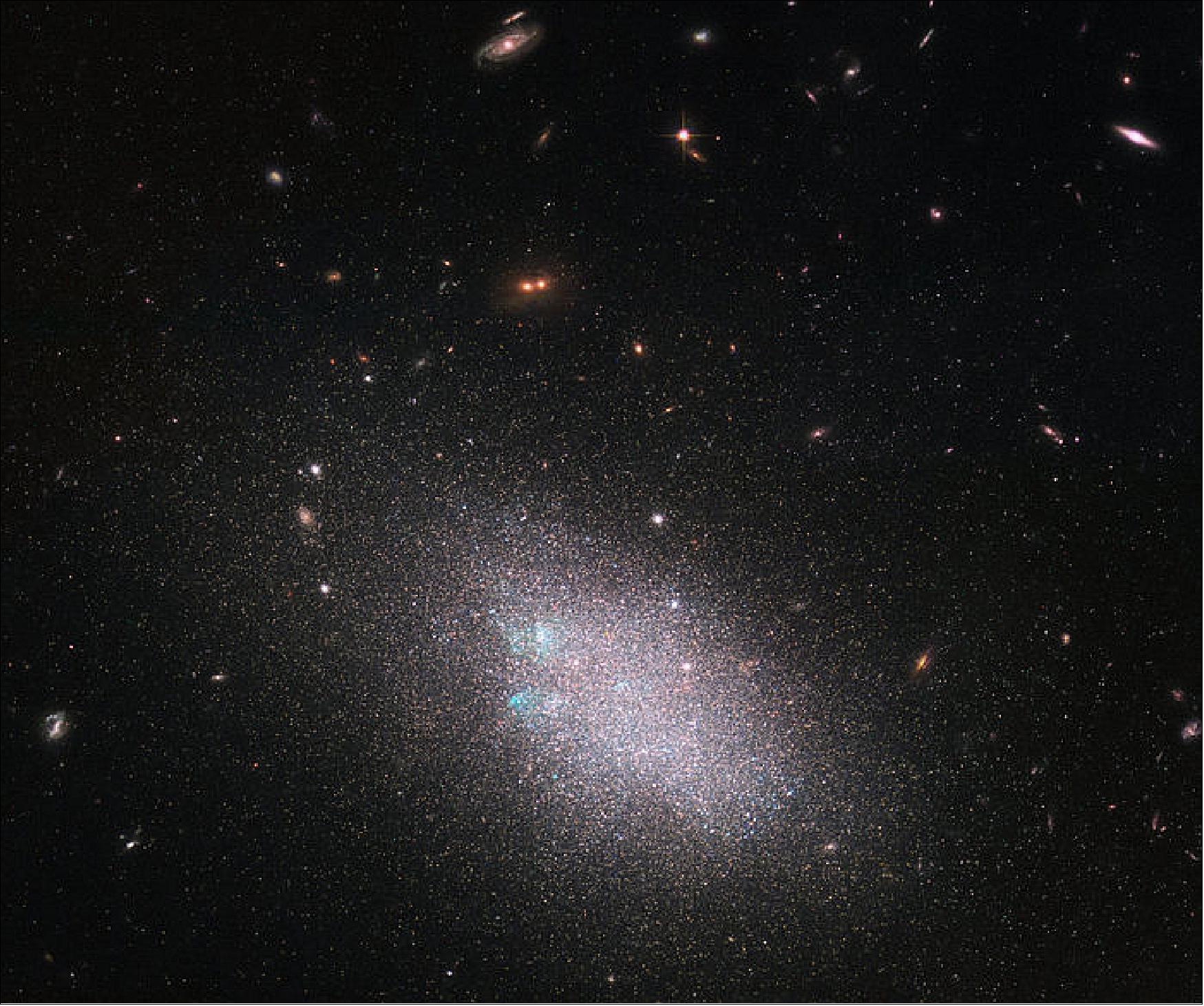
- LEGUS is imaging 50 spiral and dwarf galaxies in our cosmic neighborhood in multiple colors using Hubble’s Wide Field Camera 3. The survey is picking apart the structures of these galaxies and resolving their constituent stars, clusters, groups, and other stellar associations. Star formation plays a huge role in shaping its host galaxy; by exploring these targets in detail via both new observations and archival Hubble data, LEGUS will shed light on how stars form and cluster together, how these clusters evolve, how a star’s formation affects its surroundings, and how stars explode at the end of their lives.
• 23 August 2019: This atmospheric Picture of the Week, taken with the NASA/ESA Hubble Space Telescope, shows a dark, gloomy scene in the constellation of Gemini (The Twins). The subject of this image confused astronomers when it was first studied — rather than being classified as a single object, it was instead recorded as two objects, owing to its symmetrical lobed structure (known as NGC 2371 and NGC 2372, though sometimes referred to together as NGC 2371/2). 37)
- The structure of this region is complex. It is filled with dense knots of gas, fast-moving jets that appear to be changing direction over time, and expanding clouds of material streaming outwards on diametrically opposite sides of the remnant star. Patches of this scene glow brightly as the remnant star emits energetic radiation that excites the gas within these regions, causing it to light up. This scene will continue to change over the next few thousand years; eventually the knotty lobes will dissipate completely, and the remnant star will cool and dim to form a white dwarf.
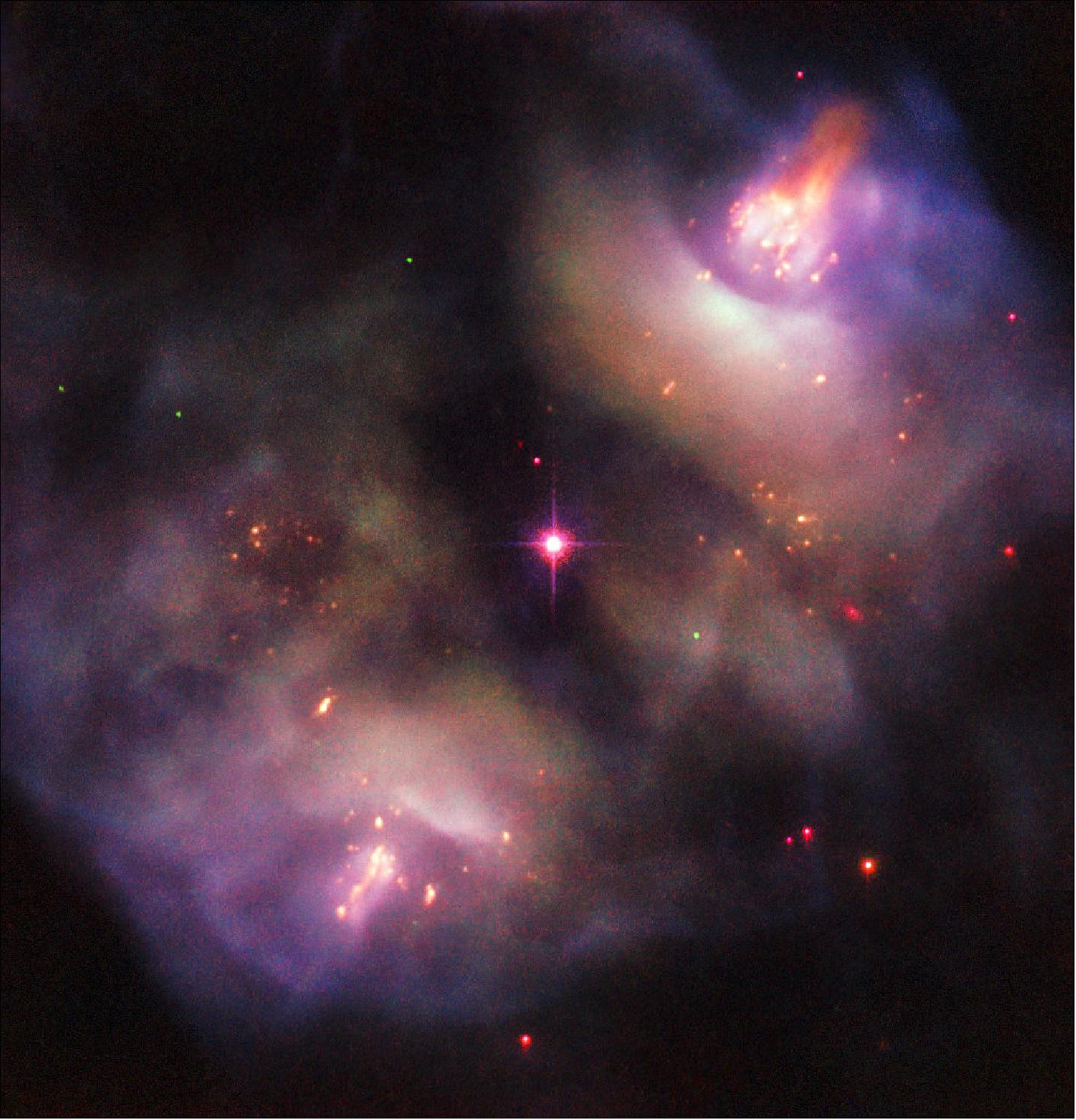
• 16 August 2019: When stars like the Sun grow advanced in age, they expand and glow red. These so-called red giants then begin to lose their outer layers of material into space. More than half of such a star's mass can be shed in this manner, forming a shell of surrounding gas. At the same time, the star's core shrinks and grows hotter, emitting ultraviolet light that causes the expelled gases to glow. 38)
- This type of object is called, somewhat confusingly, a planetary nebula, though it has nothing to do with planets. The name derives from the rounded, planet-like appearance of these objects in early telescopes.
- NGC 2022 is located in the constellation of Orion (The Hunter).
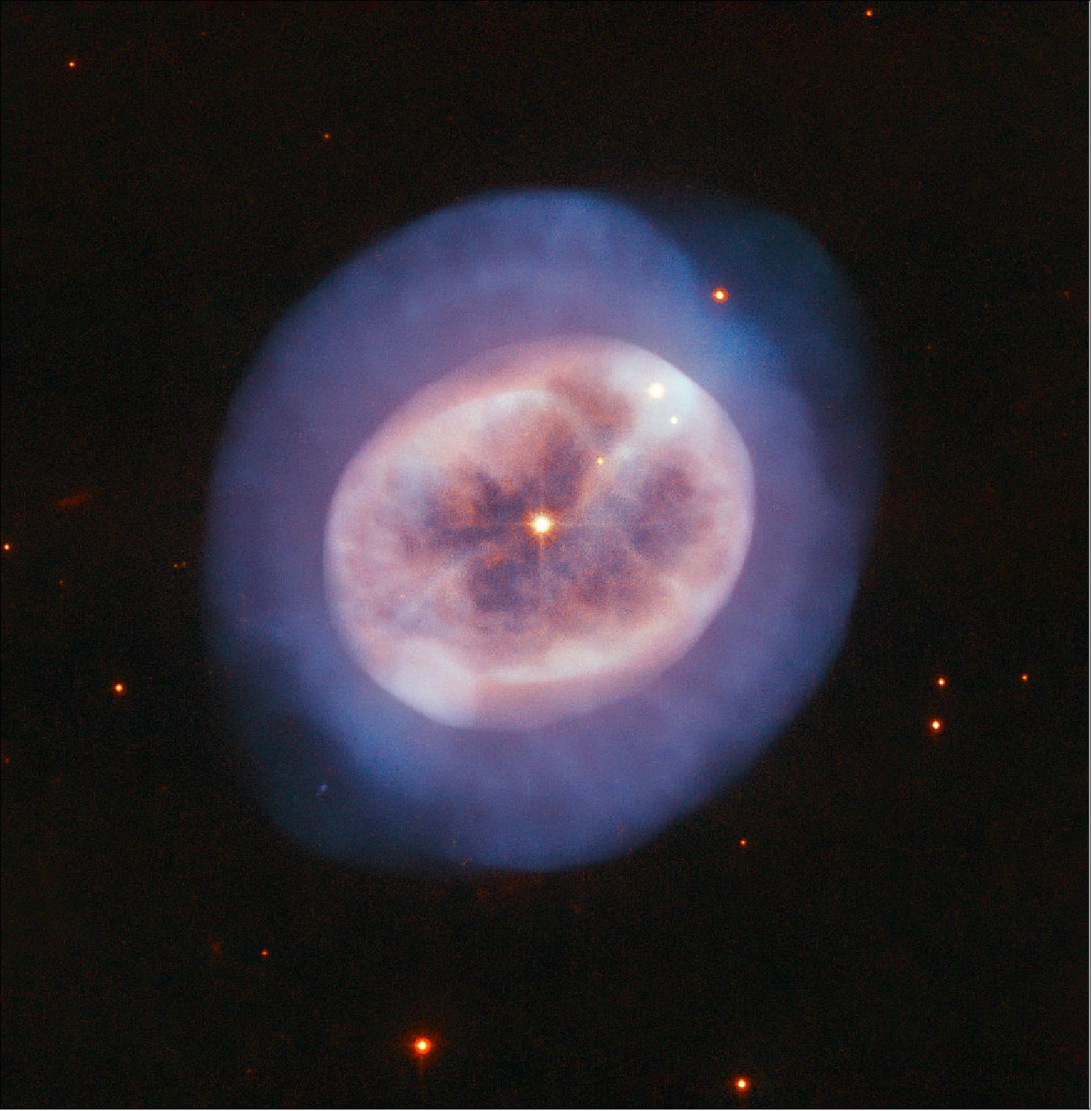
• 08 August 2019: Hubble Showcases New Portrait of Jupiter. Among the most striking features in the image are the rich colors of the clouds moving toward the Great Red Spot. This huge anticyclonic storm is roughly the diameter of Earth and is rolling counterclockwise between two bands of clouds that are moving in opposite directions toward it. 39)
- As with previous images of Jupiter taken by Hubble, and other observations from telescopes on the ground, the new image confirms that the huge storm which has raged on Jupiter’s surface for at least 150 years continues to shrink. The reason for this is still unknown so Hubble will continue to observe Jupiter in the hope that scientists will be able to solve this stormy riddle. Much smaller storms appear on Jupiter as white or brown ovals that can last as little as a few hours or stretch on for centuries.
- The worm-shaped feature located south of the Great Red Spot is a cyclone, a vortex spinning in the opposite direction to that in which the Great Red Spot spins. Researchers have observed cyclones with a wide variety of different appearances across the planet. The two white oval features are anticyclones, similar to small versions of the Great Red Spot.
- The Hubble image also highlights Jupiter’s distinct parallel cloud bands. These bands consist of air flowing in opposite directions at various latitudes. They are created by differences in the thickness and height of the ammonia ice clouds; the lighter bands rise higher and have thicker clouds than the darker bands. The different concentrations are kept separate by fast winds which can reach speeds of up to 650 km/hour.
- These observations of Jupiter form part of the Outer Planet Atmospheres Legacy (OPAL) program, which began in 2014. This initiative allows Hubble to dedicate time each year to observing the outer planets and provides scientists with access to a collection of maps, which helps them to understand not only the atmospheres of the giant planets in the Solar System, but also the atmosphere of our own planet and of the planets in other planetary systems.
![Figure 32: The NASA/ESA Hubble Space Telescope reveals the intricate, detailed beauty of Jupiter’s clouds in this new image taken on 27 June 2019 by Hubble’s Wide Field Camera 3, when the planet was 644 million kilometers from Earth — its closest distance this year. The image features the planet’s trademark Great Red Spot and a more intense color palette in the clouds swirling in the planet’s turbulent atmosphere than seen in previous years [image credit: NASA, ESA, A. Simon (Goddard Space Flight Center), and M.H. Wong (University of California, Berkeley)]](/api/cms/documents/163813/5502378/Hubble2019_Auto2F.jpeg)
• 02 August 2019: Believe it or not, this long, luminous streak, speckled with bright blisters and pockets of material, is a spiral galaxy like our Milky Way. But how could that be? 40)
- The galaxy is located in the constellation of Leo Minor (The Lesser Lion). Other telescopes that have had NGC 3432 in their sights include those of the Sloan Digital Sky Survey, the Galaxy Evolution Explorer (GALEX), and the Infrared Astronomical Satellite (IRAS).
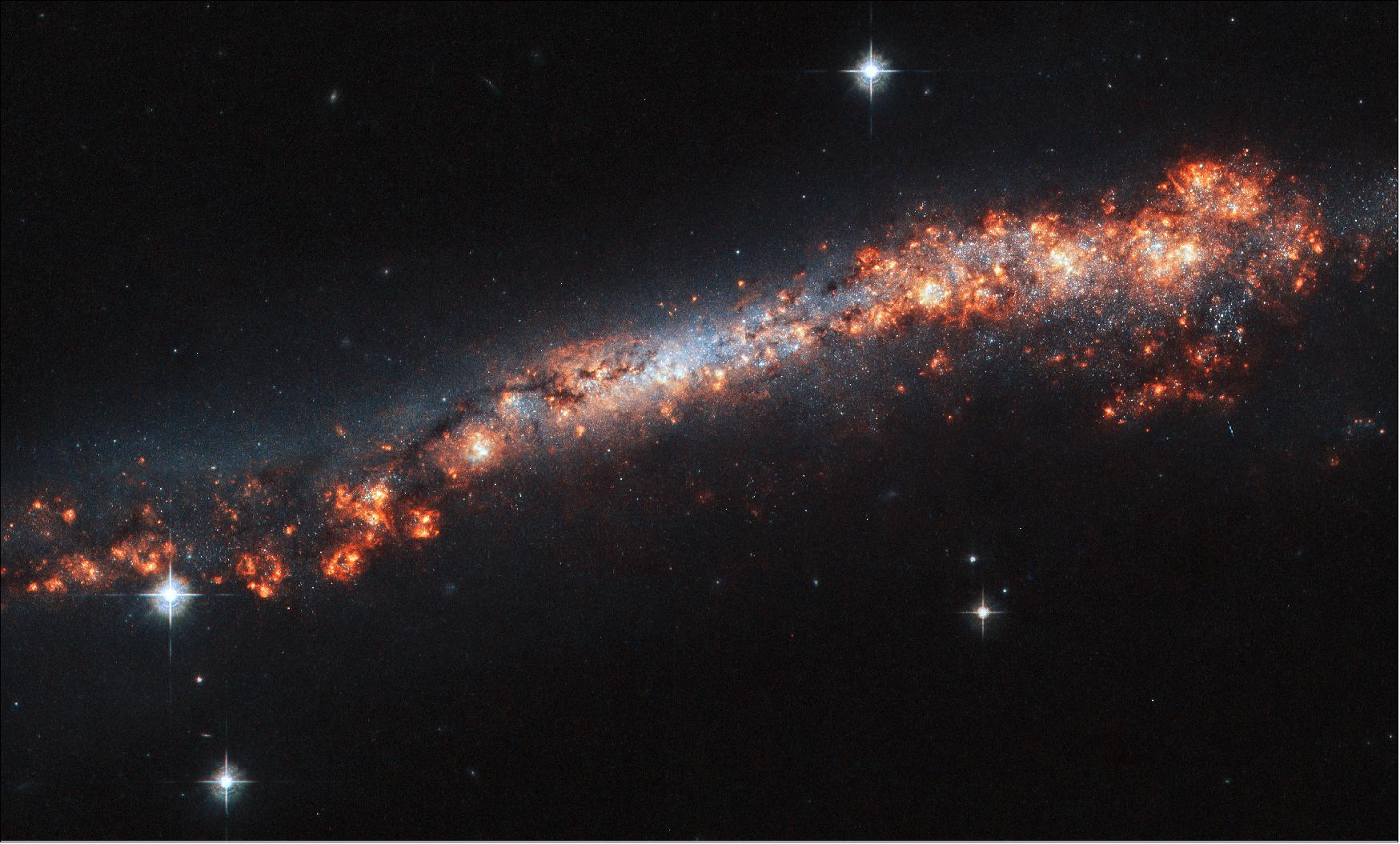
• 01 August 2019: The scorching hot exoplanet WASP-121b represents a new twist on the phrase "heavy metal." — There are no loud electric guitar riffs, characteristic of heavy metal music, streaming into space. What is escaping the planet is iron and magnesium gas, dubbed heavy metals, because they are heavier than lightweight hydrogen and helium. The observations by the Hubble Space Telescope represent the first time heavy metal gas has been detected floating away from an exoplanet. 41)
- Observations by NASA's Hubble Space Telescope reveal magnesium and iron gas streaming from the strange world outside our solar system known as WASP-121b. The observations represent the first time that so-called "heavy metals"—elements heavier than hydrogen and helium—have been spotted escaping from a hot Jupiter, a large, gaseous exoplanet very close to its star.
- Normally, hot Jupiter-sized planets are still cool enough inside to condense heavier elements such as magnesium and iron into clouds.
- But that's not the case with WASP-121b, which is orbiting so dangerously close to its star that its upper atmosphere reaches a blazing 4,600 degrees Fahrenheit. The WASP-121 system resides about 900 light-years from Earth.
- "Heavy metals have been seen in other hot Jupiters before, but only in the lower atmosphere," explained lead researcher David Sing of the Johns Hopkins University in Baltimore, Maryland. "So you don't know if they are escaping or not. With WASP-121b, we see magnesium and iron gas so far away from the planet that they're not gravitationally bound."
- Ultraviolet light from the host star, which is brighter and hotter than the Sun, heats the upper atmosphere and helps lead to its escape. In addition, the escaping magnesium and iron gas may contribute to the temperature spike, Sing said. "These metals will make the atmosphere more opaque in the ultraviolet, which could be contributing to the heating of the upper atmosphere," he explained.
- The sizzling planet is so close to its star that it is on the cusp of being ripped apart by the star's gravity. This hugging distance means that the planet is football shaped due to gravitational tidal forces.
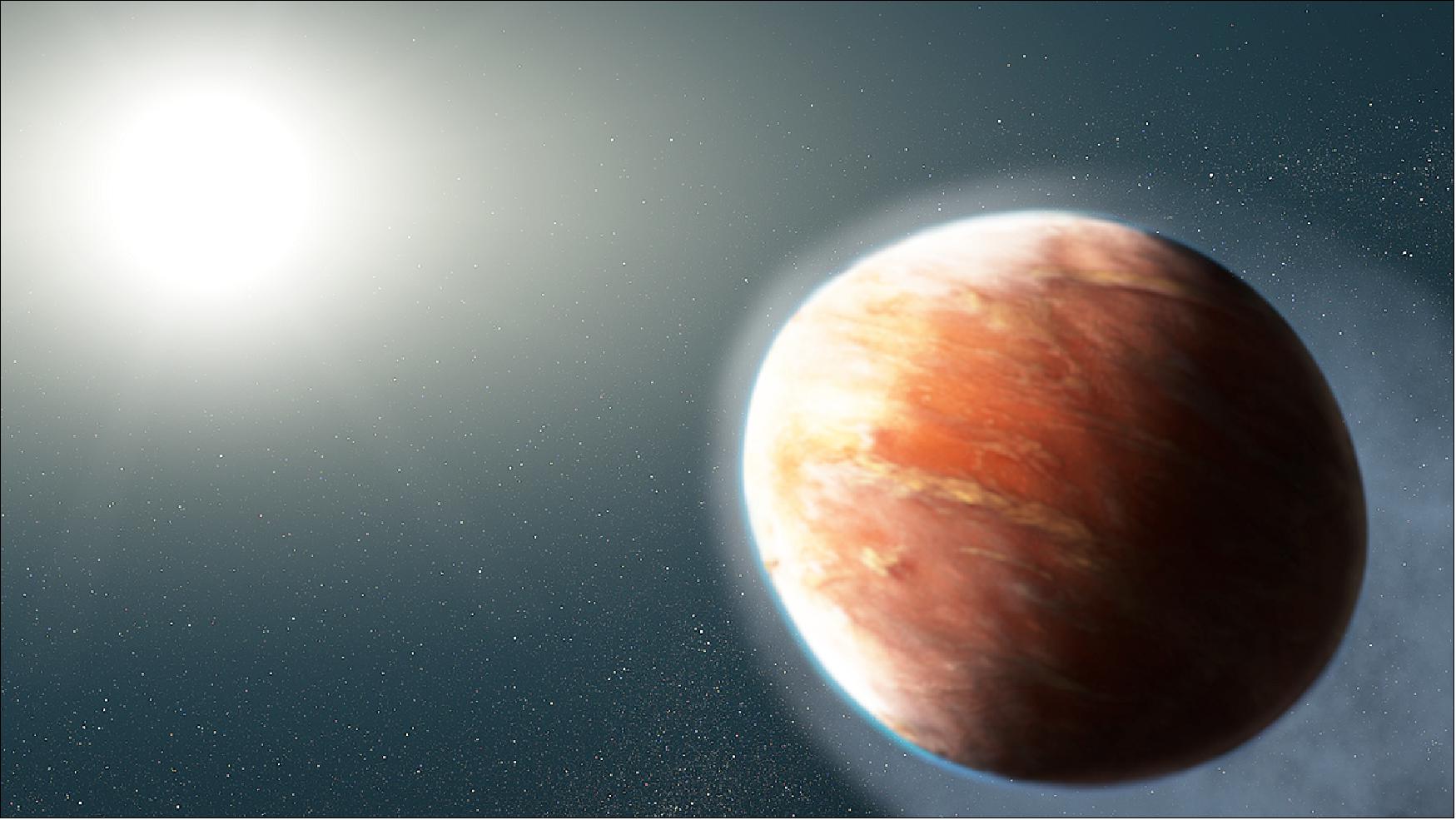
- "We picked this planet because it is so extreme," Sing said. "We thought we had a chance of seeing heavier elements escaping. It's so hot and so favorable to observe, it's the best shot at finding the presence of heavy metals. We were mainly looking for magnesium, but there have been hints of iron in the atmospheres of other exoplanets. It was a surprise, though, to see it so clearly in the data and at such great altitudes so far away from the planet. The heavy metals are escaping partly because the planet is so big and puffy that its gravity is relatively weak. This is a planet being actively stripped of its atmosphere."
- The researchers used the observatory's STIS (Space Telescope Imaging Spectrograph) to search in ultraviolet light for the spectral signatures of magnesium and iron imprinted on starlight filtering through WASP-121b's atmosphere as the planet passed in front of, or transited, the face of its home star.
- This exoplanet is also a perfect target for NASA's upcoming James Webb Space Telescope to search in infrared light for water and carbon dioxide, which can be detected at longer, redder wavelengths. The combination of Hubble and Webb observations would give astronomers a more complete inventory of the chemical elements that make up the planet's atmosphere.
- The WASP-121b study is part of the Panchromatic Comparative Exoplanet Treasury (PanCET) survey, a Hubble program to look at 20 exoplanets, ranging in size from super-Earths (several times Earth's mass) to Jupiters (which are over 100 times Earth's mass), in the first large-scale ultraviolet, visible, and infrared comparative study of distant worlds.
- The observations of WASP-121b add to the developing story of how planets lose their primordial atmospheres. When planets form, they gather an atmosphere containing gas from the disk in which the planet and star formed. These atmospheres consist mostly of the primordial, lighter-weight gases hydrogen and helium, the most plentiful elements in the universe. This atmosphere dissipates as a planet moves closer to its star.
- "The hot Jupiters are mostly made of hydrogen, and Hubble is very sensitive to hydrogen, so we know these planets can lose the gas relatively easily," Sing said. "But in the case of WASP-121b, the hydrogen and helium gas is outflowing, almost like a river, and is dragging these metals with them. It's a very efficient mechanism for mass loss."
- The results will appear online today in The Astronomical Journal. 42)
- The Hubble Space Telescope is a project of international cooperation between NASA and ESA (European Space Agency). NASA's Goddard Space Flight Center in Greenbelt, Maryland, manages the telescope. The Space Telescope Science Institute (STScI) in Baltimore, Maryland, conducts Hubble science operations. STScI is operated for NASA by the Association of Universities for Research in Astronomy in Washington, D.C.
• 26 July 2019: Every now and then, the NASA/ESA Hubble Space Telescope glimpses a common object — say, a spiral galaxy — in an interesting or unusual way. A sharply angled perspective, such as the one shown in this Hubble image, can make it seem as if we, the viewers, are craning our necks to see over a barrier into the galaxy's bright center. 43) 44)
- NGC 3169 is located about 70 million light-years away in the constellation of Sextans (The Sextant). It is part of the Leo I Group of galaxies, which, like the Local Group that houses our home galaxy, the Milky Way, is part of a larger galactic congregation known as the Virgo Supercluster.
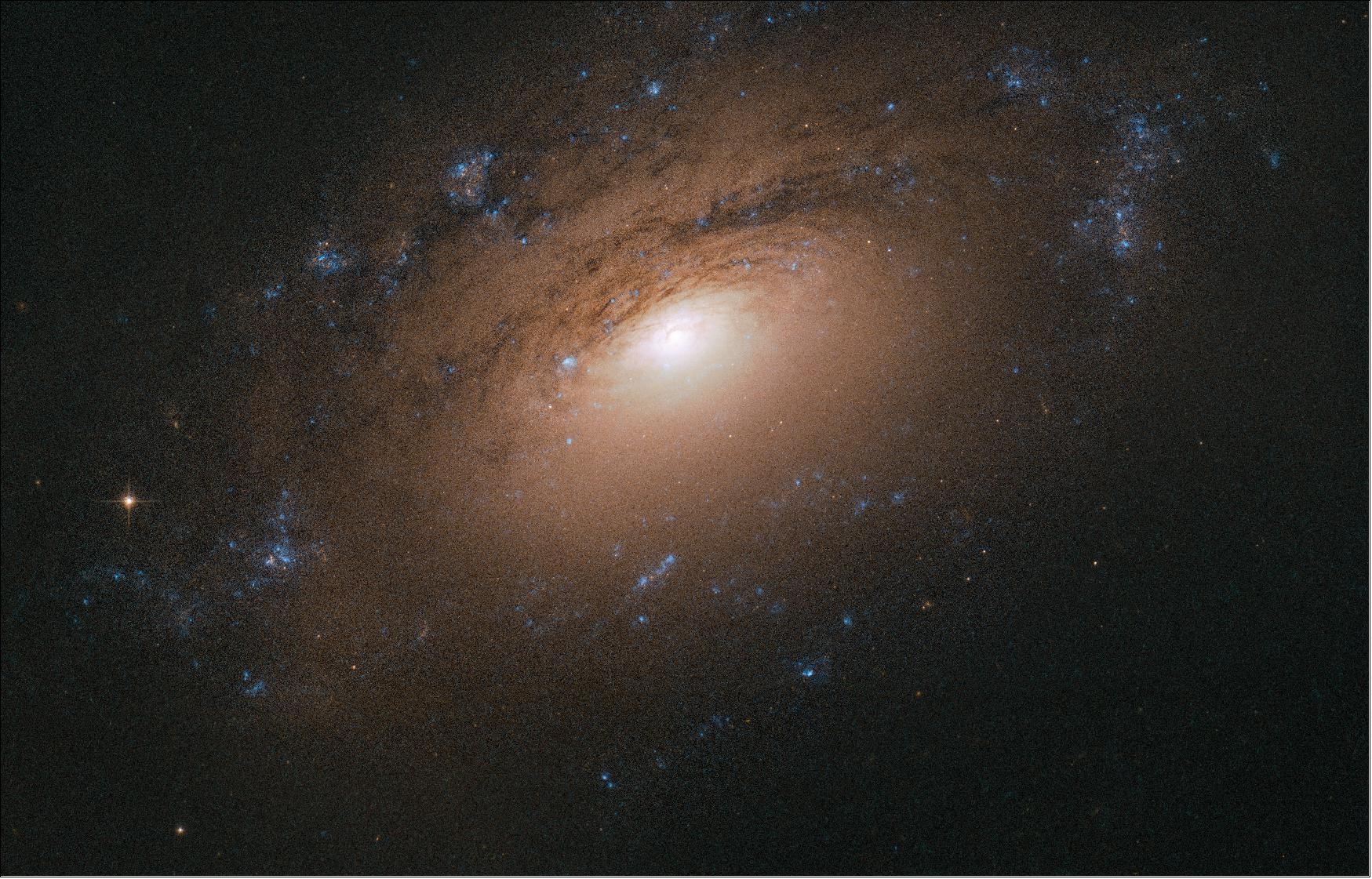
• 16 July 2019: Astronomers have made a new measurement of how fast the universe is expanding, using an entirely different kind of star than previous endeavors. The revised measurement, which comes from NASA's Hubble Space Telescope, falls in the center of a hotly debated question in astrophysics that may lead to a new interpretation of the universe's fundamental properties. 45)
- Scientists have known for almost a century that the universe is expanding, meaning the distance between galaxies across the universe is becoming ever more vast every second. But exactly how fast space is stretching, a value known as the Hubble constant, has remained stubbornly elusive.
- Now, University of Chicago professor Wendy Freedman and colleagues have a new measurement for the rate of expansion in the modern universe, suggesting the space between galaxies is stretching faster than scientists would expect. Freedman's is one of several recent studies that point to a nagging discrepancy between modern expansion measurements and predictions based on the universe as it was more than 13 billion years ago, as measured by the European Space Agency's Planck satellite.
- As more research points to a discrepancy between predictions and observations, scientists are considering whether they may need to come up with a new model for the underlying physics of the universe in order to explain it.
- "The Hubble constant is the cosmological parameter that sets the absolute scale, size and age of the universe; it is one of the most direct ways we have of quantifying how the universe evolves," said Freedman. "The discrepancy that we saw before has not gone away, but this new evidence suggests that the jury is still out on whether there is an immediate and compelling reason to believe that there is something fundamentally flawed in our current model of the universe.”
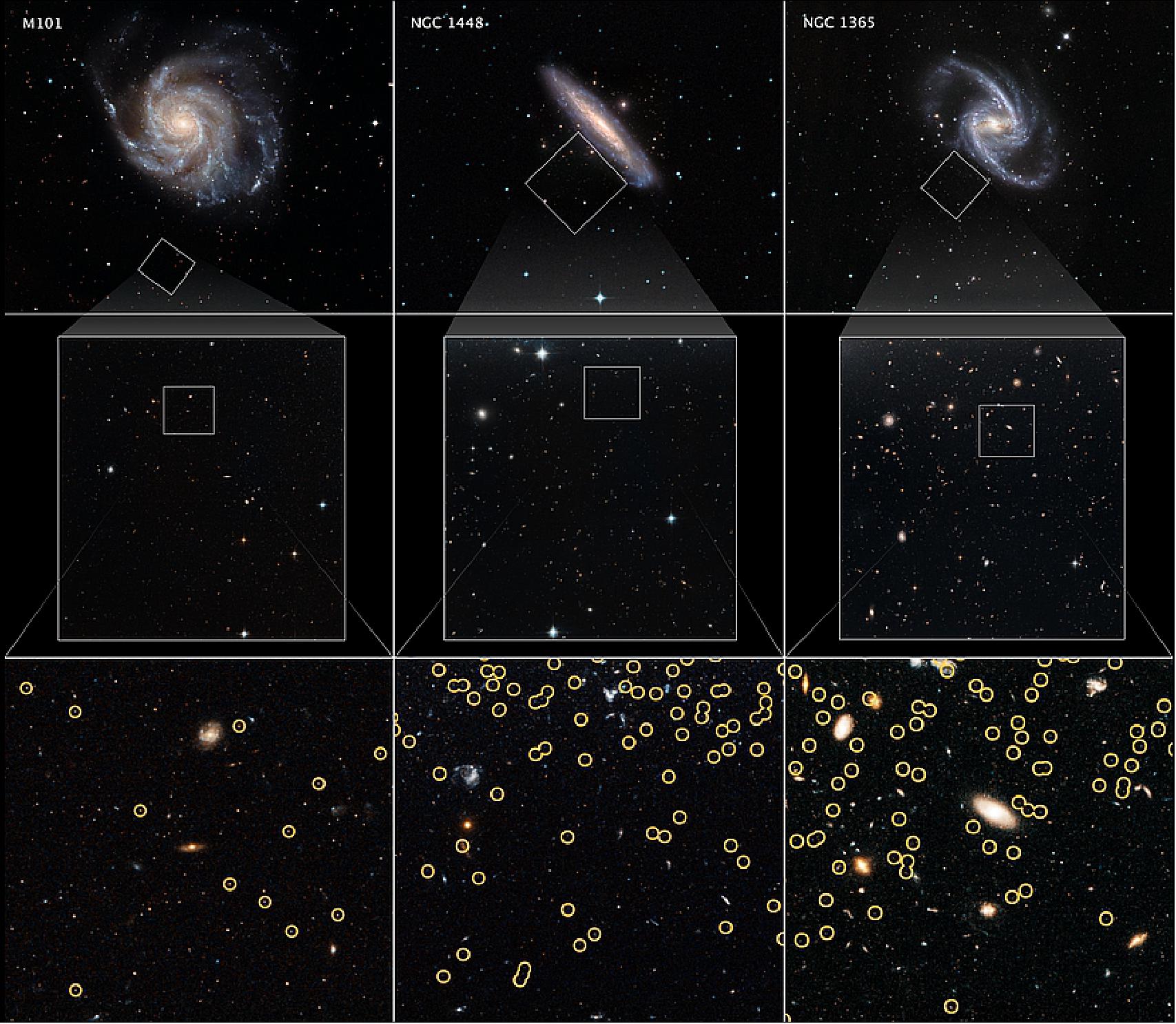
- In a new paper accepted for publication in The Astrophysical Journal, Freedman and her team announced a new measurement of the Hubble constant using a kind of star known as a red giant. Their new observations, made using Hubble, indicate that the expansion rate for the nearby universe is just under 70 km/sec/Mpc (Megaparsec). One parsec is equivalent to 3.26 light-years distance. 46)
- This measurement is slightly smaller than the value of 74 km/sec/Mpc recently reported by the Hubble SH0ES (Supernovae H0 for the Equation of State) team using Cepheid variables, which are stars that pulse at regular intervals that correspond to their peak brightness. This team, led by Adam Riess of the Johns Hopkins University and Space Telescope Science Institute, Baltimore, Maryland, recently reported refining their observations to the highest precision to date for their Cepheid distance measurement technique.
How to Measure Expansion
- A central challenge in measuring the universe's expansion rate is that it is very difficult to accurately calculate distances to distant objects.
- In 2001, Freedman led a team that used distant stars to make a landmark measurement of the Hubble constant. The Hubble Space Telescope Key Project team measured the value using Cepheid variables as distance markers. Their program concluded that the value of the Hubble constant for our universe was 72 km/sec/Mpc.
- But more recently, scientists took a very different approach: building a model based on the rippling structure of light left over from the big bang, which is called the Cosmic Microwave Background. The Planck measurements allow scientists to predict how the early universe would likely have evolved into the expansion rate astronomers can measure today. Scientists calculated a value of 67.4 km/sec/Mpc, in significant disagreement with the rate of 74.0 km/sec/Mpc measured with Cepheid stars.
- Astronomers have looked for anything that might be causing the mismatch. "Naturally, questions arise as to whether the discrepancy is coming from some aspect that astronomers don't yet understand about the stars we're measuring, or whether our cosmological model of the universe is still incomplete," Freedman said. "Or maybe both need to be improved upon."
- Freedman's team sought to check their results by establishing a new and entirely independent path to the Hubble constant using an entirely different kind of star.
- Certain stars end their lives as a very luminous kind of star called a red giant, a stage of evolution that our own Sun will experience billions of years from now. At a certain point, the star undergoes a catastrophic event called a helium flash, in which the temperature rises to about 100 million degrees and the structure of the star is rearranged, which ultimately dramatically decreases its luminosity. Astronomers can measure the apparent brightness of the red giant stars at this stage in different galaxies, and they can use this as a way to tell their distance.
- The Hubble constant is calculated by comparing distance values to the apparent recessional velocity of the target galaxies — that is, how fast galaxies seem to be moving away. The team's calculations give a Hubble constant of 69.8 km/sec/Mpc — straddling the values derived by the Planck and Riess teams.
- "Our initial thought was that if there's a problem to be resolved between the Cepheids and the Cosmic Microwave Background, then the red giant method can be the tie-breaker," said Freedman.
- But the results do not appear to strongly favor one answer over the other say the researchers, although they align more closely with the Planck results.
- NASA's upcoming mission, the Wide Field Infrared Survey Telescope (WFIRST), scheduled to launch in the mid-2020s, will enable astronomers to better explore the value of the Hubble constant across cosmic time. WFIRST, with its Hubble-like resolution and 100 times greater view of the sky, will provide a wealth of new Type Ia supernovae, Cepheid variables, and red giant stars to fundamentally improve distance measurements to galaxies near and far.
- The Hubble Space Telescope is a project of international cooperation between NASA and ESA (European Space Agency). NASA's Goddard Space Flight Center in Greenbelt, Maryland, manages the telescope. The Space Telescope Science Institute (STScI) in Baltimore, Maryland, conducts Hubble science operations. STScI is operated for NASA by the Association of Universities for Research in Astronomy in Washington, D.C.
In 1924, American astronomer Edwin Hubble announced that he discovered galaxies outside of our Milky Way by using the powerful new Hooker telescope perched above Los Angeles. By measuring the distances to these galaxies, he realized the farther away a galaxy is, the faster it appears to be receding from us. This was incontrovertible evidence the universe is uniformly expanding in all directions. This was a big surprise, even to Albert Einstein, who predicted a well-balanced, static universe. The expansion rate is the basis of the Hubble constant. It is a sought-after value because it yields clues to the origin, age, evolution, and future fate of our universe.
For nearly the past century astronomers have worked meticulously to precisely measure the Hubble constant. Before the Hubble Space Telescope was launched in 1990, the universe's age was thought to lie between 10 and 20 billion years, based on different estimates of the Hubble constant. Improving this value was one of the biggest justifications for building the Hubble telescope. This paid off in the early 1990s when a team led by Wendy Freedman of the University of Chicago greatly refined the Hubble constant value to a precision of 10%. This was possible because the Hubble telescope is so sharp at finding and measuring Cepheid variable stars as milepost markers — just as Edwin Hubble did 70 years earlier.
But astronomers strive for ever greater precision, and this requires further refining yardsticks for measuring vast intergalactic distances of billions of light-years. Freedman's latest research looks at aging red giant stars in nearby galaxies. They are also milepost markers because they all reach the same peak brightness at a critical stage of their late evolution. This can be used to calculate distances.
Freedman's research is one of several recent studies that point to a nagging discrepancy between the universe's modern expansion rate and predictions based on the universe as it was more than 13 billion years ago, as measured by the European Space Agency's Planck satellite. This latest measurement offers new evidence suggesting that there may be something fundamentally flawed in the current model of the universe.
• 11 July 2019: Astronomers using the NASA/ESA Hubble Space Telescope have observed an unexpected thin disc of material encircling a supermassive black hole at the heart of the spiral galaxy NGC 3147, located 130 million light-years away. 47) 48) 49)
- The presence of the black hole disc in such a low-luminosity active galaxy has astronomers surprised. Black holes in certain types of galaxies such as NGC 3147 are considered to be starving as there is insufficient gravitationally captured material to feed them regularly. It is therefore puzzling that there is a thin disc encircling a starving black hole that mimics the much larger discs found in extremely active galaxies.
- Of particular interest, this disc of material circling the black hole offers a unique opportunity to test Albert Einstein’s theories of relativity. The disc is so deeply embedded in the black hole’s intense gravitational field that the light from the gas disc is altered, according to these theories, giving astronomers a unique peek at the dynamic processes close to a black hole.
- “We’ve never seen the effects of both general and special relativity in visible light with this much clarity,” said team member Marco Chiaberge of AURA (Association of Universities for Research in Astronomy) for ESA, STScI and Johns Hopkins University.
- The disc’s material was measured by Hubble to be whirling around the black hole at more than 10% of the speed of light. At such extreme velocities, the gas appears to brighten as it travels toward Earth on one side, and dims as it speeds away from our planet on the other. This effect is known as relativistic beaming. Hubble’s observations also show that the gas is embedded so deep in a gravitational well that light is struggling to escape, and therefore appears stretched to redder wavelengths. The black hole’s mass is around 250 million times that of the Sun.
- “This is an intriguing peek at a disc very close to a black hole, so close that the velocities and the intensity of the gravitational pull are affecting how we see the photons of light,” explained the study’s first author, Stefano Bianchi, of Università degli Studi Roma Tre in Italy.
- In order to study the matter swirling deep inside this disc, the researchers used the Hubble Space Telescope Imaging Spectrograph (STIS) instrument. This diagnostic tool divides the light from an object into its many individual wavelengths to determine the object's speed, temperature, and other characteristics at very high precision. STIS was integral to effectively observing the low-luminosity region around the black hole, blocking out the galaxy’s brilliant light.
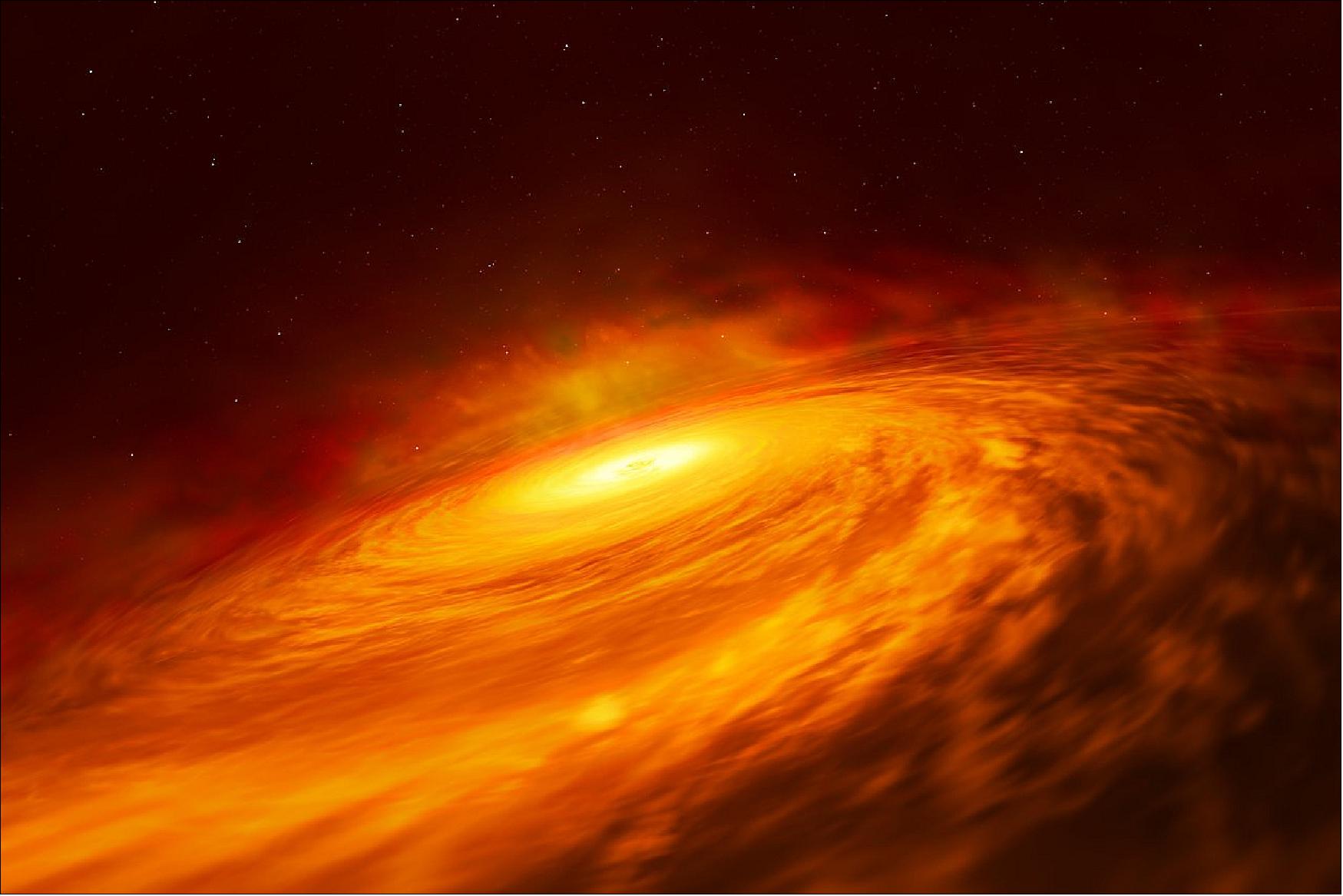
- The astronomers initially selected this galaxy to validate accepted models about lower-luminosity active galaxies: those with malnourished black holes. These models predict that discs of material should form when ample amounts of gas are trapped by a black hole’s strong gravitational pull, subsequently emitting lots of light and producing a brilliant beacon called a quasar.
- “The type of disc we see is a scaled-down quasar that we did not expect to exist,” Bianchi explained. “It’s the same type of disc we see in objects that are 1000 or even 100 000 times more luminous. The predictions of current models for very faint active galaxies clearly failed.”
- The team hopes to use Hubble to hunt for other very compact discs around low-luminosity black holes in similar active galaxies.
![Figure 38: A Hubble Space Telescope image of the spiral galaxy NGC 3147 appears next to an artist's illustration of the supermassive black hole residing at the galaxy’s core. The Hubble image shows off the galaxy's sweeping spiral arms, full of young blue stars, pinkish nebulas, and dust in silhouette. However, at the brilliant core of NGC 3147 lurks a monster black hole, weighing about 250 million times the mass of our Sun. Hubble observations of the black hole demonstrate two of Einstein’s theories of relativity. The reddish-yellow features swirling around the center are the glow of light from gas trapped by the hefty black hole’s powerful gravity. The black hole is embedded deep within its gravitational field, shown by the green grid that illustrates warped space. The gravitational field is so strong that light is struggling to climb out, a principal described in Einstein's theory of general relativity. Material also is whipping so fast around the black hole that it brightens as it approaches Earth on one side of the disk and gets fainter as it moves away. This effect, called relativistic beaming, was predicted by Einstein's theory of special relativity. NGC 3147 is located 130 million light-years away in the northern circumpolar constellation Draco the Dragon [image credit: Hubble Image: NASA, ESA, S. Bianchi (Università degli Studi Roma Tre University), A. Laor (Technion-Israel Institute of Technology), & M. Chiaberge (ESA, STScI, and JHU); illustration: NASA, ESA, and A. Feild and L. Hustak (STScI)]](/api/cms/documents/163813/5502378/Hubble2019_Auto29.jpeg)
• 08 July 2019: NGC 1156 is located in the constellation of Aries (The Ram). It is classified as a dwarf irregular galaxy, meaning that it lacks a clear spiral or rounded shape, as other galaxies have, and is on the smaller side, albeit with a relatively large central region that is more densely packed with stars. 50)
- Some pockets of gas within NGC 1156 rotate in the opposite direction to the rest of the galaxy, suggesting that there has been a close encounter with another galaxy in NGC 1156's past. The gravity of this other galaxy — and the turbulent chaos of such an interaction — could have scrambled the likely more orderly rotation of material within NGC 1156, producing the odd behavior we see today.
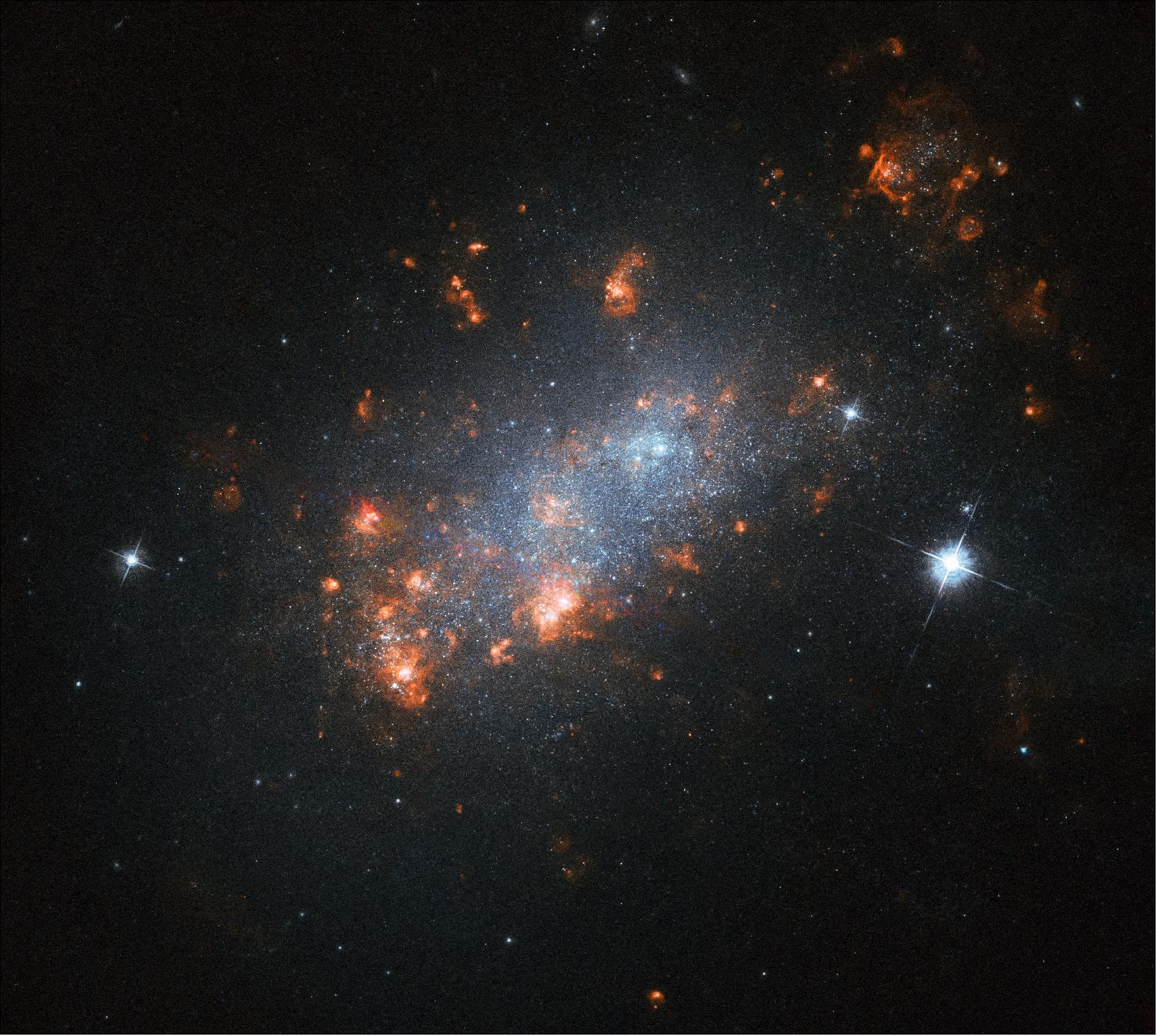
• 02 July 2019: Two NASA space telescopes have teamed up to identify, for the first time, the detailed chemical "fingerprint" of a planet between the sizes of Earth and Neptune. No planets like this can be found in our own solar system, but they are common around other stars. 51)
- The planet, Gliese 3470 b (also known as GJ 3470 b), may be a cross between Earth and Neptune, with a large rocky core buried under a deep, crushing hydrogen-and-helium atmosphere. Weighing in at 12.6 Earth masses, the planet is more massive than Earth but less massive than Neptune (which is more than 17 Earth masses).
- Many similar worlds have been discovered by NASA's Kepler space observatory, whose mission ended in 2018. In fact, 80% of the planets in our galaxy may fall into this mass range. However, astronomers have never been able to understand the chemical nature of such a planet until now, researchers say.
- By inventorying the contents of GJ 3470 b's atmosphere, astronomers are able to uncover clues about the planet's nature and origin.
- "This is a big discovery from the planet-formation perspective. The planet orbits very close to the star and is far less massive than Jupiter - 318 times Earth's mass - but has managed to accrete the primordial hydrogen/helium atmosphere that is largely 'unpolluted' by heavier elements," said Björn Benneke of the University of Montreal in Canada. "We don't have anything like this in the solar system, and that's what makes it striking."
- Astronomers enlisted the combined multi-wavelength capabilities NASA's Hubble and Spitzer space telescopes to do a first-of-a-kind study of GJ 3470 b's atmosphere.
- This was accomplished by measuring the absorption of starlight as the planet passed in front of its star (transit) and the loss of reflected light from the planet as it passed behind the star (eclipse). All told, the space telescopes observed 12 transits and 20 eclipses. The science of analyzing chemical fingerprints based on light is called "spectroscopy."
![Figure 40: This artist's illustration shows the theoretical internal structure of the exoplanet GJ 3470 b. It is unlike any planet found in the Solar System. Weighing in at 12.6 Earth masses the planet is more massive than Earth but less massive than Neptune. Unlike Neptune, which is 3 billion miles from the Sun, GJ 3470 b may have formed very close to its red dwarf star as a dry, rocky object. It then gravitationally pulled in hydrogen and helium gas from a circumstellar disk to build up a thick atmosphere. The disk dissipated many billions of years ago, and the planet stopped growing. The bottom illustration shows the disk as the system may have looked long ago. Observation by NASA's Hubble and Spitzer space telescopes have chemically analyzed the composition of GJ 3470 b's very clear and deep atmosphere, yielding clues to the planet's origin. Many planets of this mass exist in our galaxy [image credit: NASA, ESA, and L. Hustak (STScI)]](/api/cms/documents/163813/5502378/Hubble2019_Auto27.jpeg)
- "For the first time we have a spectroscopic signature of such a world," said Benneke. But he is at a loss for classification: Should it be called a "super-Earth" or "sub-Neptune?" Or perhaps something else?
- Fortuitously, the atmosphere of GJ 3470 b turned out to be mostly clear, with only thin hazes, enabling the scientists to probe deep into the atmosphere.
- "We expected an atmosphere strongly enriched in heavier elements like oxygen and carbon which are forming abundant water vapor and methane gas, similar to what we see on Neptune," said Benneke. "Instead, we found an atmosphere that is so poor in heavy elements that its composition resembles the hydrogen/helium-rich composition of the Sun."
- Other exoplanets, called "hot Jupiters," are thought to form far from their stars and over time migrate much closer. But this planet seems to have formed just where it is today, said Benneke.
- The most plausible explanation, according to Benneke, is that GJ 3470 b was born precariously close to its red dwarf star, which is about half the mass of our Sun. He hypothesizes that essentially it started out as a dry rock and rapidly accreted hydrogen from a primordial disk of gas when its star was very young. The disk is called a "protoplanetary disk."
- ”We're seeing an object that was able to accrete hydrogen from the protoplanetary disk but didn't run away to become a hot Jupiter," said Benneke. "This is an intriguing regime."
- One explanation is that the disk dissipated before the planet could bulk up further. "The planet got stuck being a sub-Neptune," said Benneke.
- NASA's upcoming James Webb Space Telescope will be able to probe even deeper into GJ 3470 b's atmosphere, thanks to Webb's unprecedented sensitivity in the infrared. The new results have already spawned great interest from American and Canadian teams developing the instruments on Webb. They will observe the transits and eclipses of GJ 3470 b at light wavelengths where the atmospheric hazes become increasingly transparent.
- The Hubble Space Telescope is a project of international cooperation between NASA and ESA (European Space Agency). NASA's Goddard Space Flight Center in Greenbelt, Maryland, manages the telescope. The Space Telescope Science Institute (STScI) in Baltimore, Maryland, conducts Hubble science operations. STScI is operated for NASA by the Association of Universities for Research in Astronomy in Washington, D.C.
- The Jet Propulsion Laboratory in Pasadena, California, manages the Spitzer Space Telescope mission for NASA's Science Mission Directorate in Washington. Science operations are conducted at the Spitzer Science Center at Caltech in Pasadena. Space operations are based at Lockheed Martin Space Systems in Littleton, Colorado. Data are archived at the Infrared Science Archive housed at IPAC at Caltech. Caltech manages JPL for NASA.
• 01 July 2019: Imagine slow-motion fireworks that started exploding nearly two centuries ago and haven’t stopped since then. This is how you might describe this double star system located 7500 light-years away in the constellation Carina (The Ship’s Keel). In 1838 Eta Carinae underwent a cataclysmic outburst called the Great Eruption, quickly escalating to become in 1844 the second brightest star in the sky by April of that year. The star has since faded, but this new view from the NASA/ESA Hubble Space Telescope shows that the spectacular display is still ongoing, and reveals details that have never been seen before. 52)
- Violent mass ejections are not uncommon in Eta Carinae’s history; the system has been blighted by chaotic eruptions, often blasting parts of itself into space But the Great Eruption was particularly dramatic. The larger of the two stars is a massive, unstable star nearing the end of its life, and what astronomers witnessed over a century and a half ago was, in fact, a stellar near-death experience.
- The resulting surge of light was outshone only by Sirius, which is almost one thousand times closer to Earth, and for a time made Eta Carinae an important navigation star for mariners in the southern seas. This close call stopped just short of destroying Eta Carinae, and the light intensity gradually subsided. Researchers studying the star today can still see the signature of the Great Eruption on its surroundings; the huge dumbbell shape is formed of the dust and gas and other filaments that were hurled into space in the expulsion. These hot glowing clouds are known as the Homunculus Nebula, and have been a target of Hubble since its launch in 1990.
![Figure 41: Hubble offers a special view of the double star system Eta Carinae’s expanding gases glowing in red, white, and blue. This is the highest resolution image of Eta Carinae taken by the NASA/ESA Hubble Space Telescope [image credit: NASA/ESA, N. Smith (University of Arizona, Tucson), and J. Morse (BoldlyGo Institute, New York)]](/api/cms/documents/163813/5502378/Hubble2019_Auto26.jpeg)
- In fact, the volatile star has been imaged by almost every instrument on Hubble over more than 25 years. Astronomers have observed the cosmic drama play out in ever higher resolution. This latest image was created using Hubble’s WFC3 (Wide Field Camera 3) to map warm magnesium gas glowing in ultraviolet light (shown in blue).
- Scientists have long known that the outer material thrown off in the 1840s eruption has been heated by shock waves generated when it crashed into material previously ejected from the star . The team who captured this new image were expecting to find light from magnesium coming from the complicated array of filaments seen in the light from glowing nitrogen (shown in red). Instead, a whole new luminous magnesium structure was found in the space between the dusty bipolar bubbles and the outer shock-heated nitrogen-rich filaments.
- We’ve discovered a large amount of warm gas that was ejected in the Great Eruption but hasn’t yet collided with the other material surrounding Eta Carinae,” explained Nathan Smith of Steward Observatory at the University of Arizona, lead investigator of the Hubble program. “Most of the emission is located where we expected to find an empty cavity. This extra material is fast, and it ‘ups the ante’ in terms of the total energy of an already powerful stellar blast.”
- This newly revealed data is important for understanding how the eruption began, because it represents the fast and energetic ejection of material that may have been expelled by the star shortly before the expulsion of the rest of the nebula. Astronomers need more observations to measure exactly how fast the material is moving and when it was ejected.
- Another striking feature of the image is the streaks visible in the blue region outside the lower-left bubble. These streaks appear where the star’s light rays poke through the dust clumps scattered along the bubble’s surface. Wherever the ultraviolet light strikes the dense dust, it leaves a long thin shadow that extends beyond the lobe into the surrounding gas. “The pattern of light and shadow is reminiscent of sunbeams that we see in our atmosphere when sunlight streams past the edge of a cloud, though the physical mechanism creating Eta Carinae’s light is different,” noted team member Jon Morse of BoldlyGo Institute in New York.
- This technique of searching in ultraviolet light for warm gas could be used to study other stars and gaseous nebulae, the researchers say.
- “We had used Hubble for decades to study Eta Carinae in visible and infrared light, and we thought we had a pretty full account of its ejected debris. But this new ultraviolet-light image looks astonishingly different, revealing gas we did not see in either visible-light or infrared images,” Smith said. “We’re excited by the prospect that this type of ultraviolet magnesium emission may also expose previously hidden gas in other types of objects that eject material, such as protostars or other dying stars; and only Hubble can take these kinds of pictures”.
- The causes of Eta Carinae’s Great Eruption remain the subject of speculation and debate. A recent theory suggests that Eta Carinae, which may once have weighed as much as 150 Suns, started out as a triple system, and the 1840s mass ejection was triggered when the primary star devoured one of its companions, rocketing more than ten times the mass of our Sun into space. While the exact circumstances of that show-stopping burst of light remain a mystery for now, astronomers are more certain of how this cosmic light show will conclude. Eta Carinae’s fireworks display is fated to reach its finale when it explodes as a supernova, greatly surpassing even its last powerful outburst. This may already have happened, but the tsunami of light from such a blinding blast would take 7500 years to reach Earth.
• 24 June 2019: Have you ever been looking for one thing – at home or while browsing the web for example – and accidentally stumbled upon something else, but that is just as interesting? Something similar happened to the NASA/ESA Hubble Space Telescope a couple of years ago. While observing distant galaxies lying billions of light-years away, the telescope serendipitously spotted several asteroids, small Solar System objects that reside ‘only’ a few tens to hundreds of millions of kilometers from Earth. 53)
- Asteroids are mainly found in an area called the ‘main belt’, between the orbits of Mars and Jupiter. More than 700 000 asteroids have been identified to date, and predictions indicate that many more might be out there, each left over from the early days when planets were taking shape around the Sun.
- The curved or S-shaped streaks in this image are trails created by asteroids as they move along their orbits. Rather than leaving one long trail, the asteroids appear in multiple Hubble exposures that have been combined into one image. The image shows a total of twenty asteroid trails, belonging to seven unique objects; five of these were new discoveries – too faint to be seen previously.
- This week, a team of astronomers, planetary scientists and software engineers based at ESA and other research institutes has launched a new citizen science project: the Hubble Asteroid Hunter. The project was developed as part of the Zooniverse – the world’s largest and most popular platform for people-powered research.
- The new project features a collection of archival Hubble images where calculations indicate that an asteroid might have been crossing the field of view at the time of the observation. Everyone can participate! By identifying the asteroids potentially present in these images and marking the exact position of their trails, you too can help the team improve the asteroid orbit determination and better characterize these objects. Precise knowledge of the orbit is particularly important for so-called near-Earth asteroids, those potentially flying close to our planet.
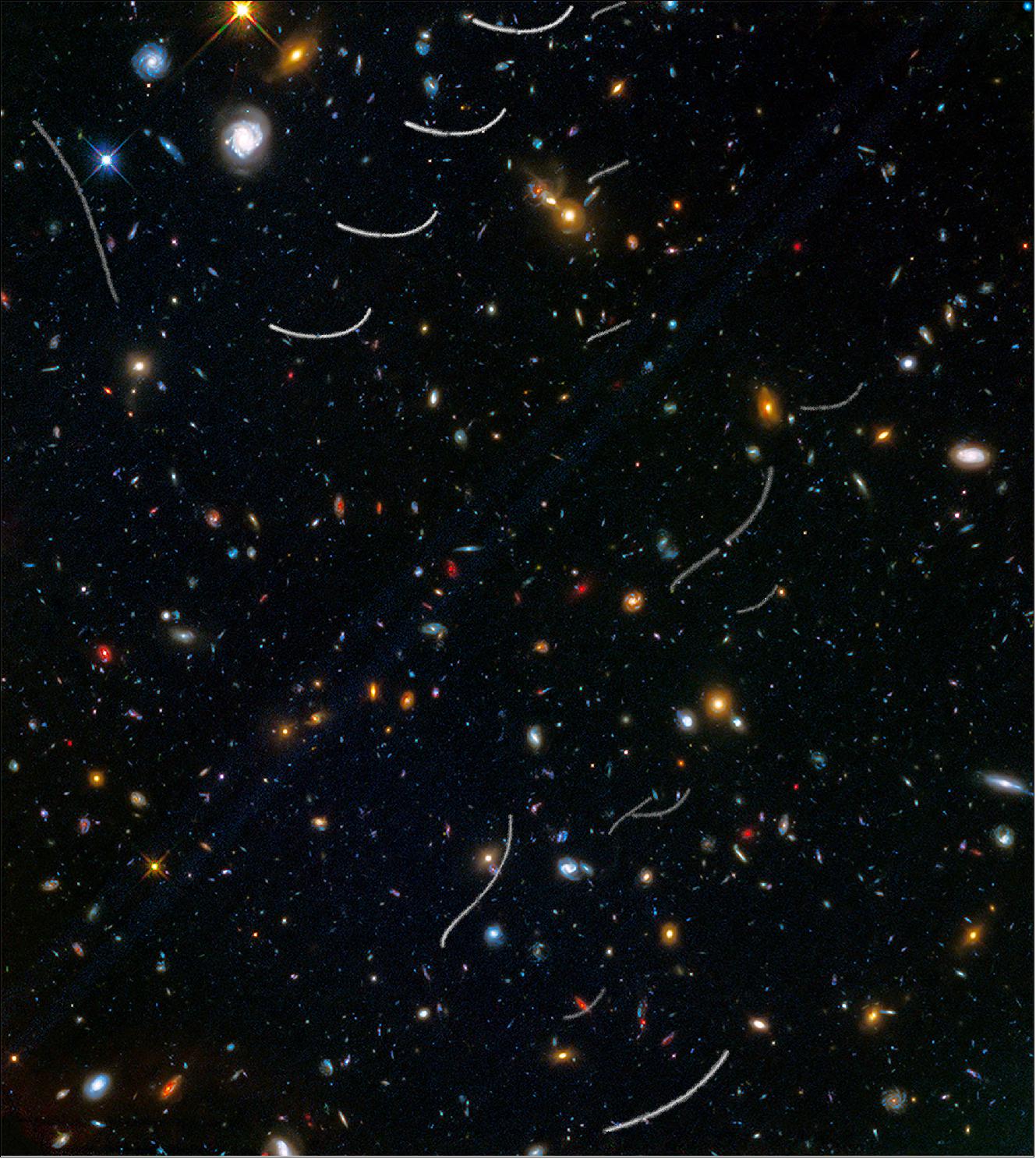
- While observing each cluster with one of the cameras on Hubble, the team also used a different camera, pointing in a slightly different direction, to photograph six so-called ‘parallel fields’. This maximized Hubble’s observational efficiency in doing deep space exposures, imaging a myriad of far away galaxies.
- The picture of Figure 42, first published in 2017, shows the parallel field for the galaxy cluster Abell 370. It was assembled from images taken in visible and infrared light and contains thousands of galaxies, including massive yellowish ellipticals and majestic blue spirals. Much smaller, fragmentary blue galaxies are sprinkled throughout the field. The reddest objects are most likely the farthest galaxies, whose light has been stretched into the red part of the spectrum by the expansion of space.
- The position of this field on the sky is near the ecliptic, the plane of our Solar System. This is the region in which most asteroids orbit the Sun, which is why Hubble astronomers saw so many crossings. Hubble deep-sky observations taken along a line-of-sight near the plane of our Solar System commonly record asteroid trails.
- Each year on 30 June, the worldwide UN-sanctioned Asteroid Day takes place to raise awareness about asteroids and what can be done to protect Earth from possible impact. The day falls on the anniversary of the Tunguska event that took place on 30 June 1908, the most harmful known asteroid related event in recent history. Follow the 48-hour Asteroid Day livecast from https://asteroidday.org/ this weekend, and join the conversation online via #AsteroidDay2019.
• 21 June 2019: This image shows an irregular galaxy named IC 10, a member of the Local Group — a collectiongrouping of over 50 galaxies within our cosmic neighborhood that includes the Milky Way. 54)
- IC 10 is a remarkable object. It is the closest-known starburst galaxy to us, meaning that it is undergoing a furious bout of star formation fueled by ample supplies of cool hydrogen gas. This gas condensescongeals into vast molecular clouds, which then formcondense into dense knots where pressures and temperatures reach a point sufficient to ignite nuclear fusion, thus giving rise to new generations of stars.
- A version of this image was entered into the Hubble's Hidden Treasures image processing competition by contestant Nikolaus Sulzenauer, and went on to win tenth prize.
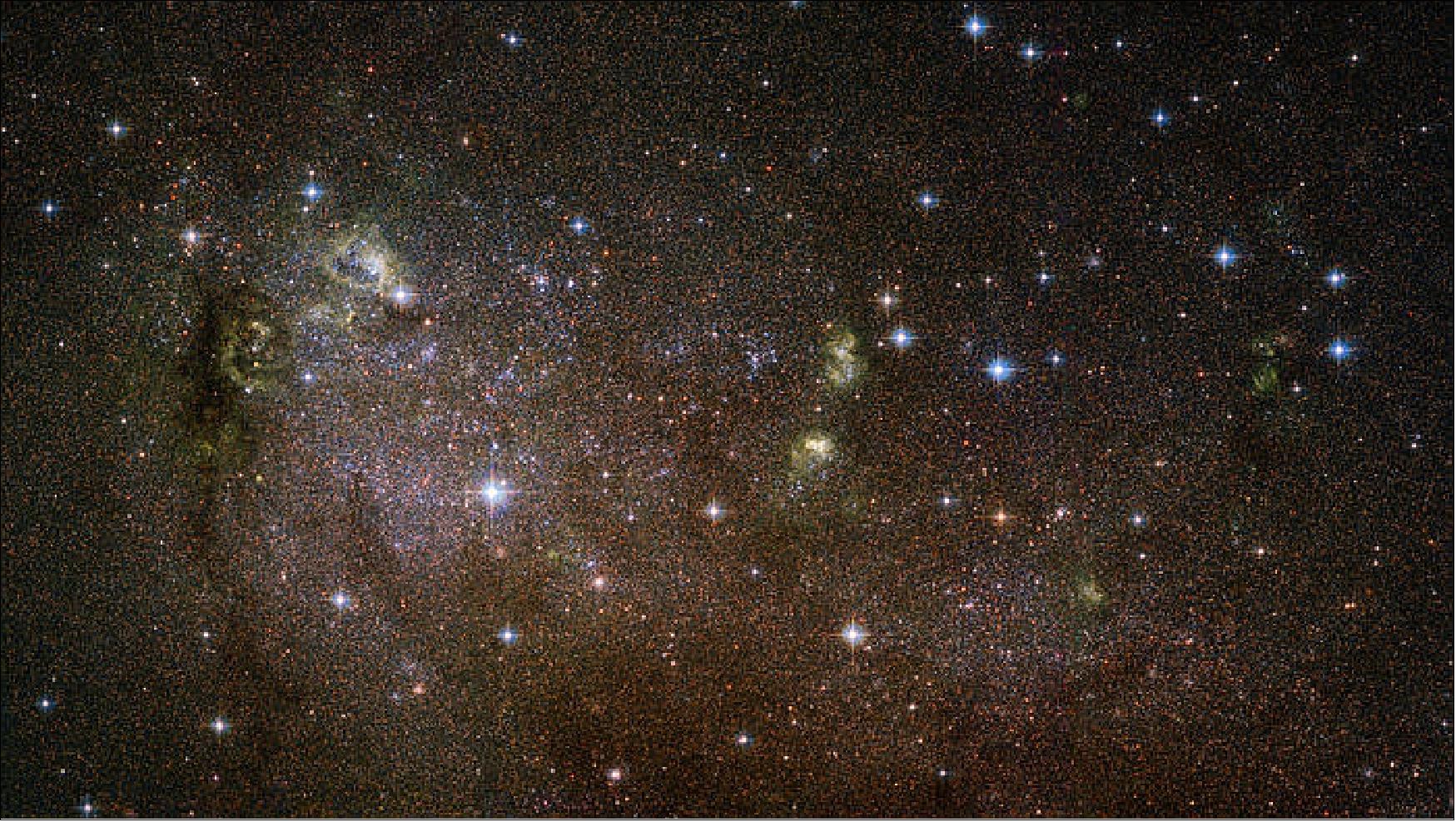
• 13 June 2019: Located about 30 million light-years away in the constellation of Pyxis (The Compass), ESO 495-21 is a dwarf starburst galaxy — this means that it is small in size, but ablaze with rapid bursts of star formation. Starburst galaxies form stars at exceptionally high rates, creating stellar newborns of up to 1000 times faster than the Milky Way. 55)
- Hubble has studied the bursts of activity within ESO 495-21 several times. Notably, the space telescope has explored the galaxy’s multiple super star clusters, very dense regions only a few million years old and packed with massive stars. These spectacular areas can have a huge impact on their host galaxies. Studying them allows astronomers to investigate the earliest stages of their evolution, in a bid to understand how massive stars form and change throughout the Universe.
- As well as hosting the cosmic fireworks that are super star clusters, ESO 495-21 also may harbor a supermassive black hole at its core. Astronomers know that almost every large galaxy hosts such an object at its center, and, in general, the bigger the galaxy, the more massive the black hole. Our home galaxy, the Milky Way, houses a supermassive black hole, Sagittarius A*, which is over four million times as massive as the Sun. ESO 495-21, also known as Henize 2-10) is a dwarf galaxy, only three percent the size of the Milky Way, and yet there are indications that the black hole at its core is over a million times as massive as the Sun — an extremely unusual scenario.
- This black hole may offer clues as to how black holes and galaxies evolved in the early Universe. The origin of the central supermassive black holes in galaxies is still a matter of debate — do the galaxies form first and then crush material at their centers into black holes, or do pre-existing black holes gather galaxies around them? Do they evolve together — or could the answer be something else entirely?
- With its small size, indistinct shape, and rapid starburst activity, astronomers think ESO 495-21 may be an analogue for some of the first galaxies to have formed in the cosmos. Finding a black hole at the galaxy’s heart is therefore a strong indication that black holes may have formed first, with galaxies later developing and evolving around them.
- The data comprising this image were gathered by two of the instruments aboard the NASA/ESA Hubble Space Telescope: the Advanced Camera for Surveys and already decommissioned Wide Field Planetary Camera 2.
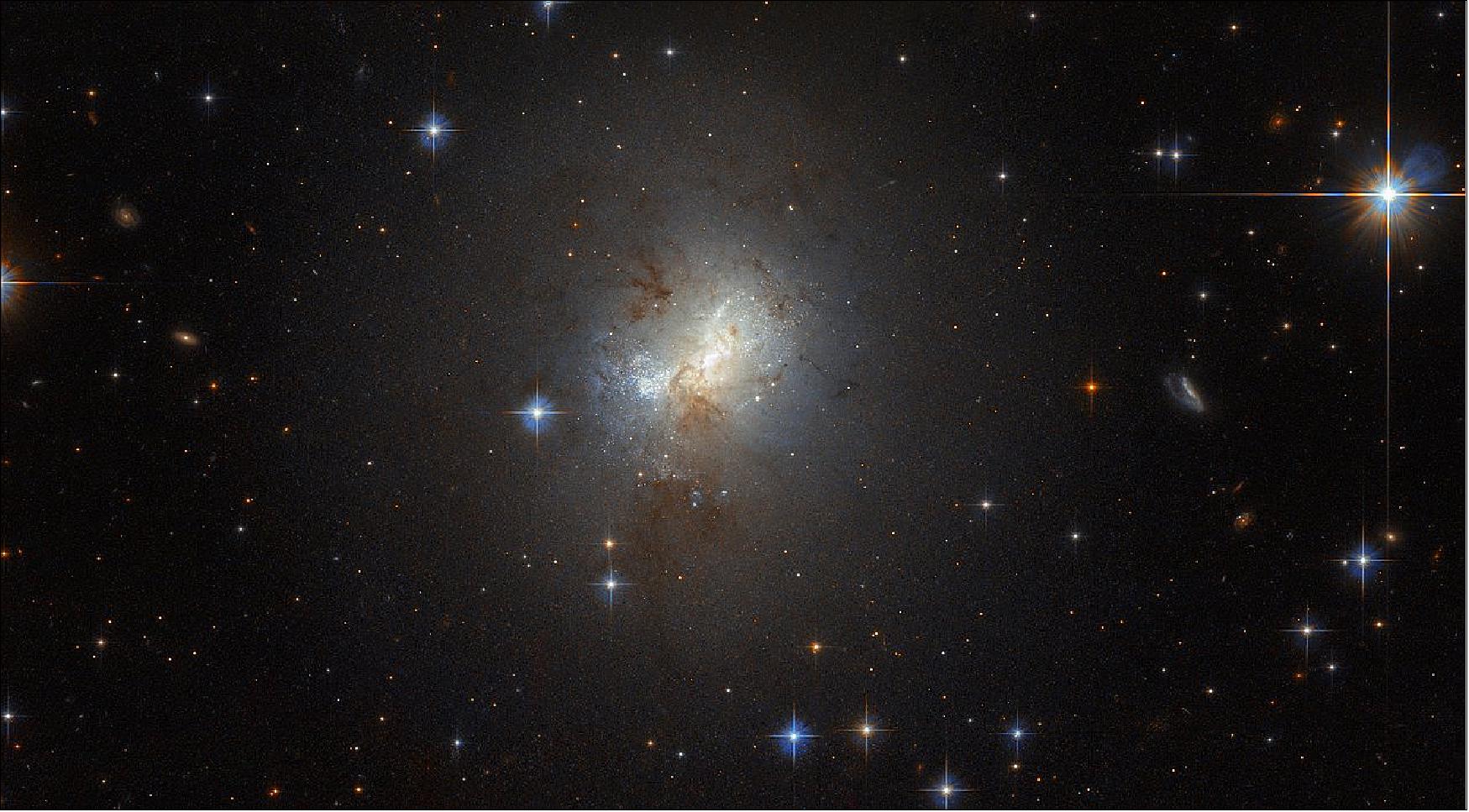
• 07 June 2019: This striking image was taken by the NASA/ESA Hubble Space Telescope’s WFC3 (Wide Field Camera 3), a powerful instrument installed on the telescope in 2009. WFC3 is responsible for many of Hubble’s most breathtaking and iconic photographs, including Pictures of the Week. 56) 57)
- By studying galactic specimens such as NGC 7773 throughout the Universe, researchers hope to learn more about the processes that have shaped — and continue to shape — our cosmic home.
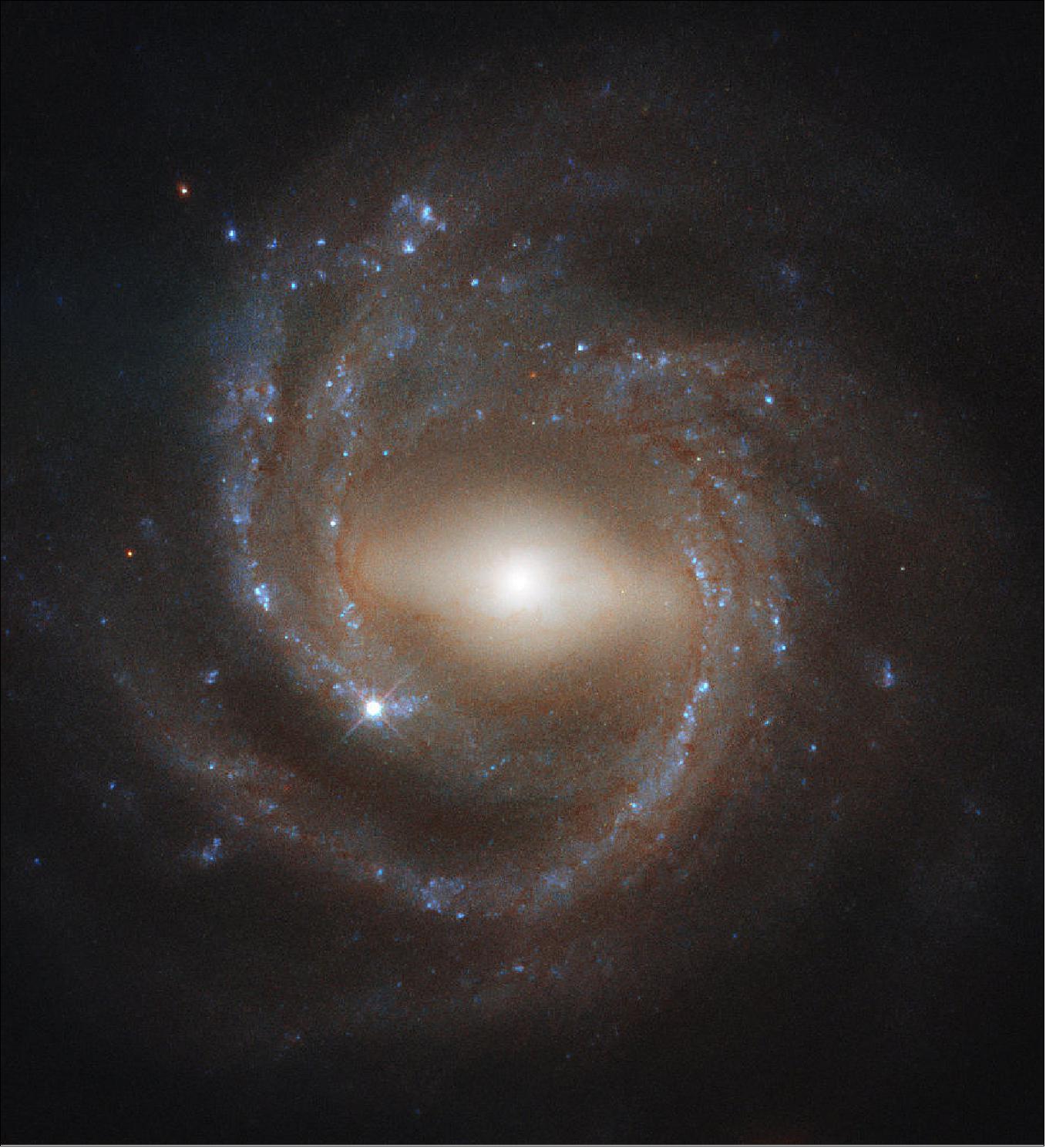
• 03 June 2019: Astronomers have directly imaged two exoplanets that are gravitationally carving out a wide gap within a planet-forming disk surrounding a young star. While over a dozen exoplanets have been directly imaged, this is only the second multi-planet system to be photographed. (The first was a four-planet system orbiting the star HR 8799.) Unlike HR 8799, though, the planets in this system are still growing by accreting material from the disk. 58)
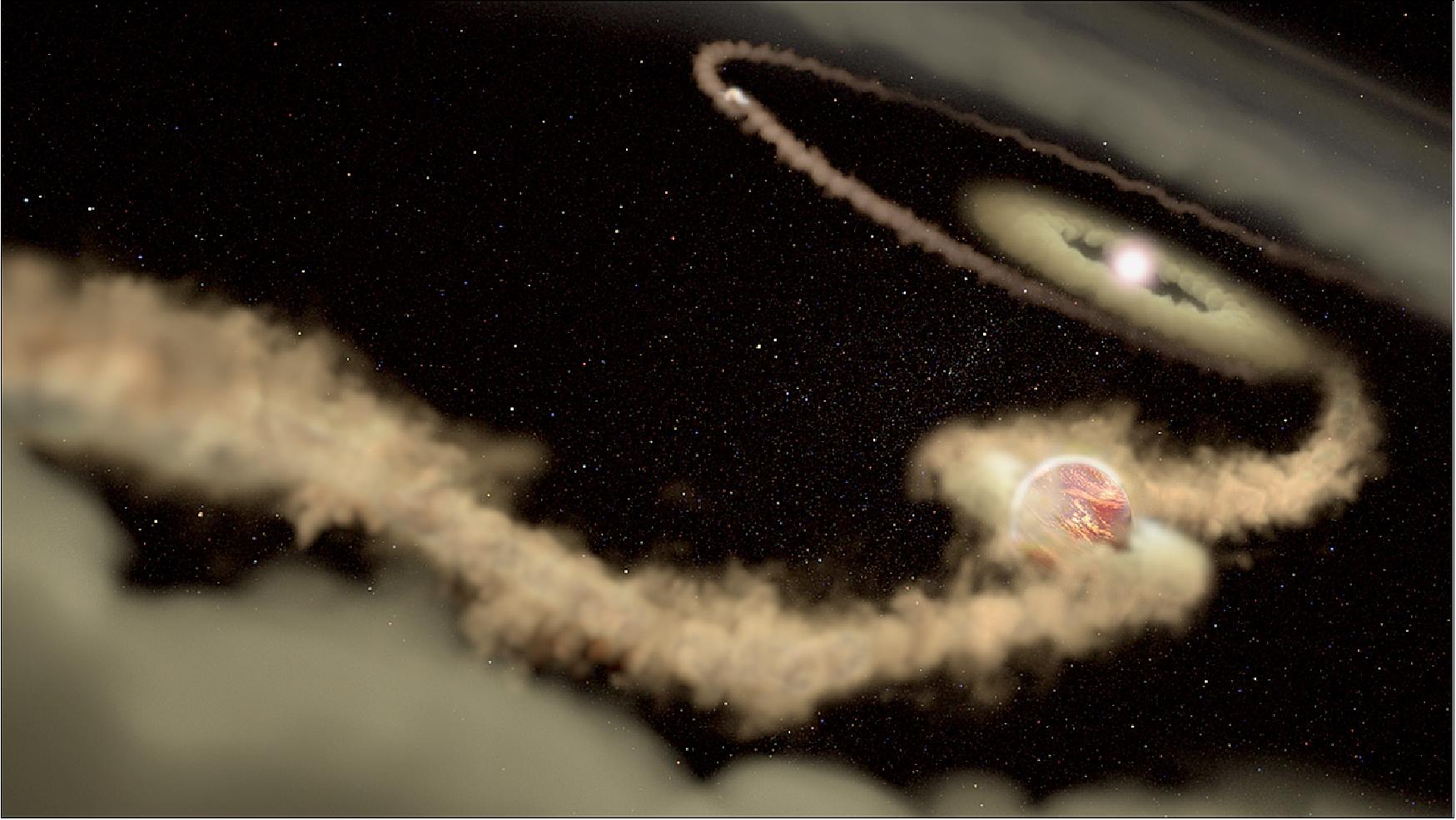
- “This is the first unambiguous detection of a two-planet system carving a disk gap,” said Julien Girard of the Space Telescope Science Institute in Baltimore, Maryland.
- The host star, known as PDS 70, is located about 370 light-years from Earth. The young 6-million-year-old star is slightly smaller and less massive than our Sun, and is still accreting gas. It is surrounded by a disk of gas and dust that has a large gap extending from about 1.9 to 3.8 billion miles.
- PDS 70 b, the innermost known planet, is located within the disk gap at a distance of about 2 billion miles from its star, similar to the orbit of Uranus in our solar system. The team estimates that it weighs anywhere from 4 to 17 times as much as Jupiter. It was first detected in 2018.
- PDS 70 c, the newly discovered planet, is located near the outer edge of the disk gap at about 3.3 billion miles from the star, similar to Neptune’s distance from our Sun. It is less massive than planet b, weighing between 1 and 10 times as much as Jupiter. The two planetary orbits are near a 2-to-1 resonance, meaning that the inner planet circles the star twice in the time it takes the outer planet to go around once.
- The discovery of these two worlds is significant because it provides direct evidence that forming planets can sweep enough material out of a protoplanetary disk to create an observable gap.
- “With facilities like ALMA, Hubble, or large ground-based optical telescopes with adaptive optics we see disks with rings and gaps all over. The open question has been, are there planets there? In this case, the answer is yes,” explained Girard.
- The team detected PDS 70 c from the ground, using the MUSE spectrograph on the European Southern Observatory’s Very Large Telescope (VLT). Their new technique relied on the combination of the high spatial resolution provided by the 8-meter telescope equipped with four lasers and the instrument’s medium spectral resolution that allows it to “lock onto” light emitted by hydrogen, which is a sign of gas accretion.
- “This new observing mode was developed to study galaxies and star clusters at higher spatial resolution. But this new mode also makes it suitable for exoplanet imaging, which was not the original science driver for the MUSE instrument,” said Sebastiaan Haffert of Leiden Observatory, lead author on the paper. ”We were very surprised when we found the second planet,” Haffert added. 59)
- In the future, NASA’s James Webb Space Telescope may be able to study this system and other planet nurseries using a similar spectral technique to narrow in on various wavelengths of light from hydrogen. This would allow scientists to measure the temperature and density of gas within the disk, which would help our understanding of the growth of gas giant planets. The system might also be targeted by the WFIRST mission, which will carry a high-performance coronagraph technology demonstration that can block out the star’s light to reveal fainter light from the surrounding disk and companion planets.
• 31 May 2019: This luminous orb is the galaxy NGC 4621, better known as Messier 59 (Figure 47). As this latter moniker indicates, the galaxy is listed in the famous catalog of deep-sky objects compiled by French comet-hunter Charles Messier in the 18th century. However, German astronomer Johann Gottfried Koehler is credited with discovering the galaxy just days before Messier added it to his collection in 1779. 60)
- Located in the 2,000-strong Virgo cluster of galaxies within the constellation of Virgo (the Virgin), Messier 59 lies approximately 50 million light-years away from us. This image was taken by the NASA/ESA Hubble Space Telescope’s Advanced Camera for Surveys.
- Messier 59 is featured in Hubble’s Messier catalog, which includes some of the most fascinating objects that can be observed from Earth’s Northern Hemisphere. See the NASA-processed image and other Messier objects at: https://www.nasa.gov/content/goddard/hubble-s-messier-catalog
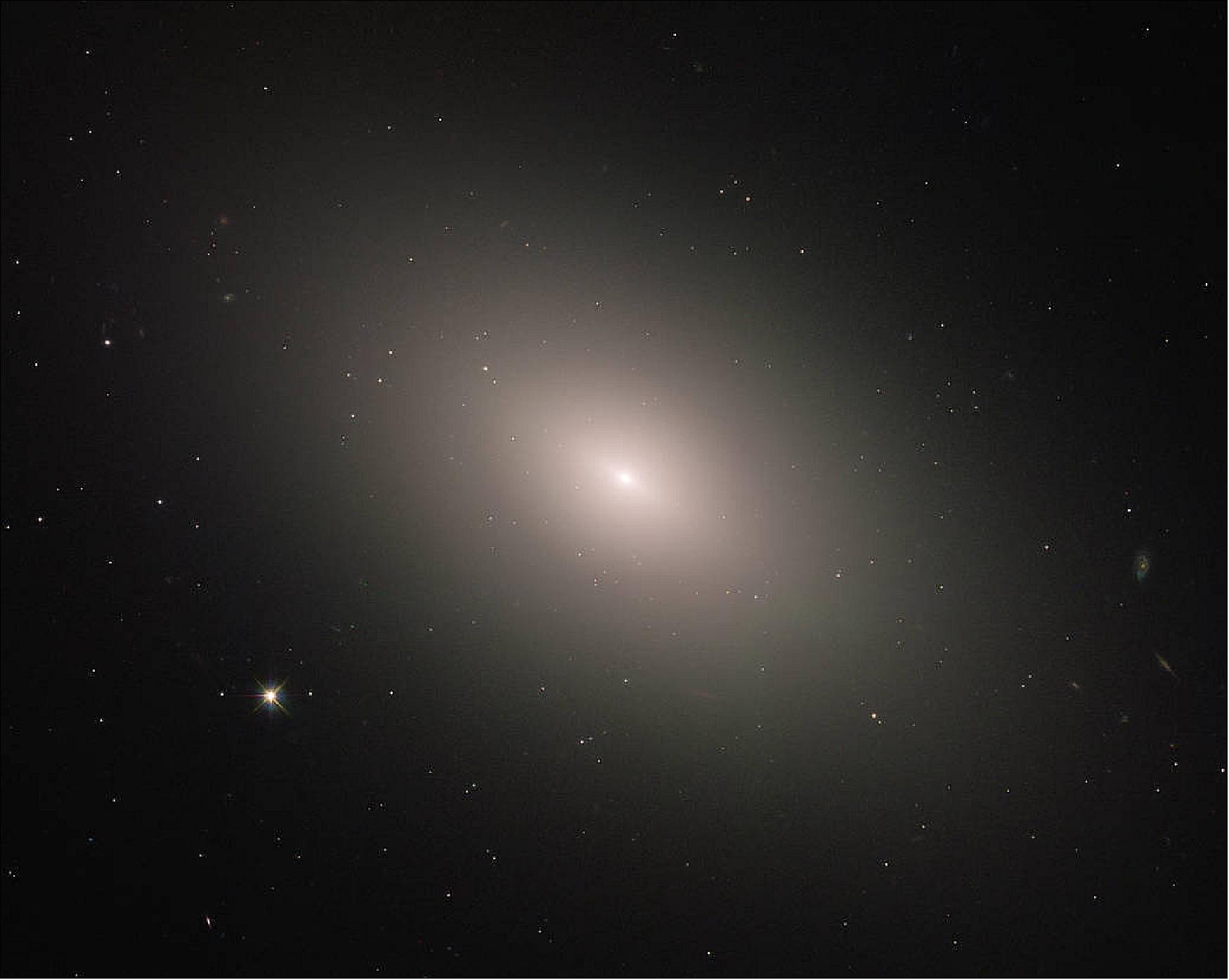
• 16 May 2019: The irregular galaxy NGC 4485 has been involved in a dramatic gravitational interplay with its larger galactic neighbor NGC 4490 — out of frame to the bottom right in this image. Found about 30 million light-years away in the constellation of Canes Venatici (the Hunting Dogs), the strange result of these interacting galaxies has resulted in an entry in the Atlas of Peculiar galaxies: Arp 269. 61)
- Having already made their closest approach, NGC 4485 and NGC 4490 are now moving away from each other, vastly altered from their original states. Still engaged in a destructive yet creative dance, the gravitational force between them continues to warp each of them out of all recognition, while at the same time creating the conditions for huge regions of intense star formation.
- This galactic tug-of-war has created a stream of material about 25,000 light-years long which connects the two galaxies. The stream is made up of bright knots and huge pockets of gassy regions, as well as enormous regions of star formation in which young, massive, blue stars are born. Short-lived, however, these stars quickly run out of fuel and end their lives in dramatic explosions. While such an event seems to be purely destructive, it also enriches the cosmic environment with heavier elements and delivers new material to form a new generation of stars.
- Two very different regions are now apparent in NGC 4485; on the left are hints of the galaxy’s previous spiral structure, which was at one time undergoing “normal” galactic evolution. The right of the image reveals a portion of the galaxy ripped towards its larger neighbor, bursting with hot, blue stars and streams of dust and gas.
- This image, captured by the Wide Field Camera 3 (WFC3) on the Hubble Space Telescope, adds light through two new filters compared with an image released in 2014. The new data provide further insights into the complex and mysterious field of galaxy evolution.
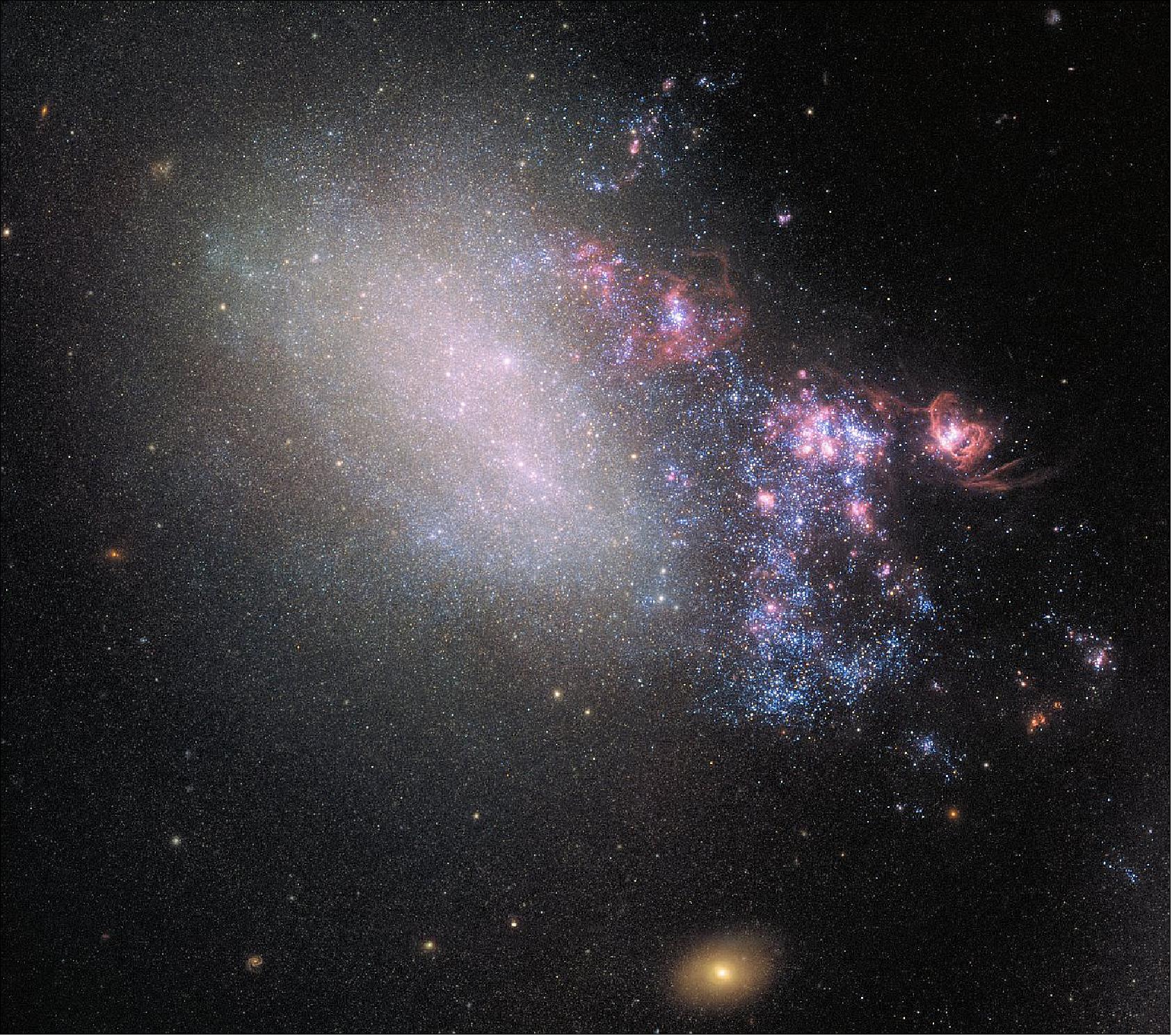
• 10 May 2019: Dotted across the sky in the constellation of Pictor (The Painter’s Easel) is the galaxy cluster highlighted here by the NASA/ESA Hubble Space Telescope: SPT-CL J0615-5746, or SPT0615 for short. First discovered by the South Pole Telescope less than a decade ago, SPT0615 is exceptional among the myriad clusters so far catalogued in our map of the Universe — it is the highest-redshift cluster for which a full, strong lens model is published. 62)
- SPT0615 is a massive cluster of galaxies, one of the farthest observed to cause gravitational lensing. Gravitational lensing occurs when light from a background object is deflected around mass between the object and the observer. Among the identified background objects, there is SPT0615-JD, a galaxy that is thought to have emerged just 500 million years after the Big Bang. This puts it among the very earliest structures to form in the Universe. It is also the farthest galaxy ever imaged by means of gravitational lensing.
- Just as ancient paintings can tell us about the period of history in which they were painted, so too can ancient galaxies tell us about the era of the Universe in which they existed. To learn about cosmological history, astronomers explore the most distant reaches of the Universe, probing ever further out into the cosmos. The light from distant objects travels to us from so far away that it takes an immensely long time to reach us, meaning that it carries information from the past — information about the time at which it was emitted.
- By studying such distant objects, astronomers are continuing to fill the gaps in our picture of what the very early Universe looked like, and uncover more about how it evolved into its current state.
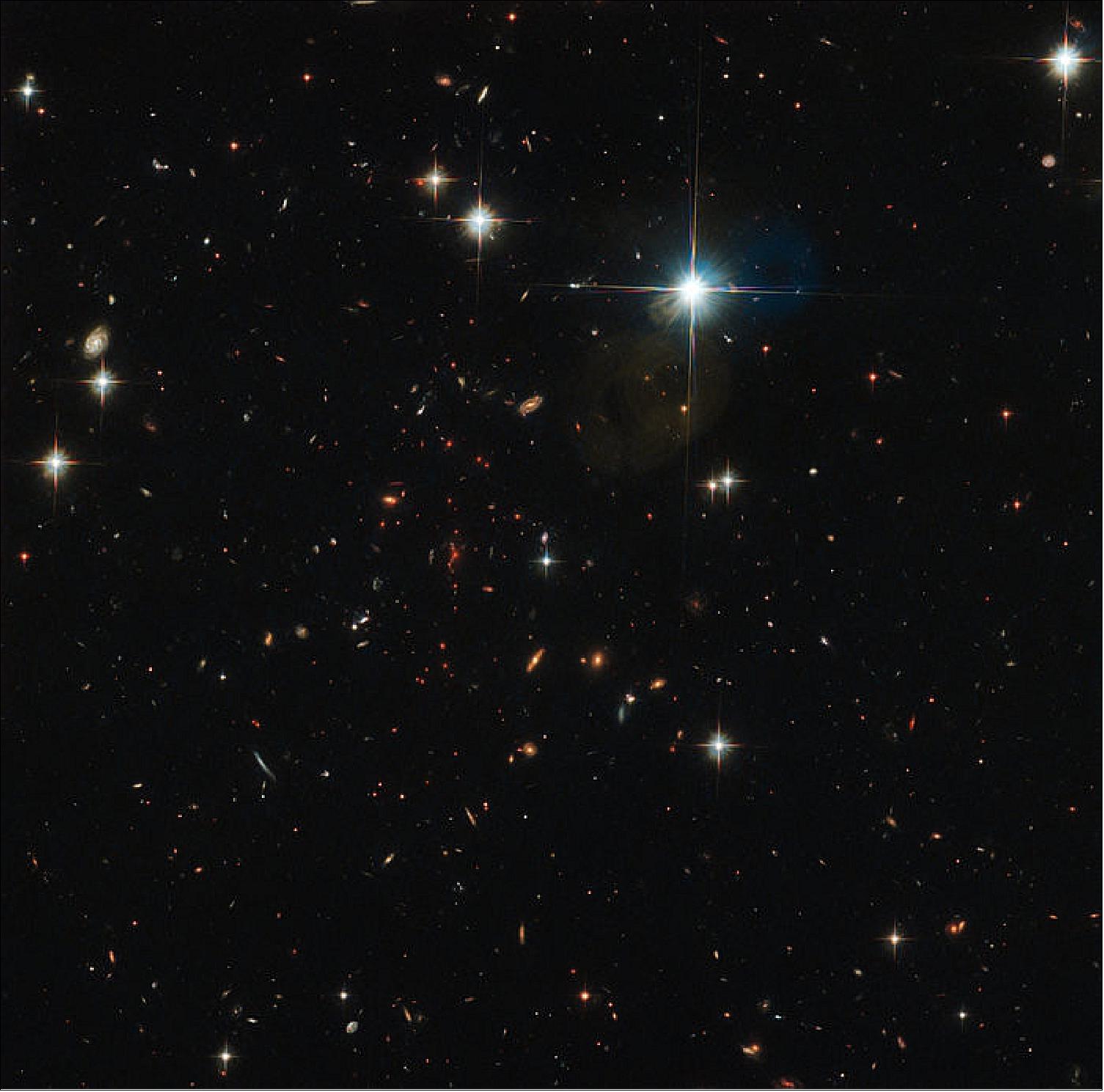
• 03 May 2019: Few of the universe’s residents are as iconic as the spiral galaxy. These limelight-hogging celestial objects combine whirling, pinwheeling arms with scatterings of sparkling stars, glowing bursts of gas, and dark, weaving lanes of cosmic dust, creating truly awesome scenes — especially when viewed through a telescope such as the NASA/ESA Hubble Space Telescope. In fact, this image from Hubble frames a perfect spiral specimen: the stunning NGC 2903. 63)
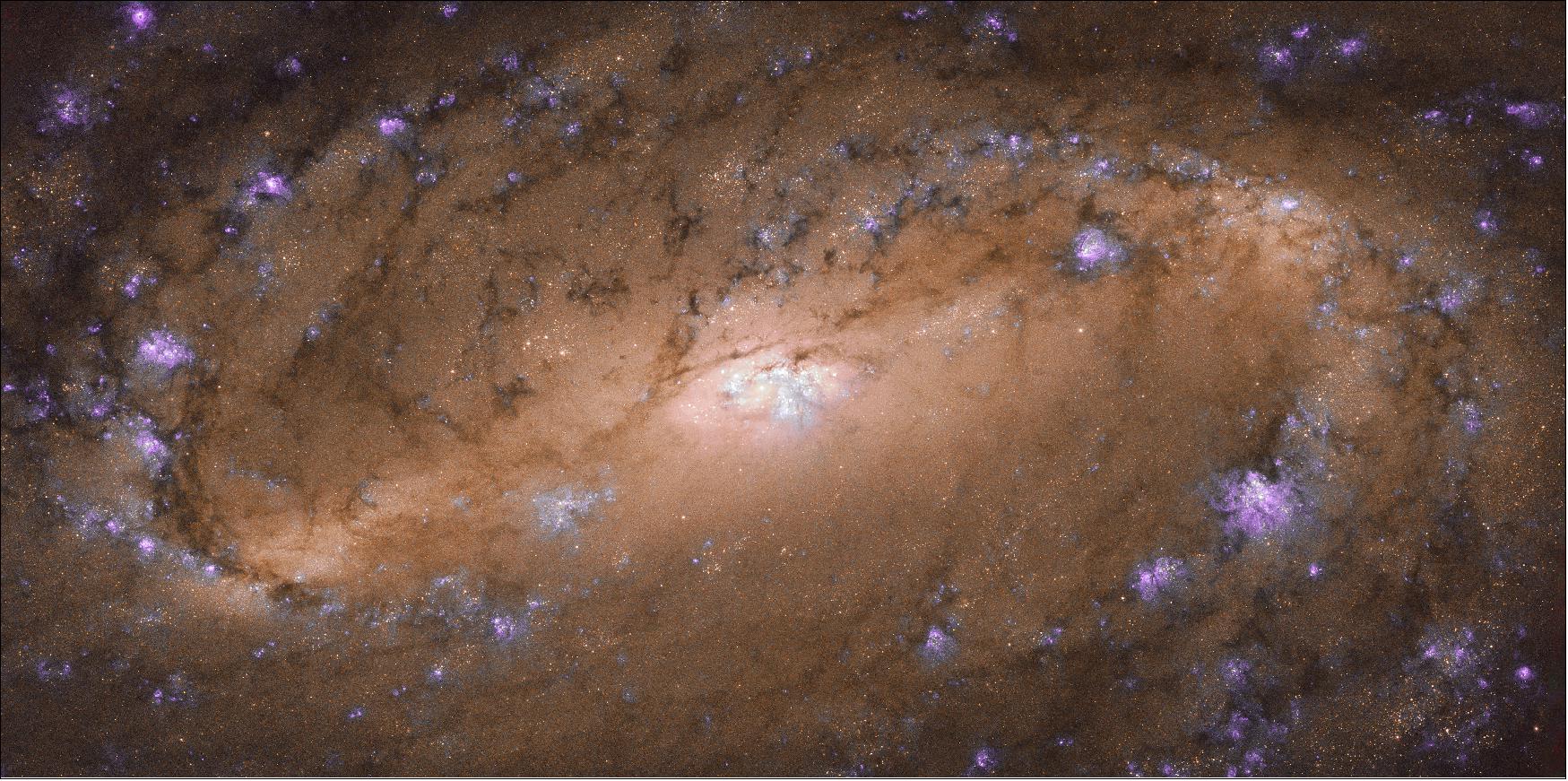
• 02 May 2019: Astronomers have put together the largest and most comprehensive "history book" of galaxies into one single image, using 16 years' worth of observations from NASA's Hubble Space Telescope. 64)
- The deep-sky mosaic, created from nearly 7,500 individual exposures, provides a wide portrait of the distant universe, containing 265,000 galaxies that stretch back through 13.3 billion years of time to just 500 million years after the big bang. The faintest and farthest galaxies are just one ten-billionth the brightness of what the human eye can see. The universe's evolutionary history is also chronicled in this one sweeping view. The portrait shows how galaxies change over time, building themselves up to become the giant galaxies seen in the nearby universe.
- This ambitious endeavor, called the Hubble Legacy Field, also combines observations taken by several Hubble deep-field surveys, including the eXtreme Deep Field (XDF), the deepest view of the universe. The wavelength range stretches from ultraviolet to near-infrared light, capturing the key features of galaxy assembly over time.
- "Now that we have gone wider than in previous surveys, we are harvesting many more distant galaxies in the largest such dataset ever produced by Hubble," said Garth Illingworth of the University of California, Santa Cruz, leader of the team that assembled the image. "This one image contains the full history of the growth of galaxies in the universe, from their time as 'infants' to when they grew into fully fledged 'adults.'"
- No image will surpass this one until future space telescopes are launched. "We've put together this mosaic as a tool to be used by us and by other astronomers," Illingworth added. "The expectation is that this survey will lead to an even more coherent, in-depth and greater understanding of the universe's evolution in the coming years."
- The image yields a huge catalog of distant galaxies. "Such exquisite high-resolution measurements of the numerous galaxies in this catalog enable a wide swath of extragalactic study," said catalog lead researcher Katherine Whitaker of the University of Connecticut, in Storrs. "Often, these kinds of surveys have yielded unanticipated discoveries which have had the greatest impact on our understanding of galaxy evolution."
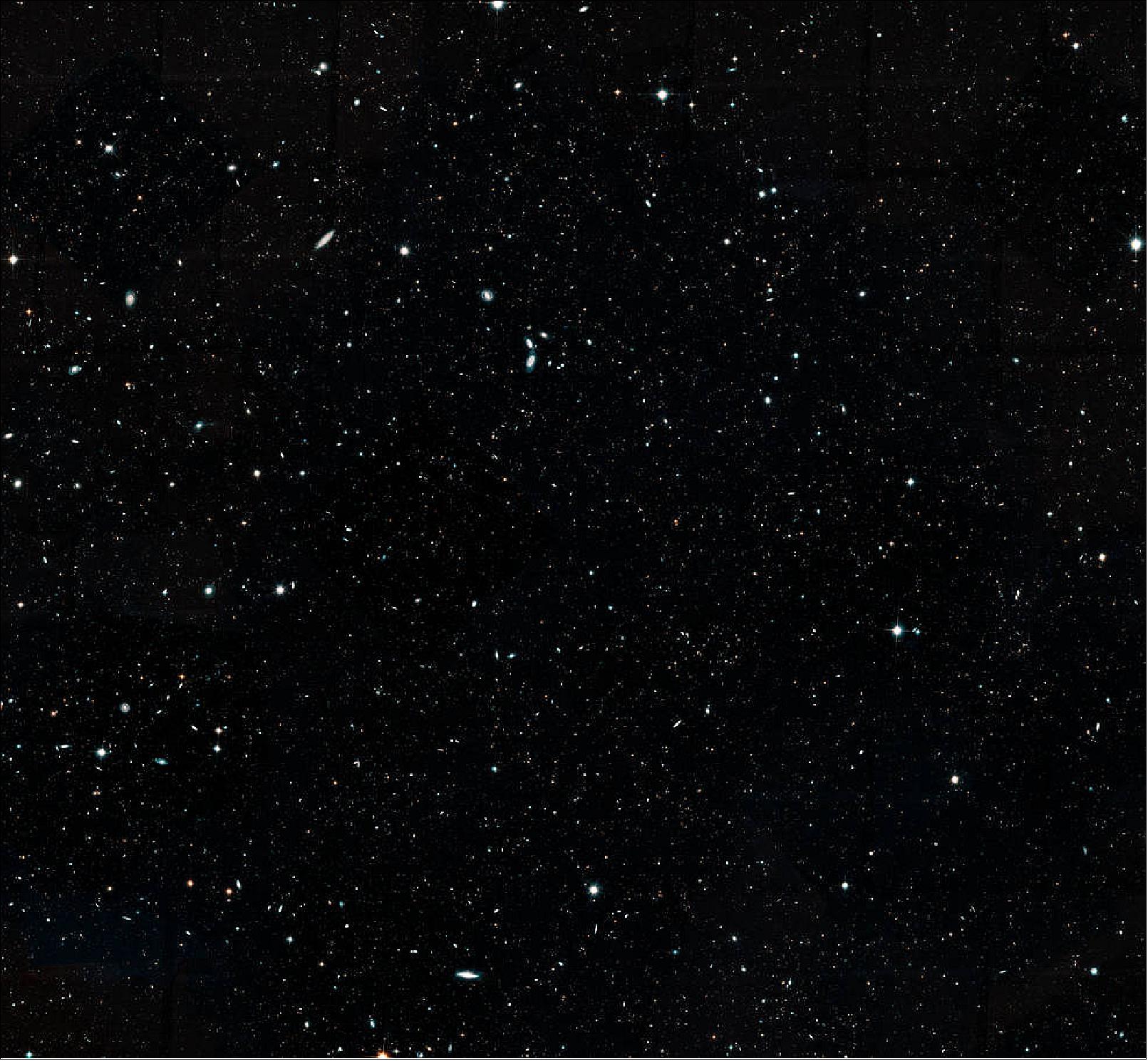
- Galaxies are the "markers of space," as astronomer Edwin Hubble once described them a century ago. Galaxies allow astronomers to trace the expansion of the universe, offer clues to the underlying physics of the cosmos, show when the chemical elements originated, and enable the conditions that eventually led to the appearance of our solar system and life.
- This wider view contains about 30 times as many galaxies as in the previous deep fields. The new portrait, a mosaic of multiple snapshots, covers almost the width of the full Moon. The XDF, which penetrated deeper into space than this wider view, lies in this region, but it covers less than one-tenth of the full Moon's diameter. The Legacy Field also uncovers a zoo of unusual objects. Many of them are the remnants of galactic "train wrecks," a time in the early universe when small, young galaxies collided and merged with other galaxies.

- Assembling all of the observations was an immense task. The image comprises the collective work of 31 Hubble programs by different teams of astronomers. Hubble has spent more time on this tiny area than on any other region of the sky, totaling more than 250 days, representing nearly three-quarters of a year.
- "Our goal was to assemble all 16 years of exposures into a legacy image," explained Dan Magee, of the University of California, Santa Cruz, the team's data processing lead. "Previously, most of these exposures had not been put together in a consistent way that can be used by any researcher. Astronomers can select the data in the Legacy Field they want and work with it immediately, as opposed to having to perform a huge amount of data reduction before conducting scientific analysis."
- The image, along with the individual exposures that make up the new view, is available to the worldwide astronomical community through the Mikulski Archive for Space Telescopes (MAST). MAST, an online database of astronomical data from Hubble and other NASA missions, is located at the STScI (Space Telescope Science Institute) in Baltimore, Maryland.
- The Hubble Space Telescope has come a long way in taking ever deeper "core samples" of the distant universe. After Hubble's launch in 1990, astronomers debated if it was worth spending a chunk of the telescope's time to go on a "fishing expedition" to take a very long exposure of a small, seemingly blank piece of sky. The resulting Hubble Deep Field image in 1995 captured several thousand unseen galaxies in one pointing. The bold effort was a landmark demonstration and a defining proof-of-concept that set the stage for future deep field images. In 2002, Hubble's Advanced Camera for Surveys went even deeper to uncover 10,000 galaxies in a single snapshot. Astronomers used exposures taken by Hubble's Wide Field Camera 3 (WFC3), installed in 2009, to assemble the eXtreme Deep Field snapshot in 2012. Unlike previous Hubble cameras, the telescope's WFC3 covers a broader wavelength range, from ultraviolet to near-infrared.
- This new image mosaic is the first in a series of Hubble Legacy Field images. The team is working on a second set of images, totaling more than 5,200 Hubble exposures, in another area of the sky. In the future, astronomers hope to broaden the multiwavelength range in the legacy images to include longer-wavelength infrared data and high-energy X-ray observations from two other NASA Great Observatories, the Spitzer Space Telescope and Chandra X-ray Observatory.
- The vast number of galaxies in the Legacy Field image are also prime targets for future telescopes. "This will really set the stage for NASA's planned Wide Field Infrared Survey Telescope (WFIRST)," Illingworth said. "The Legacy Field is a pathfinder for WFIRST, which will capture an image that is 100 times larger than a typical Hubble photo. In just three weeks' worth of observations by WFIRST, astronomers will be able to assemble a field that is much deeper and more than twice as large as the Hubble Legacy Field."
- In addition, NASA's upcoming James Webb Space Telescope will allow astronomers to push much deeper into the legacy field to reveal how the infant galaxies actually grew. Webb's infrared coverage will go beyond the limits of Hubble and Spitzer to help astronomers identify the first galaxies in the universe.
- The Hubble Space Telescope is a project of international cooperation between NASA and ESA (European Space Agency). NASA's Goddard Space Flight Center in Greenbelt, Maryland, manages the telescope. The Space Telescope Science Institute (STScI) in Baltimore, Maryland, conducts Hubble science operations. STScI is operated for NASA by the Association of Universities for Research in Astronomy in Washington, D.C.
• 26 April 2019: Messier 75 lies in the constellation of Sagittarius (The Archer), around 67,000 light-years away from Earth. The majority of the cluster’s stars, about 400,000 intotal, are found in its core; it is one of the most densely populated clusters ever found, with a phenomenal luminosity of some 180,000 times that of the Sun. No wonder it photographs so well! 65)
- Discovered in 1780 by Pierre Méchain, Messier 75 was also observed by Charles Messier and added to his catalog later that year. This image of Messier 75 was captured by the NASA/ESA Hubble Space Telescope’s AWS (Advanced Camera for Surveys).
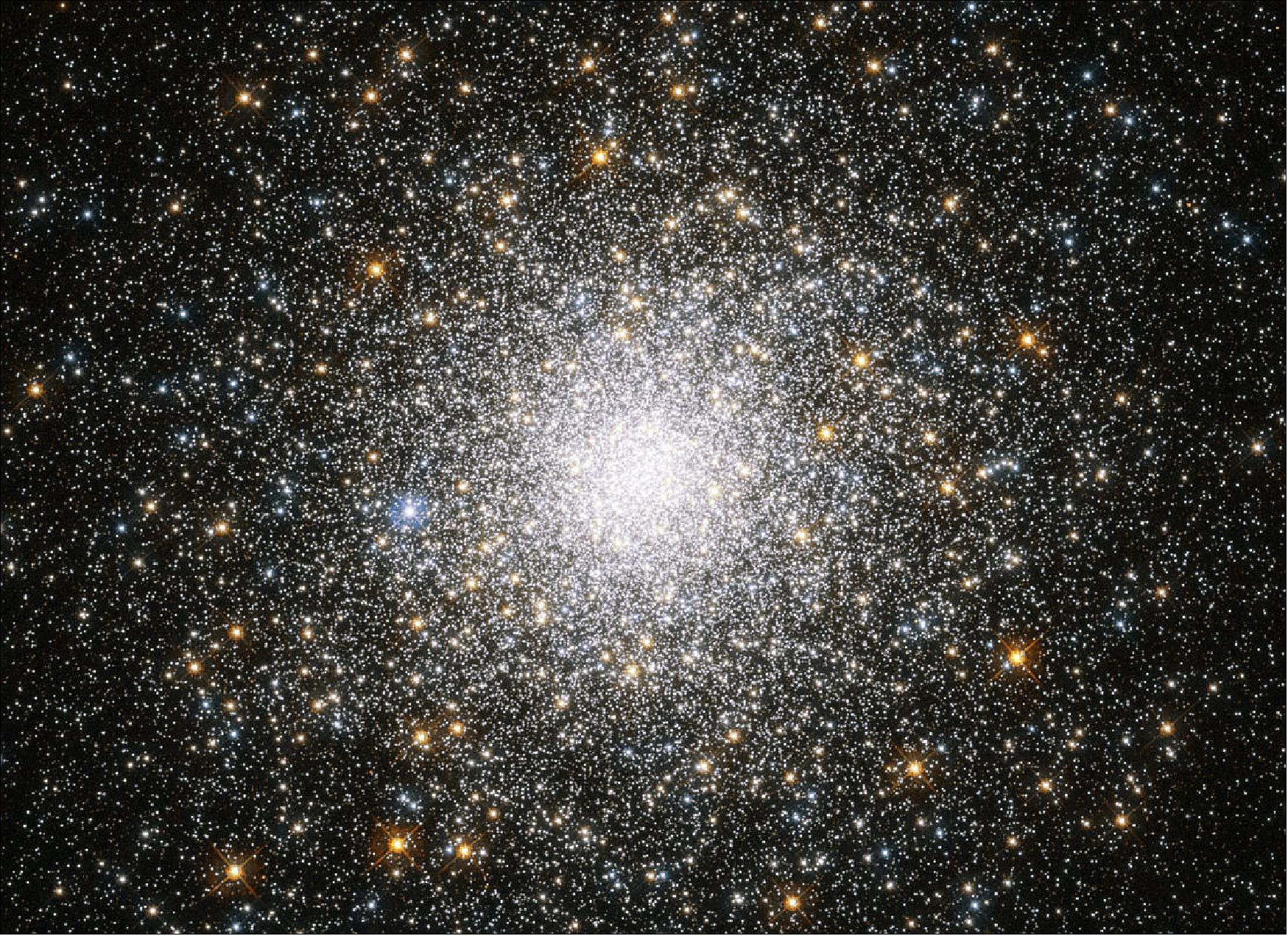
• 25 April 2019: Astronomers using NASA's Hubble Space Telescope say they have crossed an important threshold in revealing a discrepancy between the two key techniques for measuring the universe's expansion rate. The recent study strengthens the case that new theories may be needed to explain the forces that have shaped the cosmos. 66)
- A brief recap: The universe is getting bigger every second. The space between galaxies is stretching, like dough rising in the oven. But how fast is the universe expanding? As Hubble and other telescopes seek to answer this question, they have run into an intriguing difference between what scientists predict and what they observe.
- Hubble Space Telescope measurements suggest a faster expansion rate in the modern universe than expected, based on how the universe appeared more than 13 billion years ago. These measurements of the early universe come from the European Space Agency's Planck satellite. This discrepancy has been identified in scientific papers over the last several years, but it has been unclear whether differences in measurement techniques are to blame, or whether the difference could result from unlucky measurements.
- The latest Hubble data lower the possibility that the discrepancy is only a fluke to 1 in 100,000. This is a significant gain from an earlier estimate, less than a year ago, of a chance of 1 in 3,000.
- These most precise Hubble measurements to date bolster the idea that new physics may be needed to explain the mismatch.
- "The Hubble tension between the early and late universe may be the most exciting development in cosmology in decades," said lead researcher and Nobel laureate Adam Riess of the Space Telescope Science Institute (STScI) and Johns Hopkins University, in Baltimore, Maryland. "This mismatch has been growing and has now reached a point that is really impossible to dismiss as a fluke. This disparity could not plausibly occur just by chance."
![Figure 56: Large Magellanic Cloud [DSS (Digitized Sky Survey)View] with Star Cluster Overlay (Hubble), image credit: NASA, ESA, and A. Riess (STScI/JHU)](/api/cms/documents/163813/5502378/Hubble2019_Auto19.jpeg)
![Figure 57: Three Steps to the Hubble Constant [image credit: NASA, ESA, and A. Riess (STScI/JHU)]](/api/cms/documents/163813/5502378/Hubble2019_Auto18.jpeg)
![Figure 58: Compass Image of Large Magellanic Cloud [image credit: NASA, ESA, and A. Riess (STScI/JHU)]](/api/cms/documents/163813/5502378/Hubble2019_Auto17.jpeg)
Tightening the Bolts on the 'Cosmic Distance Ladder'
- Scientists use a "cosmic distance ladder" to determine how far away things are in the universe. This method depends on making accurate measurements of distances to nearby galaxies and then moving to galaxies farther and farther away, using their stars as milepost markers. Astronomers use these values, along with other measurements of the galaxies' light that reddens as it passes through a stretching universe, to calculate how fast the cosmos expands with time, a value known as the Hubble constant. Riess and his SH0ES (Supernovae H0 for the Equation of State) team have been on a quest since 2005 to refine those distance measurements with Hubble and fine-tune the Hubble constant.
- In this new study, astronomers used Hubble to observe 70 pulsating stars called Cepheid variables in the Large Magellanic Cloud. The observations helped the astronomers "rebuild" the distance ladder by improving the comparison between those Cepheids and their more distant cousins in the galactic hosts of supernovas. Riess's team reduced the uncertainty in their Hubble constant value to 1.9% from an earlier estimate of 2.2%.
- As the team's measurements have become more precise, their calculation of the Hubble constant has remained at odds with the expected value derived from observations of the early universe's expansion. Those measurements were made by Planck, which maps the cosmic microwave background, a relic afterglow from 380,000 years after the big bang.
- The measurements have been thoroughly vetted, so astronomers cannot currently dismiss the gap between the two results as due to an error in any single measurement or method. Both values have been tested multiple ways.
- "This is not just two experiments disagreeing," Riess explained. "We are measuring something fundamentally different. One is a measurement of how fast the universe is expanding today, as we see it. The other is a prediction based on the physics of the early universe and on measurements of how fast it ought to be expanding. If these values don't agree, there becomes a very strong likelihood that we're missing something in the cosmological model that connects the two eras."
How the New Study was Done
- Astronomers have been using Cepheid variables as cosmic yardsticks to gauge nearby intergalactic distances for more than a century. But trying to harvest a bunch of these stars was so time-consuming as to be nearly unachievable. So, the team employed a clever new method, called DASH (Drift And Shift), using Hubble as a "point-and-shoot" camera to snap quick images of the extremely bright pulsating stars, which eliminates the time-consuming need for precise pointing.
- "When Hubble uses precise pointing by locking onto guide stars, it can only observe one Cepheid per each 90-minute Hubble orbit around Earth. So, it would be very costly for the telescope to observe each Cepheid," explained team member Stefano Casertano, also of STScI and Johns Hopkins. "Instead, we searched for groups of Cepheids close enough to each other that we could move between them without recalibrating the telescope pointing. These Cepheids are so bright, we only need to observe them for two seconds. This technique is allowing us to observe a dozen Cepheids for the duration of one orbit. So, we stay on gyroscope control and keep 'DASHing' around very fast."
- The Hubble astronomers then combined their result with another set of observations, made by the Araucaria Project, a collaboration between astronomers from institutions in Chile, the U.S., and Europe. This group made distance measurements to the Large Magellanic Cloud by observing the dimming of light as one star passes in front of its partner in eclipsing binary-star systems.
- The combined measurements helped the SH0ES Team refine the Cepheids' true brightness. With this more accurate result, the team could then "tighten the bolts" of the rest of the distance ladder that extends deeper into space.
- The new estimate of the Hubble constant is 74 km (46 miles) per second per megaparsec. This means that for every 3.3 million light-years farther away a galaxy is from us, it appears to be moving 74 km (46 miles) per second faster, as a result of the expansion of the universe. The number indicates that the universe is expanding at a 9% faster rate than the prediction of 67 km (41.6 miles) per second per megaparsec, which comes from Planck's observations of the early universe, coupled with our present understanding of the universe.
- One explanation for the mismatch involves an unexpected appearance of dark energy in the young universe, which is thought to now comprise 70% of the universe's contents. Proposed by astronomers at Johns Hopkins, the theory is dubbed "early dark energy," and suggests that the universe evolved like a three-act play.
- Astronomers have already hypothesized that dark energy existed during the first seconds after the big bang and pushed matter throughout space, starting the initial expansion. Dark energy may also be the reason for the universe's accelerated expansion today. The new theory suggests that there was a third dark-energy episode not long after the big bang, which expanded the universe faster than astronomers had predicted. The existence of this "early dark energy" could account for the tension between the two Hubble constant values, Riess said.
- Another idea is that the universe contains a new subatomic particle that travels close to the speed of light. Such speedy particles are collectively called "dark radiation" and include previously known particles like neutrinos, which are created in nuclear reactions and radioactive decays.
- Yet another attractive possibility is that dark matter (an invisible form of matter not made up of protons, neutrons, and electrons) interacts more strongly with normal matter or radiation than previously assumed.
- But the true explanation is still a mystery.
- Riess doesn't have an answer to this vexing problem, but his team will continue to use Hubble to reduce the uncertainties in the Hubble constant. Their goal is to decrease the uncertainty to 1%, which should help astronomers identify the cause of the discrepancy.
- The team's results have been accepted for publication in The Astrophysical Journal.
- The Hubble Space Telescope is a project of international cooperation between NASA and ESA (European Space Agency). NASA's Goddard Space Flight Center in Greenbelt, Maryland, manages the telescope. The Space Telescope Science Institute (STScI) in Baltimore, Maryland, conducts Hubble science operations. STScI is operated for NASA by the Association of Universities for Research in Astronomy in Washington, D.C.
• On 24 April 1990, the NASA/ESA Hubble Space Telescope was launched on the space shuttle Discovery. It has since revolutionized how astronomers and the general public see the Universe. The images it provides are spectacular from both a scientific and a purely aesthetic point of view. 68)
- Each year the telescope dedicates a small portion of its precious observing time to take a special anniversary image, focused on capturing particularly beautiful and meaningful objects. This year's image is the Southern Crab Nebula, and it is no exception. Note: The Southern Crab Nebula is so named to distinguish it from the better-known Crab Nebula, a supernova remnant visible in the constellation of Taurus.
- This peculiar nebula, which exhibits nested hourglass-shaped structures, has been created by the interaction between a pair of stars at its center. The unequal pair consists of a red giant and a white dwarf. The red giant is shedding its outer layers in the last phase of its life before it too lives out its final years as a white dwarf. Some of the red giant's ejected material is attracted by the gravity of its companion.
- When enough of this cast-off material is pulled onto the white dwarf, it too ejects the material outwards in an eruption, creating the structures we see in the nebula. Eventually, the red giant will finish throwing off its outer layers, and stop feeding its white dwarf companion. Prior to this, there may also be more eruptions, creating even more intricate structures.
- Astronomers did not always know this, however. The object was first written about in 1967, but was assumed to be an ordinary star until 1989, when it was observed using telescopes at the European Southern Observatory's La Silla Observatory. The resulting image showed a roughly crab-shaped extended nebula, formed by symmetrical bubbles of gas and dust.
- These observations only showed the outer hourglass emanating from a bright central region that could not be resolved. It was not until Hubble observed the Southern Crab in 1999 that the entire structure came into view. This image revealed the inner nested structures, suggesting that the phenomenon that created the outer bubbles had occurred twice in the (astronomically) recent past.
- It is fitting that Hubble has returned to this object twenty years after its first observation. This new image adds to the story of an active and evolving object and contributes to the story of Hubble's role in our evolving understanding of the Universe.
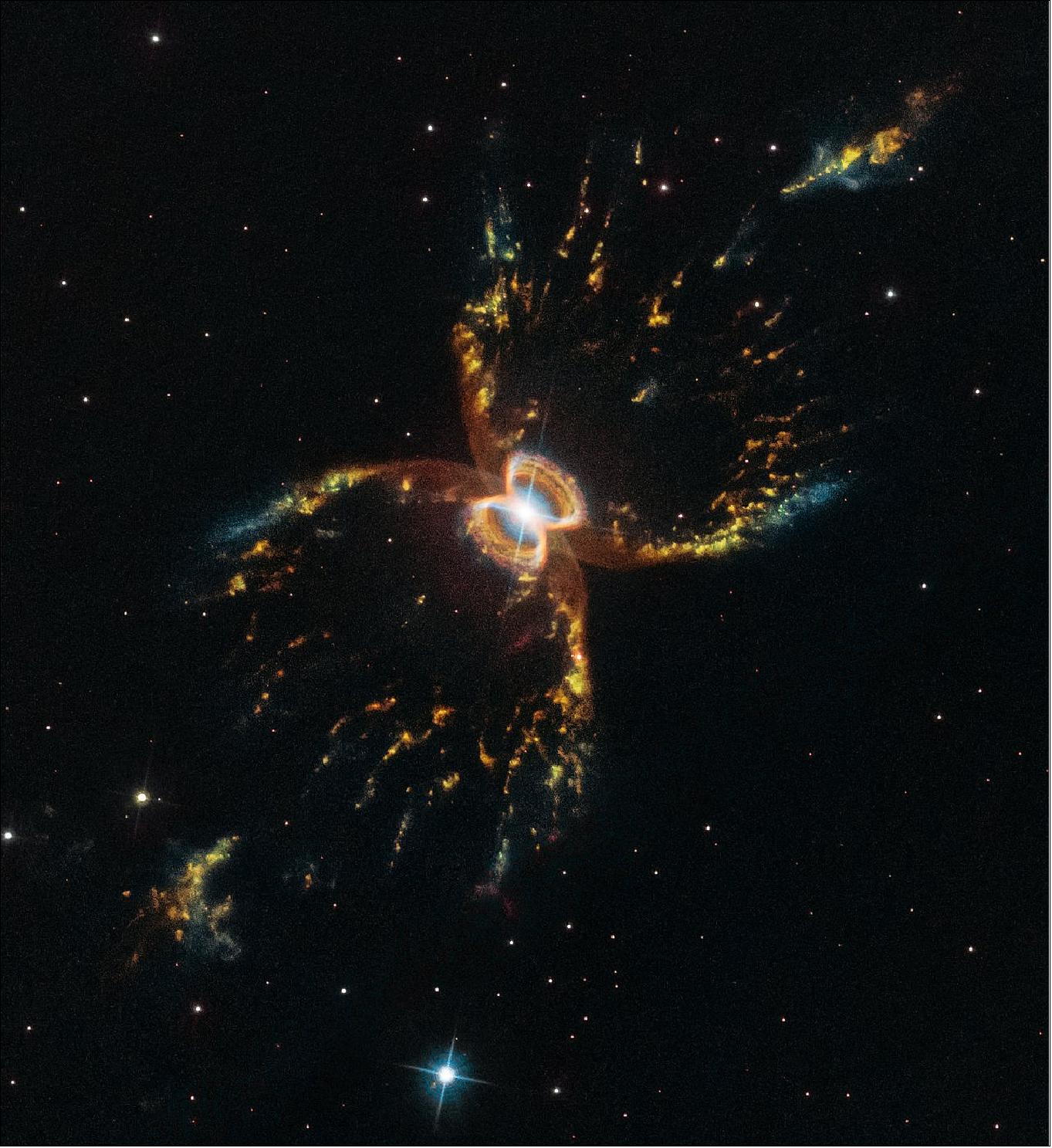
• 15 April 2019: A stellar Easter egg. The Egg Nebula is a preplanetary nebula, created by a dying star in the process of becoming a planetary nebula. Planetary nebulas have nothing to do with planets – the name arose when 18th century astronomers spotted them in their telescopes and thought they looked like planets. Instead, they are the remnants of material expelled by Sun-like stars in the later stages of their lives. 69)
- The preplanetary nebula phase is extremely short-lived in astronomical terms – only a few thousand years. This makes them rare objects and, combined with the fact that they are quite faint, rather difficult to spot. The Egg Nebula, located around 3000 light years from us, was the first of its kind to be discovered in the 1970s.
- During the preplanetary nebula phase, the central star periodically sheds its outer layers, which are then illuminated by the dying star at the center. Eventually the star stops shedding material and the core remnant heats up, exciting the expelled gas so that it glows brightly and becomes a planetary nebula.
- The dark band, sweeping beams, and crisscrossing arcs in this image can reveal a lot about the complex environment of a dying star. The central band is a cocoon of dust hiding the star from view.
- Beams of light emanate from the obscured star, and it is thought that they are due to starlight escaping from the ring-shaped holes in the dusty cocoon that surrounds the star. The holes are possibly carved by a high-speed stream of matter, although the cause of these jets are unknown. The spoke-like features are shadows cast by blobs of material within the region of the holes in the cocoon.
- Numerous bright arcs intersect the beams: these are shells of matter ejected by the star. The arcs are like tree rings, and can tell us something about the object's age as they reveal that the rate of mass ejection has varied between 100 and 500 years throughout its 10,000 year history. The gas is expanding at a rate of 20 km/s and matter has been detected out to a radius of 0.6 light years, providing an estimate of the amount of matter in the nebula.
- This image was previously published on NASA's and ESA's Hubble websites.
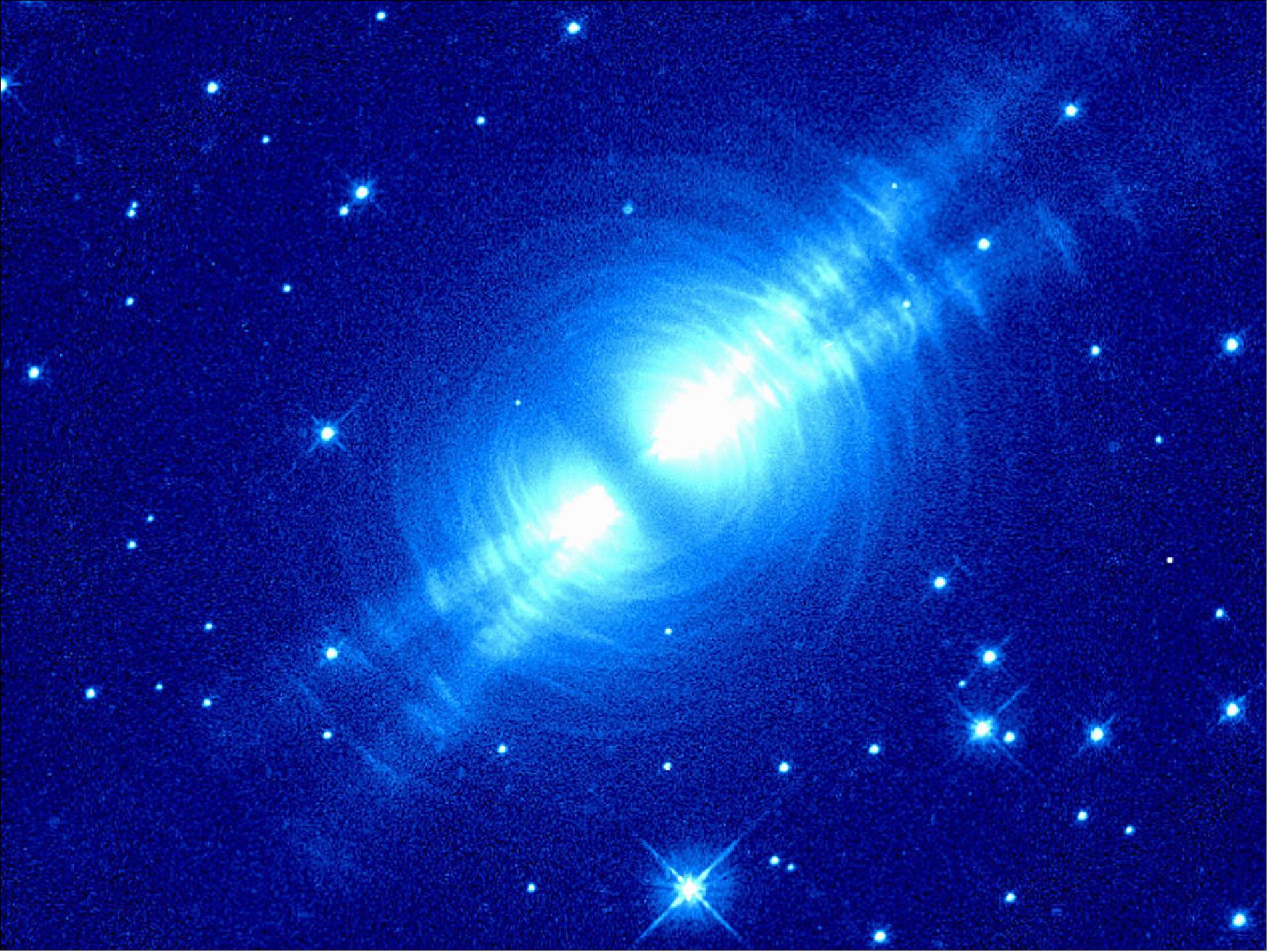
• 05 April 2019: Star clusters are commonly featured in cosmic photoshoots, and are also well-loved by the keen eye of the NASA/ESA Hubble Space Telescope. These large gatherings of celestial gems are striking sights — and Messier 2 is certainly no exception. 70)
- Messier 2 is located in the constellation of Aquarius (the Water Bearer), about 55,000 light-years away. It is a globular cluster, a spherical group of stars all tightly bound together by gravity. With a diameter of roughly 175 light-years, a population of 150,000 stars, and an age of 13 billion years, Messier 2 is one of the largest clusters of its kind and one of the oldest associated with the Milky Way.
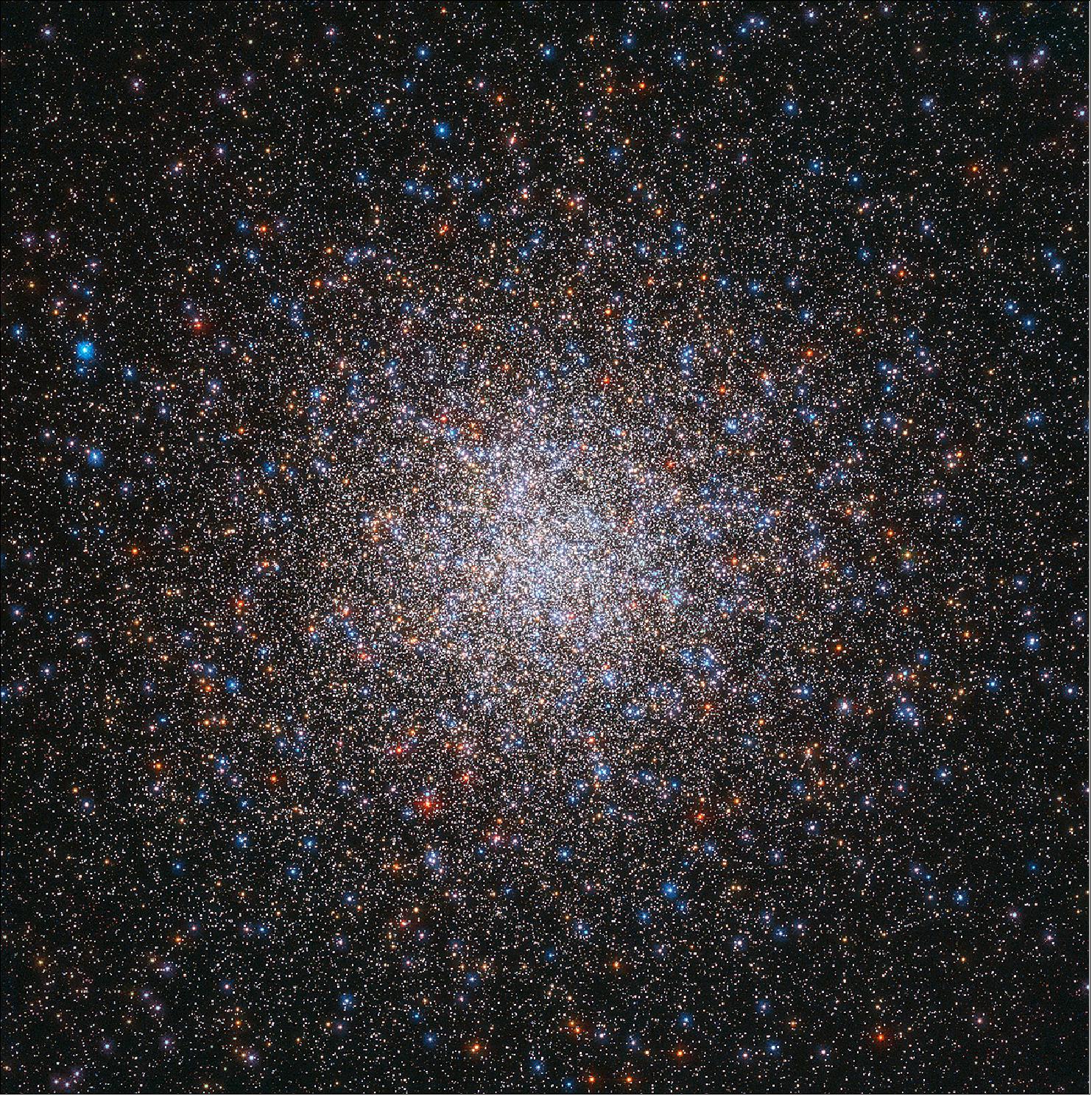
• 04 April 2019: NASA has selected 24 new fellows for its prestigious NASA Hubble Fellowship Program (NHFP). The program enables outstanding postdoctoral scientists to pursue independent research across NASA astrophysics, using theory, observation, experimentation or instrument development. Each fellowship provides the awardee up to three years of support. 71)
- The NHFP preserves the legacy of NASA's previous postdoctoral fellowship programs — the Hubble, Einstein and Sagan fellowships. Once selected, fellows are named to one of three sub-categories corresponding to three broad scientific questions NASA has sought to answer about the universe:
a) How does the universe work? – Einstein Fellows
b) How did we get here? – Hubble Fellows
c) Are we alone? – Sagan Fellows
- The NHFP is one of the highlights of NASA's pursuit of excellence in space science.
- “I am excited that this outstanding group of young scientists have accepted NASA Hubble Fellowships,” said Paul Hertz, Astrophysics Division director at NASA Headquarters in Washington. “I am confident that the research they do will address the most compelling questions in astrophysics and have an impact on our field far beyond the three-year duration of their fellowships.”
- The newly selected NHFP Fellows will begin their programs in the fall of 2019 at a host university or research center of their choosing in the United States. Table 2 provides the names of the 2019 awardees, their host institutions, and their proposed research topics.
- An important part of the NHFP are the symposia, which allow fellows the opportunity to present results of their research, and to meet each other and the scientific and administrative staff who manage the program.
- The Space Telescope Science Institute in Baltimore, Maryland, administers the NHFP on behalf of NASA, in collaboration with the Chandra X-ray Center at the Smithsonian Astrophysical Observatory in Cambridge, Massachusetts, and the NASA Exoplanet Science Institute at Caltech/IPAC in Pasadena, California.
How does the universe work? – Einstein Fellows:
- Dillon Brout, University of Pennsylvania, Improving Cosmological Constraints with the Dark Energy Supernova Program and a Decade of Type Ia Supernovae
- Andrew Chael, Princeton Center for Theoretical Science, Simulating and Imaging Flaring Black Holes on Horizon Scales
- Jose Maria Ezquiaga, University of Chicago, Precision Cosmology with Present and Next Generation Gravitational Wave Detectors
- Ting Li, Carnegie Observatories, Constraining Dark Matter with Stellar Streams and Dwarf Galaxies
- Renee Ludlam, California Institute of Technology, A New Light on Neutron Stars
- Yao-Yuan Mao, Rutgers University, The Galaxy-Halo Connection: Probing the Dark Universe with Galaxies
- Shuo Zhang, Boston University, Supermassive Black Holes and Exotic Physics in the Galactic Nuclei of Local Galaxies
How did we get here? – Hubble Fellows:
- Emma Beasor, National Optical Astronomy Observatory, The Evolution of Massive Stars to Supernovae
- John Chisholm, University of California, Santa Cruz, What Reionized the Universe?
- Eric Coughlin, Princeton University, The Appearance of Disappearing Stars: Mass Ejection, Fallback Accretion, and Jets from Weak and Failed Supernovae
- Anna-Christina Eilers, Massachusetts Institute of Technology, The Formation and Growth of Supermassive Black Holes at Early Cosmic Epochs
- Hui Li, Massachusetts Institute of Technology, Bridging the Gap Between Galaxy and Star Formation with Star Clusters
- Anna Faye McLeod, University of California, Berkeley, Stellar Feedback in the Era of Integral Field Spectroscopy
- Georgia Virginia Panopoulou, California Institute of Technology, A Unique Approach to the Determination of the Galactic Magnetic Field Using Starlight and Synchrotron Polarization Observations
- Vadim Semenov, Harvard University, Modeling the Turbulent Evolution of Galaxies over Cosmic Time
- Justin Spilker, University of Texas, Austin, Taking a Census of Galactic Winds with JWST, ALMA, and SOFIA
- Feige Wang, University of Arizona, Probing Cosmic Reionization and the Growth of the Earliest Super-Massive Black Holes
- Coral Wheeler, Carnegie Observatories, Ultra-High Resolution Simulations of the Milky Way and its Satellites.
Are we alone? – Sagan Fellows:
- Jaehan Bae, Carnegie Department of Terrestrial Magnetism, Constraining Initial Phases of Planet Formation
- Jennifer Bergner, University of Chicago, Connecting Interstellar and Planetary Chemistry
- Sebastiaan Haffert, University of Arizona, Seeing the Formation of Planets with High-Contrast Spectroscopy at MagAO-X
- Joshua Krissansen-Totton, University of California, Santa Cruz, Inverse Modeling of the Atmospheric Evolution of Lifeless Worlds to Understand Exoplanet Biosignatures
- Antonija Oklopcic, Harvard University, Spectral Signatures of Atmospheric Escape in Exoplanets
- Christopher Theissen, University of California, San Diego, Planetary Collisions around Low-Mass Stars: Constraining the Timescale for Collisions and Testing the Origin of the Kepler Dichotomy
• 02 April 2019: NASA’s Space Telescope Science Institute (STScI) recently awarded SwRI (Southwest Research Institute) the largest Hubble Space Telescope (HST) solar system program ever, with 206 of Hubble’s orbits around the Earth allocated to the project. The SSOLS (Solar System Origins Legacy Survey) will focus on Kuiper Belt objects (KBOs), particularly binary populations. 72)
- “The Kuiper Belt is a unique remnant of the solar system’s primordial planetesimal disk,” said Dr. Alex Parker, the SwRI planetary scientist leading the survey. “This cold, calm region has preserved an extraordinarily large population of binary objects, particularly those where the two objects have similar mass.”
- Hubble orbits at an altitude of about 350 miles (564 km), circling the Earth every 97 minutes. Most HST time is dedicated to studying interstellar space phenomena. The Kuiper Belt is a distant reservoir of ancient material that lies at the edge of our solar system, beyond all the terrestrial and giant planets. At the present time, the properties of the Kuiper Belt’s unique population of binary systems can only be accurately measured with Hubble. SwRI leads this large HST project focused on characterizing the binary and color properties of over 200 unique KBOs. Team members are spread across the USA, Canada and Northern Ireland.
- “These binary systems are powerful tracers of the processes that built the planets,” Parker said. “We will use Hubble to test the theory that many planetesimals formed as binary systems from the get-go, and that today’s Kuiper Belt binaries did not come from mergers of initially solitary objects. Binary objects orbit around each other as they collectively circle the Sun. Recent models of small body formation suggest that binaries are leftovers of the very earliest times of our solar system, when pairs of bodies could form directly from collapsing swarms of small-scale “pebbles.”
- Competing theories of planetesimal formation predict different size and color distributions for binary and solitary KBOs. If objects first formed through an accretion process and were merged into binaries later, scientists expect the objects in binary systems to have dissimilar colors and to have a different size distribution than solitary objects. However, if planetesimals formed through a rapid collapse process that produced some solitary objects and some binary systems from the start, scientists would expect objects in binary systems to have a similar surface color and a size distribution similar to that of solitary objects.
- The SSOLS program builds upon the legacy of the OSSOS (Outer Solar System Origins Survey) and the CFEPS (Canada-France Ecliptic Plane Survey), the two largest well-characterized Kuiper Belt surveys ever conducted. By drawing targets from these well-characterized surveys, SSOLS will provide a coherent framework to test leading theories of planetesimal formation and the origin and evolution of the outer solar system’s architecture.
- The SSOLS team will be posting updates, images, and results on its website, https://www.ssols.space/
- SSOLS is a Cycle 26 HST treasury program administered by STScI, which is operated by the AURA (Association of Universities for Research in Astronomy) and based in Baltimore, Maryland. STScI is charged with helping humanity explore the universe with advanced space telescopes and ever-growing data archives.
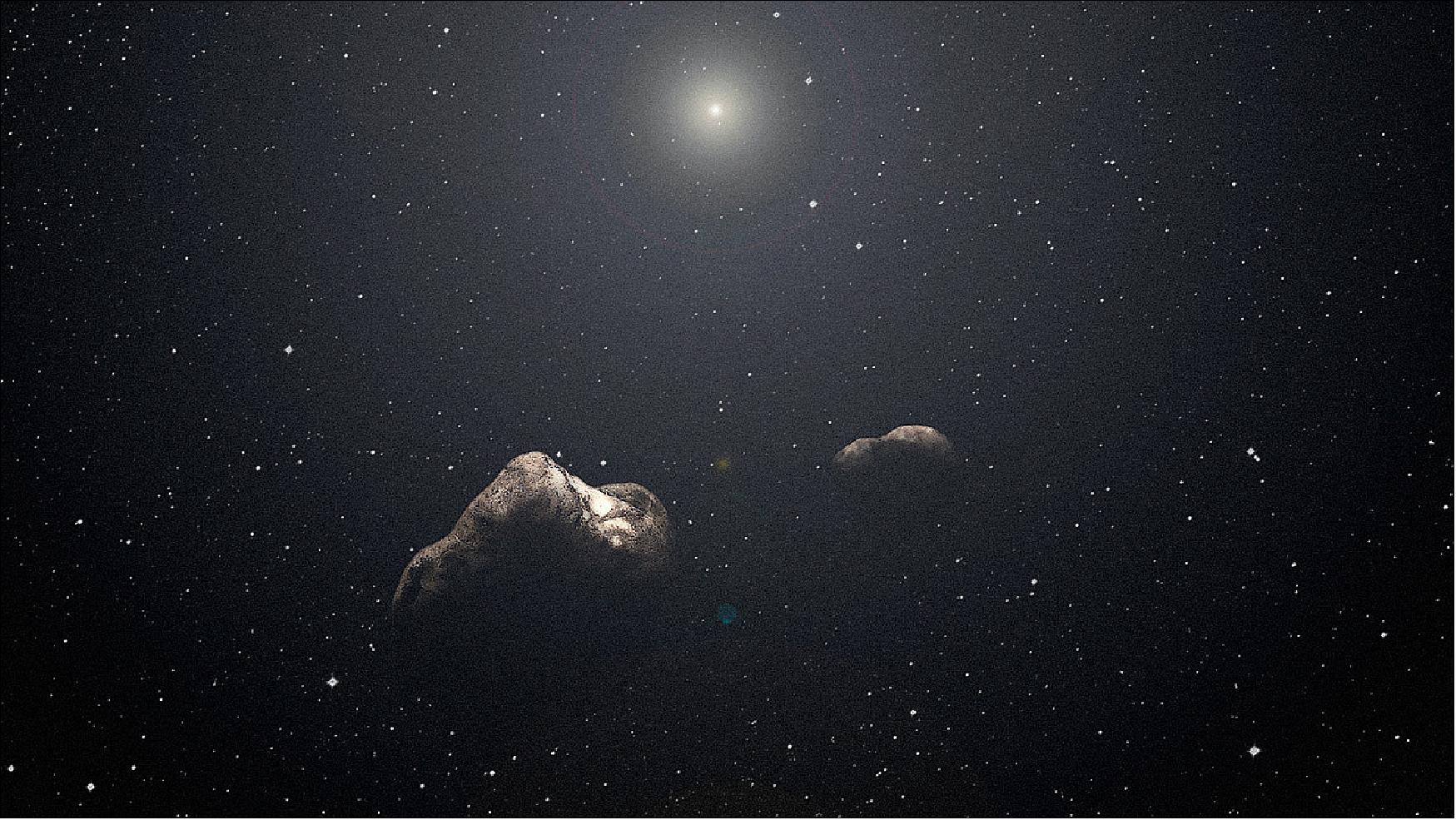
• 29 March 2019: This star-studded image shows us a portion of Messier 11, an open star cluster in the southern constellation of Scutum (The Shield). Messier 11 is also known as the Wild Duck Cluster, as its brightest stars form a “V” shape that somewhat resembles a flock of ducks in flight. 73)
- Messier 11 is one of the richest and most compact open clusters currently known. By investigating the brightest, hottest main sequence stars in the cluster astronomers estimate that it formed roughly 220 million years ago. Open clusters tend to contain fewer and younger stars than their more compact globular cousins, and Messier 11 is no exception: at its center lie many blue stars, the hottest and youngest of the cluster’s few thousand stellar residents.
- The lifespans of open clusters are also relatively short compared to those of globular ones; stars in open clusters are spread further apart and are thus not as strongly bound to each other by gravity, causing them to be more easily and quickly drawn away by stronger gravitational forces. As a result Messier 11 is likely to disperse in a few million years as its members are ejected one by one, pulled away by other celestial objects in the vicinity.
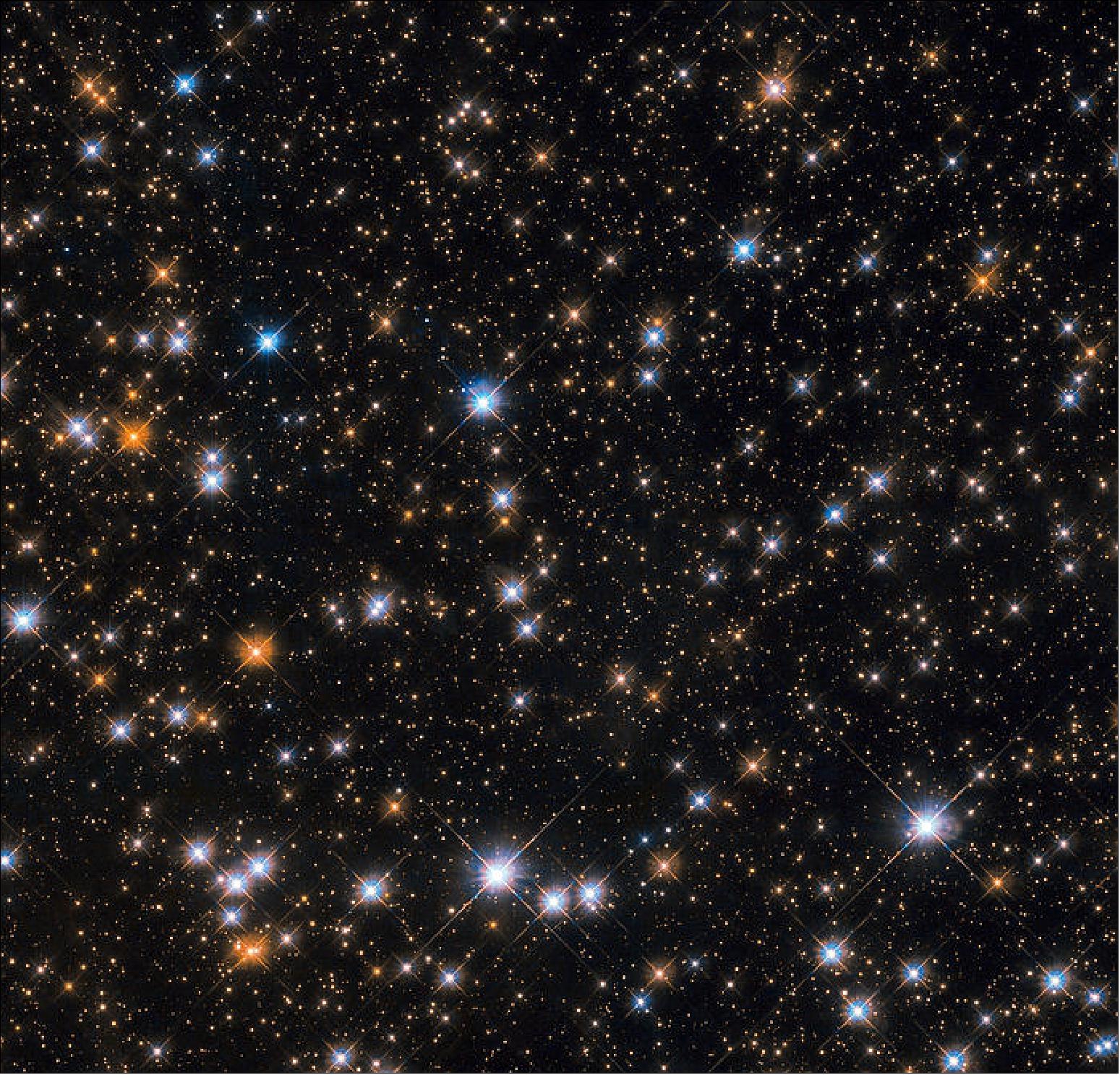
• 28 March 2019: A small asteroid has been caught in the process of spinning so fast it’s throwing off material, according to new data from NASA’s Hubble Space Telescope and other observatories. 74)
- Images from Hubble show two narrow, comet-like tails of dusty debris streaming from the asteroid (6478) Gault. Each tail represents an episode in which the asteroid gently shed its material — key evidence that Gault is beginning to come apart.
- Discovered in 1988, the 2.5-mile-wide (4-kilometer-wide) asteroid has been observed repeatedly, but the debris tails are the first evidence of disintegration. Gault is located 214 million miles (344 million kilometers) from the Sun. Of the roughly 800,000 known asteroids between Mars and Jupiter, astronomers estimate that this type of event in the asteroid belt is rare, occurring roughly once a year.
- Watching an asteroid become unglued gives astronomers the opportunity to study the makeup of these space rocks without sending a spacecraft to sample them.
- “We didn’t have to go to Gault,” explained Olivier Hainaut of ESO (European Southern Observatory) in Garching, Germany, a member of the Gault observing team. “We just had to look at the image of the streamers, and we can see all of the dust grains well-sorted by size. All the large grains (about the size of sand particles) are close to the object and the smallest grains (about the size of flour grains) are the farthest away because they are being pushed fastest by pressure from sunlight.”
- Gault is only the second asteroid whose disintegration has been strongly linked to a process known as a YORP effect. (YORP stands for “Yarkovsky–O'Keefe–Radzievskii–Paddack,” the names of four scientists who contributed to the concept.) When sunlight heats an asteroid, infrared radiation escaping from its warmed surface carries off angular momentum as well as heat. This process creates a tiny torque that can cause the asteroid to continually spin faster. When the resulting centrifugal force starts to overcome gravity, the asteroid’s surface becomes unstable, and landslides may send dust and rubble drifting into space at a couple miles per hour, or the speed of a strolling human. The researchers estimate that Gault could have been slowly spinning up for more than 100 million years.
![Figure 64: This Hubble Space Telescope image reveals the gradual self-destruction of an asteroid, whose ejected dusty material has formed two long, thin, comet-like tails. The longer tail stretches more than 500,000 miles (800,000 km) and is roughly 3,000 miles (4,800 km) wide. The shorter tail is about a quarter as long. The streamers will eventually disperse into space [image credit: NASA, ESA, K. Meech and J. Kleyna (University of Hawaii), and O. Hainaut (European Southern Observatory)]](/api/cms/documents/163813/5502378/Hubble2019_Auto11.jpeg)
- Piecing together Gault’s recent activity is an astronomical forensics investigation involving telescopes and astronomers around the world. All-sky surveys, ground-based telescopes, and space-based facilities like the Hubble Space Telescope pooled their efforts to make this discovery possible.
- The initial clue was the fortuitous detection of the first debris tail, observed on Jan. 5, 2019, by the NASA-funded ATLAS (Asteroid Terrestrial-Impact Last Alert System) telescope in Hawaii. The tail also turned up in archival data from December 2018 from ATLAS and the Panoramic Survey Telescope and Rapid Response System (Pan-STARRS) telescopes in Hawaii. In mid-January, a second shorter tail was spied by the Canada–France–Hawaii Telescope in Hawaii and the Isaac Newton Telescope in Spain, as well as by other observers. An analysis of both tails suggests the two dust events occurred around Oct. 28 and Dec. 30, 2018.
- Follow-up observations with the William Herschel Telescope and ESA’s (European Space Agency) Optical Ground Station in La Palma and Tenerife, Spain, and the Himalayan Chandra Telescope in India measured a two-hour rotation period for the object, close to the critical speed at which a loose “rubble-pile” asteroid begins to break up.
- “Gault is the best ‘smoking gun’ example of a fast rotator right at the two-hour limit,” said team member Jan Kleyna of the University of Hawaii in Honolulu.
- An analysis of the asteroid’s surrounding environment by Hubble revealed no signs of more widely distributed debris, which rules out the possibility of a collision with another asteroid causing the outbursts.
- The asteroid’s narrow streamers suggest that the dust was released in short bursts, lasting anywhere from a few hours to a few days. These sudden events puffed away enough debris to make a “dirt ball” approximately 150 m across if compacted together. The tails will begin fading away in a few months as the dust disperses into interplanetary space.
- Based on observations by the Canada–France–Hawaii Telescope, the astronomers estimate that the longer tail stretches over half a million miles (800,000 km) and is roughly 3,000 miles (4,800 km) wide. The shorter tail is about a quarter as long.
- Only a couple of dozen active asteroids have been found so far. Astronomers may now have the capability to detect many more of them because of the enhanced survey capabilities of observatories such as Pan-STARRS and ATLAS, which scan the entire sky. “Asteroids such as Gault cannot escape detection anymore,” Hainaut said. “That means that all these asteroids that start misbehaving get caught.”
- The researchers hope to monitor Gault for more dust events. The team’s results have been accepted for publication by The Astrophysical Journal Letters.
• 18 March 2019: This fuzzy orb of light is a giant elliptical galaxy filled with an incredible 200 billion stars. Unlike spiral galaxies, which have a well-defined structure and boast picturesque spiral arms, elliptical galaxies appear fairly smooth and featureless. This is likely why this galaxy, named Messier 49, was discovered by French astronomer Charles Messier in 1771. At a distance of 56 million light-years, and measuring 157,000 light-years across, M49 was the first member of the Virgo Cluster of galaxies to be discovered, and it is more luminous than any other galaxy at its distance or nearer. 75)
- Elliptical galaxies tend to contain a larger portion of older stars than spiral galaxies and also lack young blue stars. Messier 49 itself is very yellow, which indicates that the stars within it are mostly older and redder than the Sun. In fact, the last major episode of star formation was about six billion years ago — before the Sun was even born!
- Messier 49 is also rich in globular clusters; it hosts about 6000, a number that dwarfs the 150 found in and around the Milky Way. On average, these clusters are 10 billion years old. Messier 49 is also known to host a supermassive black hole at its centre with the mass of more than 500 million Suns, identifiable by the X-rays pouring out from the heart of the galaxy (as this Hubble image comprises infrared observations, these X-rays are not visible here).
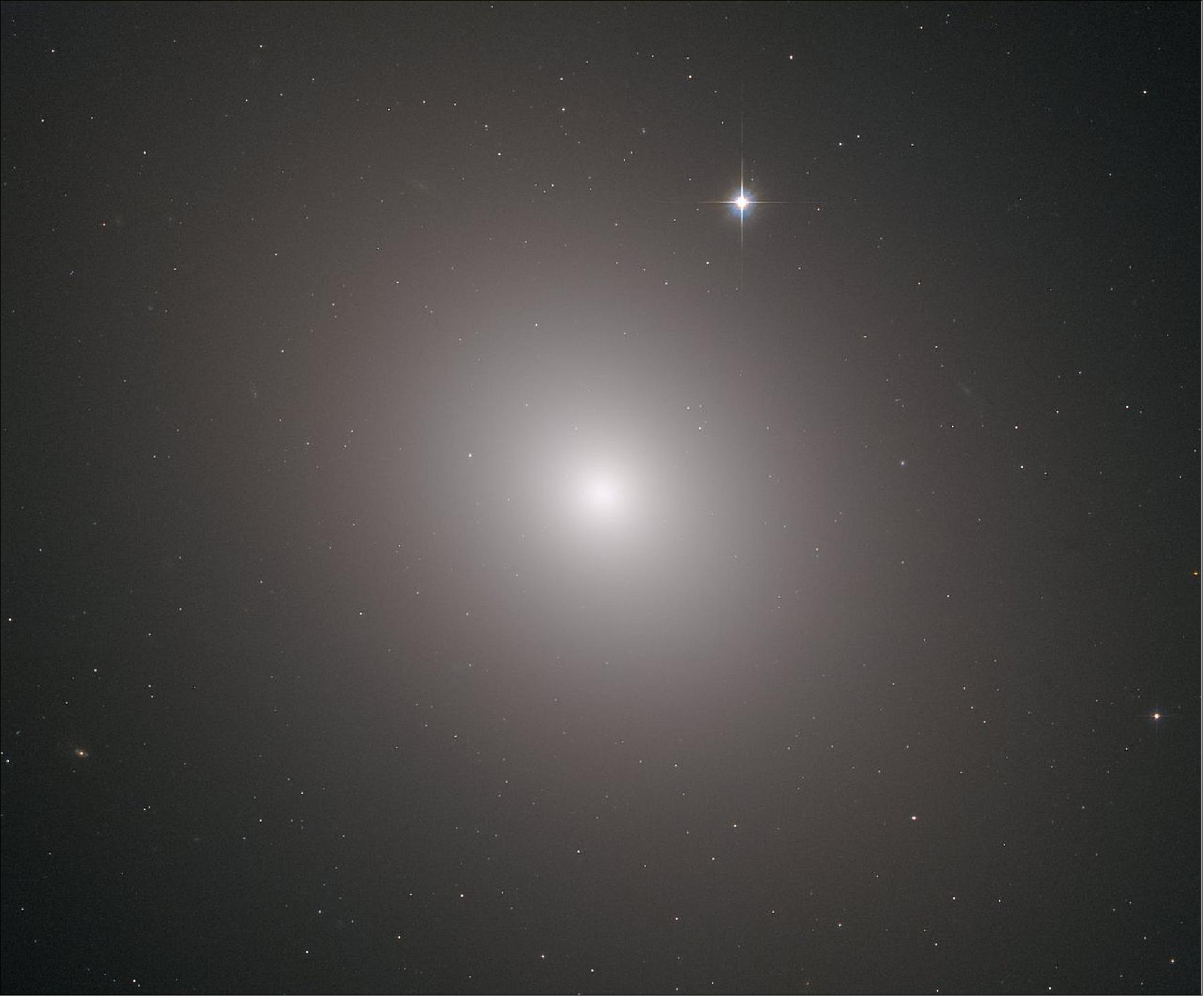
• 07 March 2019: In a striking example of multi-mission astronomy, measurements from the NASA/ESA Hubble Space Telescope and the ESA Gaia mission have been combined to improve the estimate of the mass of our home galaxy the Milky Way: 1.5 trillion (1.5 x 1012) solar masses. 76) 77)
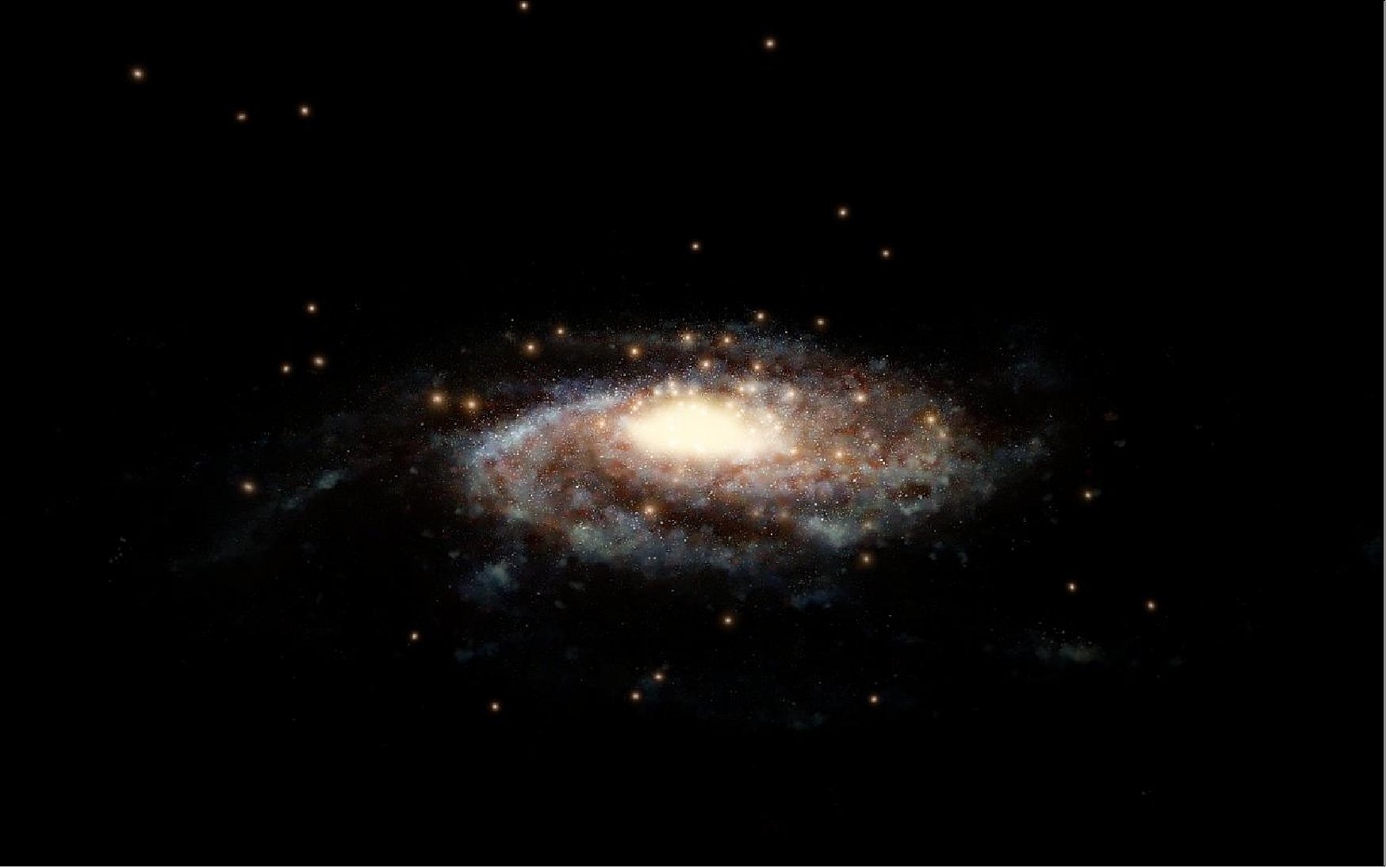
- The mass of the Milky Way is one of the most fundamental measurements astronomers can make about our galactic home. However, despite decades of intense effort, even the best available estimates of the Milky Way's mass disagree wildly. Now, by combining new data from the European Space Agency (ESA) Gaia mission with observations made with the NASA/ESA Hubble Space Telescope, astronomers have found that the Milky Way weighs in at about 1.5 trillion solar masses within a radius of 129,000 light-years from the galactic center.
- Previous estimates of the mass of the Milky way ranged from 500 billion (500 x 109) to 3 trillion (3 x 1012) times the mass of the Sun. This huge uncertainty arose primarily from the different methods used for measuring the distribution of dark matter – which makes up about 90% of the mass of the galaxy.
- "We just can't detect dark matter directly," explains Laura Watkins (European Southern Observatory, Germany), who led the team performing the analysis. "That's what leads to the present uncertainty in the Milky Way's mass – you can't measure accurately what you can't see!"
- Given the elusive nature of the dark matter, the team had to use a clever method to weigh the Milky Way, which relied on measuring the velocities of globular clusters – dense star clusters that orbit the spiral disc of the galaxy at great distances.
Note: Globular clusters formed prior to the construction of the Milky Way's spiral disk, where our Sun and the Solar System later formed. Because of their great distances, globular star clusters allow astronomers to trace the mass of the vast envelope of dark matter surrounding our galaxy far beyond the spiral disk.
- "The more massive a galaxy, the faster its clusters move under the pull of its gravity" explains N. Wyn Evans (University of Cambridge, UK). "Most previous measurements have found the speed at which a cluster is approaching or receding from Earth, that is the velocity along our line of sight. However, we were able to also measure the sideways motion of the clusters, from which the total velocity, and consequently the galactic mass, can be calculated."
Note: The total velocity of an object is made up of three motions – a radial motion plus two defining the sideway motions. However, in astronomy most often only line-of-sight velocities are available. With only one component of the velocity available, the estimated masses depend very strongly on the assumptions for the sideway motions. Therefore measuring the sideway motions directly significantly reduces the size of the error bars for the mass.
- The group used Gaia's second data release as a basis for their study. Gaia was designed to create a precise three-dimensional map of astronomical objects throughout the Milky Way and to track their motions. Its second data release includes measurements of globular clusters as far as 65,000 light-years from Earth.
- "Global clusters extend out to a great distance, so they are considered the best tracers astronomers use to measure the mass of our galaxy" said Tony Sohn of STScI (Space Telescope Science Institute), Baltimore, MD, USA, who led the Hubble measurements.
- The team combined these data with Hubble's unparalleled sensitivity and observational legacy. Observations from Hubble allowed faint and distant globular clusters, as far as 130,000 light-years from Earth, to be added to the study. As Hubble has been observing some of these objects for a decade, it was possible to accurately track the velocities of these clusters as well.
- "We were lucky to have such a great combination of data," explained Roeland P. van der Marel of STScI. "By combining Gaia's measurements of 34 globular clusters with measurements of 12 more distant clusters from Hubble, we could pin down the Milky Way's mass in a way that would be impossible without these two space telescopes."
- Until now, not knowing the precise mass of the Milky Way has presented a problem for attempts to answer a lot of cosmological questions. The dark matter content of a galaxy and its distribution are intrinsically linked to the formation and growth of structures in the Universe. Accurately determining the mass for the Milky Way gives us a clearer understanding of where our galaxy sits in a cosmological context. 78)
• 06 March 2019: NASA has recovered the Hubble Space Telescope's ACS (Advanced Camera for Surveys) instrument, which suspended operations on Thursday, Feb. 28, 2019. The final tests were conducted and the instrument was brought back to its operational mode on March 6. 79)
- At 8:31 p.m. EST on 28 February, the ACS aboard NASA's Hubble Space Telescope suspended operations after an error was detected as the instrument was performing a routine boot procedure. The error indicated that software inside the camera had not loaded correctly in a small section of computer memory. The Hubble operations team ran repeated tests to reload the memory and check the entire process. No errors have been detected since the initial incident, and it appears that all circuits, computer memory and processors that are part of that boot process are now operating normally. The instrument has now been brought back to its standard operating mode for normal operations.
- The ACS was installed in 2002 and repaired during the last servicing mission to Hubble back in 2009 after a power supply failure. More than 5,500 peer-reviewed scientific papers have been published from its data, and it is credited with some of Hubble's most iconic images, including the Hubble Ultra Deep Field, the furthest look into the universe at that time.
- Hubble itself is in its 29th year of operations, well surpassing its original 15-year lifetime. With its primary and backup systems, it is expected that Hubble will operate simultaneously with the upcoming JWST (James Webb Space Telescope) to obtain multiwavelength observations of astronomical objects. Scheduled to launch in 2021, the JWST is designed to see near- and mid-infrared light while Hubble is optimized for ultraviolet and visible light.
• 01 March 2019: At 8:31 p.m. EST on 28 February 2019, the Advanced Camera for Surveys (ACS) aboard NASA's Hubble Space Telescope suspended operations after an error was detected as the instrument was performing a routine boot procedure. The error indicated that software inside the camera had not loaded correctly. A team of instrument system engineers, flight software experts, and flight operations personnel quickly organized to download and analyze instrument diagnostic information. This team is currently working to identify the root cause and then to construct a recovery plan. 80)
- The telescope continues to operate normally, executing observations with the other three science instruments — the Wide Field Camera 3 (WFC3), the Cosmic Origins Spectrograph (COS), and the Space Telescope Imaging Spectrograph (STIS) — that are all performing nominally. There are no critical observations using the ACS scheduled for the remainder of this week or next week, and the observations that were planned over the next two weeks can be easily rescheduled.
- Originally required to last 15 years, Hubble has now been operating for more than 28 years. The final servicing mission in 2009, expected to extend Hubble's lifetime an additional five years, has now produced more than nine years of science observations. During that servicing mission, astronauts repaired the ACS, installed in 2002, after its power supply failed in 2007.
• 01 March 2019: Globular clusters like NGC 2419, visible in this image taken with the NASA/ESA Hubble Space Telescope, are not only beautiful, but also fascinating. They are spherical groups of stars which orbit the center of a galaxy; in the case of NGC 2419, that galaxy is the Milky Way. NGC 2419 can be found around 300,000 light-years from the Solar System, in the constellation Lynx (the Lynx). 81)
- The stars populating globular clusters are very similar to one another, with similar properties such as metallicity. The similarity of these stellar doppelgängers is due to their formation early in the history of the galaxy. As the stars in a globular cluster all formed at around the same time, they tend to display reasonably homogeneous properties. It was believed that this similarity also extended to the stellar helium content; that is, it was thought that all stars in a globular cluster would contain comparable amounts of helium.
- However, Hubble’s observations of NGC 2419 have shown that this is not always the case. This surprising globular cluster turns out to be made up of two separate populations of red giant stars, one of which is unusually helium-rich. Other elements within the different stars in NGC 2419 vary too — nitrogen in particular. On top of this, these helium-rich stars were found to be predominantly in the center of the globular cluster, and to be rotating. These observations have raised questions about the formation of globular clusters; did these two drastically different groups of stars form together? Or did this globular cluster come into being by a different route entirely?
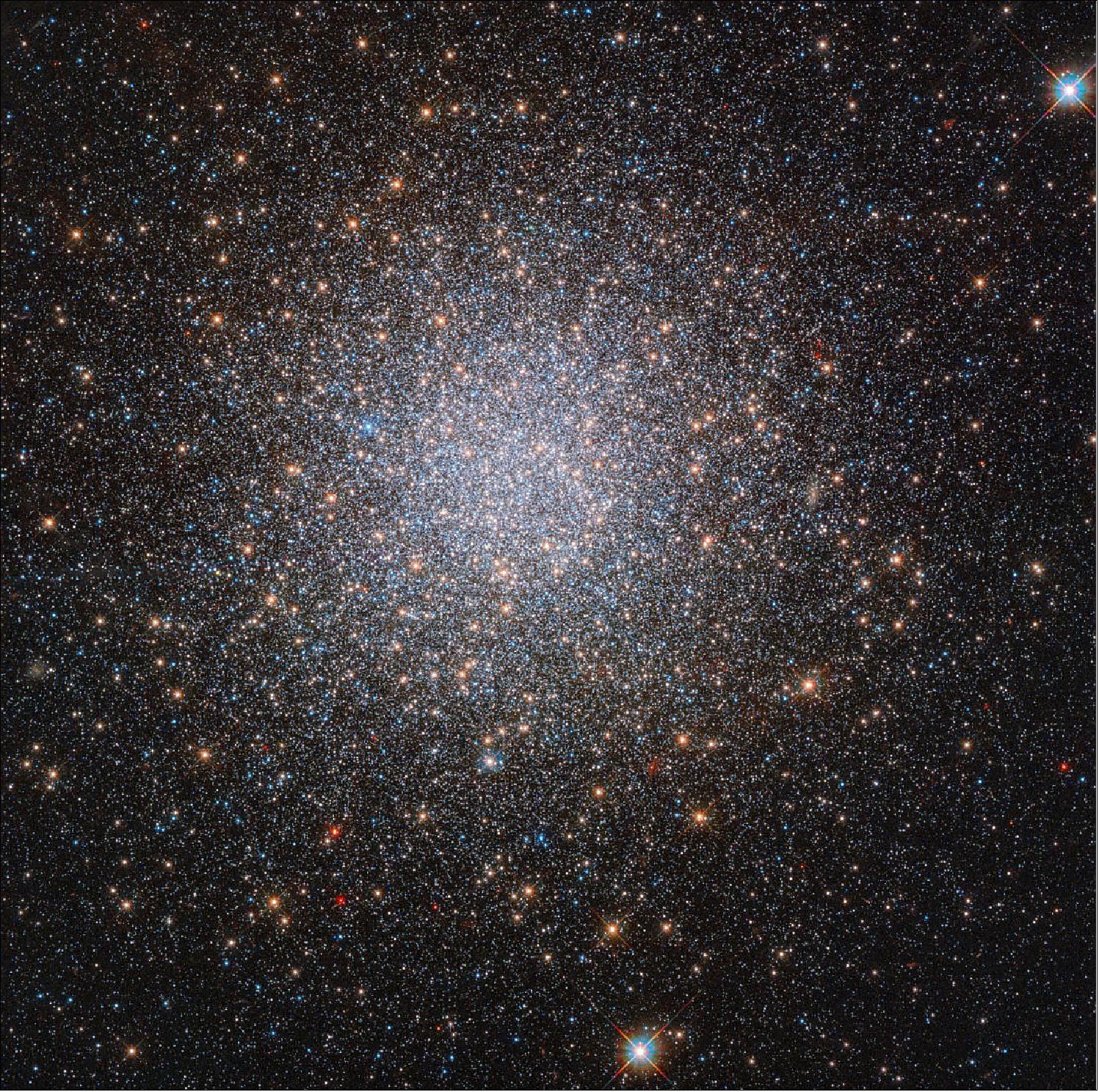
• 20 February 2019: Astronomers call it "the moon that shouldn't be there." — After several years of analysis, a team of planetary scientists using NASA's Hubble Space Telescope has at last come up with an explanation for a mysterious moon around Neptune that they discovered with Hubble in 2013. 82) 83)
- The tiny moon, named Hippocamp, is unusually close to a much larger Neptunian moon called Proteus. Normally, a moon like Proteus should have gravitationally swept aside or swallowed the smaller moon while clearing out its orbital path.
- So why does the tiny moon exist? Hippocamp is likely a chipped-off piece of the larger moon that resulted from a collision with a comet billions of years ago. The diminutive moon, only 20 miles (about 34 km) across, is 1/1000th the mass of Proteus (which is 260 miles, ~418 km across).
- "The first thing we realized was that you wouldn't expect to find such a tiny moon right next to Neptune's biggest inner moon," said Mark Showalter of the SETI Institute in Mountain View, California. "In the distant past, given the slow migration outward of the larger moon, Proteus was once where Hippocamp is now."
- This scenario is supported by Voyager 2 images from 1989 that show a large impact crater on Proteus, almost large enough to have shattered the moon. "In 1989, we thought the crater was the end of the story," said Showalter. "With Hubble, now we know that a little piece of Proteus got left behind and we see it today as Hippocamp." The orbits of the two moons are now 7,500 miles (about 12,070 km) apart.
- Neptune's satellite system has a violent and tortured history. Many billions of years ago, Neptune captured the large moon Triton from the Kuiper Belt, a large region of icy and rocky objects beyond the orbit of Neptune. Triton's gravity would have torn up Neptune's original satellite system. Triton settled into a circular orbit and the debris from shattered Neptunian moons re-coalesced into a second generation of natural satellites. However, comet bombardment continued to tear things up, leading to the birth of Hippocamp, which might be considered a third-generation satellite.
- "Based on estimates of comet populations, we know that other moons in the outer solar system have been hit by comets, smashed apart, and re-accreted multiple times," noted Jack Lissauer of NASA's Ames Research Center in California's Silicon Valley, a coauthor on the new research. "This pair of satellites provides a dramatic illustration that moons are sometimes broken apart by comets."
![Figure 69: Artist's concept of Neptune's Moon Hippocamp [image credit: NASA, ESA, and J. Olmsted (STScI)]](/api/cms/documents/163813/5502378/Hubble2019_AutoD.jpeg)
- Hippocamp is a half-horse half-fish from Greek mythology. The scientific name for the seahorse is Hippocampus, also the name of an important part of the human brain. The rules of the International Astronomical Union require that the moons of Neptune are named after Greek and Roman mythology of the undersea world.
- The team of astronomers in this study consists of M. Showalter (SETI Institute, Mountain View, California), I. de Pater (University of California, Berkeley, California), J. Lissauer (NASA Ames Research Center, Silicon Valley, California), and R. French (SETI Institute, Mountain View, California).
- The paper will appear in the February 21 issue of the science journal Nature. 84)
- The Hubble Space Telescope is a project of international cooperation between NASA and ESA (European Space Agency). NASA's Goddard Space Flight Center in Greenbelt, Maryland, manages the telescope. The Space Telescope Science Institute (STScI) in Baltimore, Maryland, conducts Hubble science operations. STScI is operated for NASA by the Association of Universities for Research in Astronomy in Washington, D.C.
![Figure 70: Neptune's inner Moons and their diameters. This diagram shows the orbital positions of Neptune's inner moons, which range in size from 20 to 260 miles across. The outer moon Triton was captured from the Kuiper belt many billions of years ago. This would have torn up Neptune's original satellite system. Triton settled into a circular orbit and the debris from shattered moons re-coalesced into a second generation of inner satellites seen today. However, comet bombardment continued to tear things up, leading to the birth of Hippocamp, which is a broken-off piece of Proteus. Therefore, it is a third-generation satellite. Not shown is Neptune's outermost known satellite, Nereid, which is in a highly eccentric orbit, and may be a survivor from the era of that Triton capture [image credit: NASA, ESA, and A. Feild (STScI)]](/api/cms/documents/163813/5502378/Hubble2019_AutoC.jpeg)
• 15 February 2019: Stars are born in dark clouds of gas and dust like this. But star formation is an energetic process, and newly-formed stars can send out a brilliant display of lights called Herbig-Haro objects. These objects form as jets of hot gas spewed by the newborn star collide with the surrounding matter at high speeds. 85)
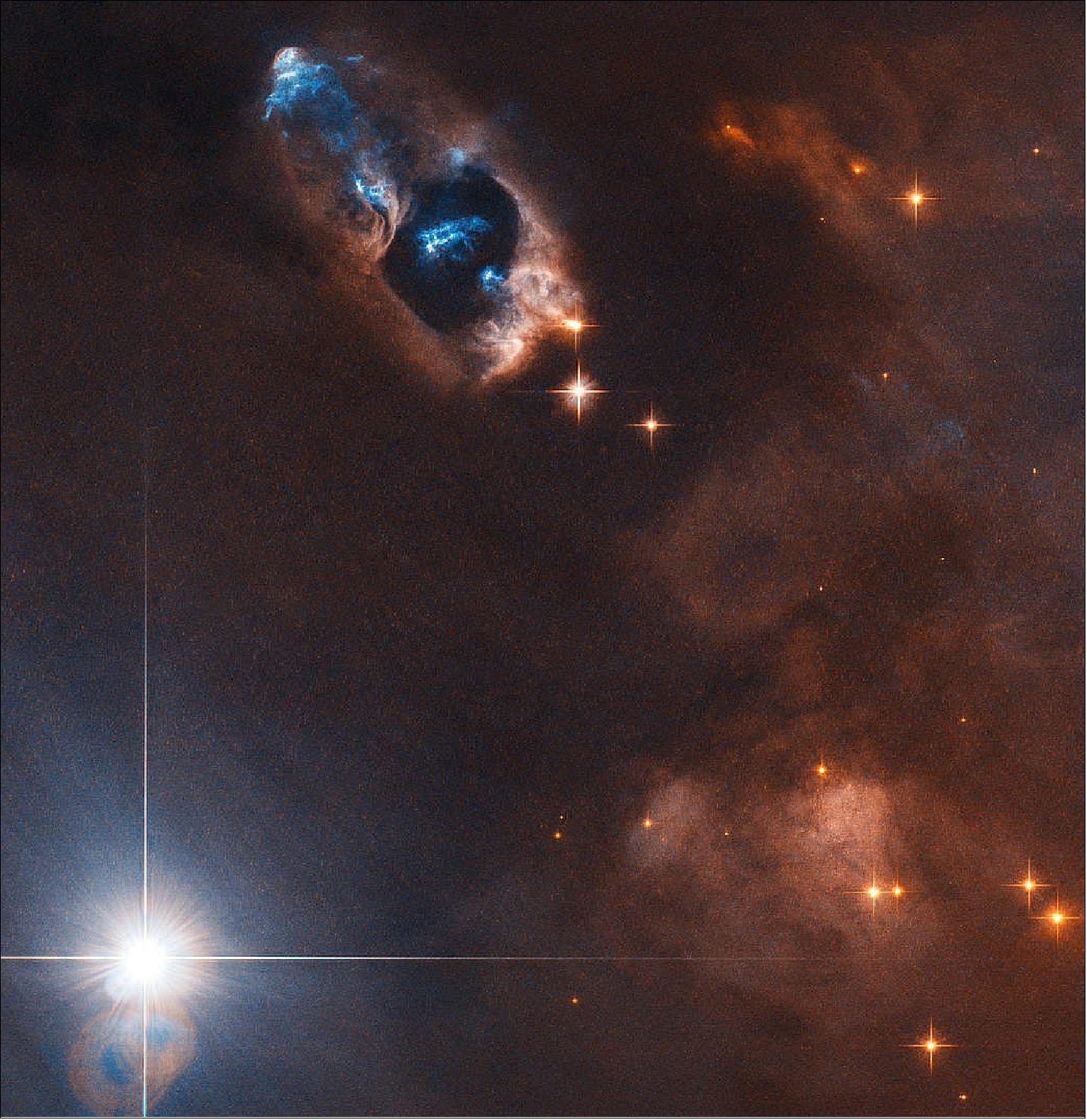
- Bright patches of nebulosity near newborn stars, Herbig-Haro objects like HH 7–11 are transient phenomena. Traveling away from the star that created them at a speed of up to about 150,000 miles per hour, they disappear into nothingness within a few tens of thousands of years. The young star that is the source of HH 7–11 is called SVS 13, and all five objects are moving away from SVS 13 toward the upper left. The current distance between HH 7 and SVS 13 is about 20,000 times the distance between Earth and the Sun.
- Herbig–Haro objects are formed when jets of ionized gas ejected by a young star collide with nearby clouds of gas and dust at high speeds. The Herbig-Haro objects visible in this image are no exception to this and were formed when the jets from the newborn star SVS 13 collided with the surrounding clouds. These collisions created the five brilliant clumps of light within the reflection nebula.
• 11 February 2019: Like Earth, Uranus and Neptune have seasons, which likely drive some of the features in their atmospheres. But their seasons are much longer than on Earth, spanning decades rather than months. 86) 87)
- The new Hubble view of Neptune shows the dark storm, seen at top center (Figure 72). Appearing during the planet's southern summer, the feature is the fourth and latest mysterious dark vortex captured by Hubble since 1993. Two other dark storms were discovered by the Voyager 2 spacecraft in 1989 as it flew by the remote planet. Since then, only Hubble has had the sensitivity in blue light to track these elusive features, which have appeared and faded quickly. A study led by University of California, Berkeley, undergraduate student Andrew Hsu estimated that the dark spots appear every four to six years at different latitudes and disappear after about two years.
- Hubble uncovered the latest storm in September 2018 in Neptune's northern hemisphere. The feature is roughly 6,800 miles across. To the right of the dark feature are bright white "companion clouds." Hubble has observed similar clouds accompanying previous vortices. The bright clouds form when the flow of ambient air is perturbed and diverted upward over the dark vortex, causing gases to freeze into methane ice crystals. These clouds are similar to clouds that appear as pancake-shaped features when air is pushed over mountains on Earth (though Neptune has no solid surface). The long, thin cloud to the left of the dark spot is a transient feature that is not part of the storm system.
- It's unclear how these storms form. But like Jupiter's Great Red Spot, the dark vortices swirl in an anti-cyclonic direction and seem to dredge up material from deeper levels in the ice giant's atmosphere.
- The Hubble observations show that as early as 2016, increased cloud activity in the region preceded the vortex's appearance. The images indicate that the vortices probably develop deeper in Neptune's atmosphere, becoming visible only when the top of the storm reaches higher altitudes.
- The snapshot of Uranus, like the image of Neptune, reveals a dominant feature: a vast bright stormy cloud cap across the north pole.
- Scientists believe this new feature is a result of Uranus' unique rotation. Unlike every other planet in the solar system, Uranus is tipped over almost onto its side. Because of this extreme tilt, during the planet's summer the Sun shines almost directly onto the north pole and never sets. Uranus is now approaching the middle of its summer season, and the polar-cap region is becoming more prominent. This polar hood may have formed by seasonal changes in atmospheric flow.
![Figure 72: During its routine yearly monitoring of the weather on our solar system's outer planets, NASA's Hubble Space Telescope has uncovered a new mysterious dark storm on Neptune (right, image taken with WFC3 in September and November 2018) and provided a fresh look at a long-lived storm circling around the north polar region on Uranus (left). The Uranus image was taken with the WFC3 of Hubble in November 2018. [image credit: NASA, ESA, A. Simon (NASA Goddard Space Flight Center), and M. H. Wong and A. Hsu (University of California, Berkeley)]](/api/cms/documents/163813/5502378/Hubble2019_AutoA.jpeg)
- Near the edge of the polar storm is a large, compact methane-ice cloud, which is sometimes bright enough to be photographed by amateur astronomers. A narrow cloud band encircles the planet north of the equator. It is a mystery how bands like these are confined to such narrow widths, because Uranus and Neptune have very broad westward-blowing wind jets.
- Both planets are classified as ice giant planets. They have no solid surface but rather mantles of hydrogen and helium surrounding a water-rich interior, itself perhaps wrapped around a rocky core. Atmospheric methane absorbs red light but allows blue-green light to be scattered back into space, giving each planet a cyan hue.
- The new Neptune and Uranus images are from the Outer Planet Atmospheres Legacy (OPAL) program, a long-term Hubble project, led by Amy Simon of NASA's Goddard Space Flight Center in Greenbelt, Maryland, that annually captures global maps of our solar system's outer planets when they are closest to Earth in their orbits. OPAL's key goals are to study long-term seasonal changes, as well as capture comparatively transitory events, such as the appearance of Neptune's dark spot. These dark storms may be so fleeting that in the past some of them may have appeared and faded during multi-year gaps in Hubble's observations of Neptune. The OPAL program ensures that astronomers won't miss another one.
- These images are part of a scrapbook of Hubble snapshots of Neptune and Uranus that track the weather patterns over time on these distant, cold planets. Just as meteorologists cannot predict the weather on Earth by studying a few snapshots, astronomers cannot track atmospheric trends on solar system planets without regularly repeated observations. Astronomers hope that Hubble's long-term monitoring of the outer planets will help them unravel the mysteries that still persist about these faraway worlds.
- Analyzing the weather on these worlds also will help scientists better understand the diversity and similarities of the atmospheres of solar-system planets, including Earth.
• 04 February 2019: This atmospheric image shows a galaxy named Messier 85, captured in all its delicate, hazy glory by the NASA/ESA Hubble Space Telescope. Messier 85 slants through the constellation of Coma Berenices (Berenice’s Hair), and lies around 50 million light-years from Earth. It was first discovered by Charles Messier’s colleague Pierre Méchain in 1781, and is included in the Messier catalogue of celestial objects. 88)
- Messier 85 is intriguing — its properties lie somewhere between those of a lenticular and an elliptical galaxy, and it appears to be interacting with two of its neighbors: the beautiful spiral NGC 4394, located out of frame to the upper left, and the small elliptical MCG 3-32-38, located out of frame to the center bottom.
- The galaxy contains some 400 billion stars, most of which are very old. However, the central region hosts a population of relatively young stars of just a few billion years in age; these stars are thought to have formed in a late burst of star formation, likely triggered as Messier 85 merged with another galaxy over four billion years ago. Messier 85 has a further potentially strange quality. Almost every galaxy is thought to have a supermassive black hole at its center, but from measurements of the velocities of stars in this galaxy, it is unclear whether Messier 85 contains such a black hole.

• 31 January 2019: An international team of astronomers recently used the NASA/ESA Hubble Space Telescope to study white dwarf stars within the globular cluster NGC 6752. The aim of their observations was to use these stars to measure the age of the globular cluster, but in the process they made an unexpected discovery. 89)
- In the outer fringes of the area observed with Hubble's Advanced Camera for Surveys a compact collection of stars was visible. After a careful analysis of their brightnesses and temperatures, the astronomers concluded that these stars did not belong to the cluster – which is part of the Milky Way – but rather they are millions of light-years more distant.
- Our newly discovered cosmic neighbor, nicknamed Bedin I by the astronomers, is a modestly sized, elongated galaxy. It measures only around 3000 light-years at its greatest extent – a fraction of the size of the Milky Way. Not only is it tiny, but it is also incredibly faint. These properties led astronomers to classify it as a dwarf spheroidal galaxy.
- Dwarf spheroidal galaxies are defined by their small size, low-luminosity, lack of dust and old stellar populations [1]. 36 galaxies of this type are already known to exist in the Local Group of Galaxies, 22 of which are satellite galaxies of the Milky Way.
[1] While similar to dwarf elliptical galaxies in appearance and properties, dwarf spheroidal galaxies are in general approximately spherical in shape and have a lower luminosity.
- While dwarf spheroidal galaxies are not uncommon, Bedin I has some notable features. Not only is it one of just a few dwarf spheroidals that have a well established distance but it is also extremely isolated. It lies about 30 million light-years from the Milky Way and 2 million light-years from the nearest plausible large galaxy host, NGC 6744. This makes it possibly the most isolated small dwarf galaxy discovered to date.
- From the properties of its stars, astronomers were able to infer that the galaxy is around 13 billion years old – nearly as old as the Universe itself. Because of its isolation – which resulted in hardly any interaction with other galaxies – and its age, Bedin I is the astronomical equivalent of a living fossil from the early Universe.
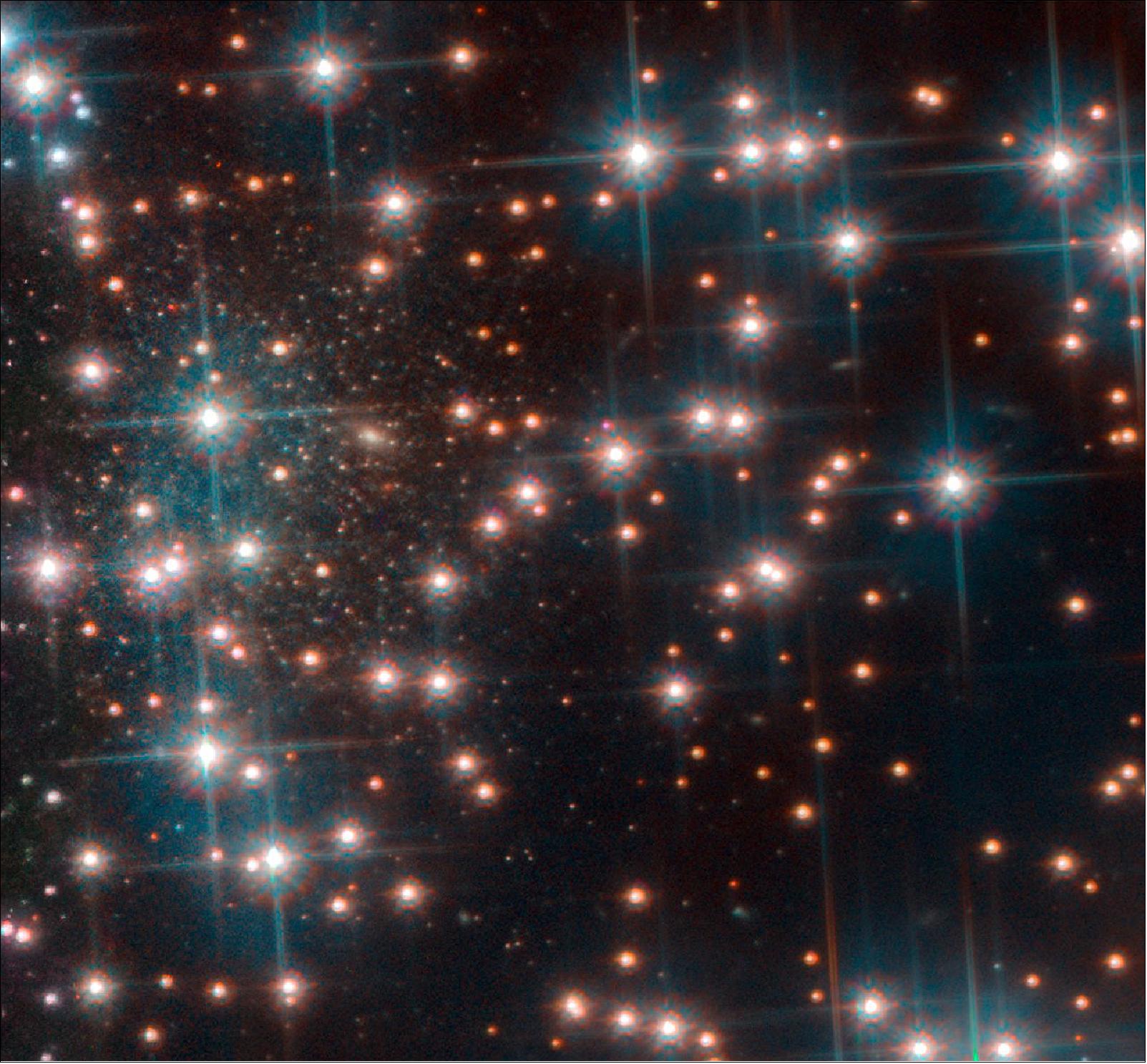
- The discovery of Bedin I was a truly serendipitous find. Very few Hubble images allow such faint objects to be seen, and they cover only a small area of the sky. Future telescopes with a large field of view, such as the WFIRST telescope, will have cameras covering a much larger area of the sky and may find many more of these galactic neighbors. 90)
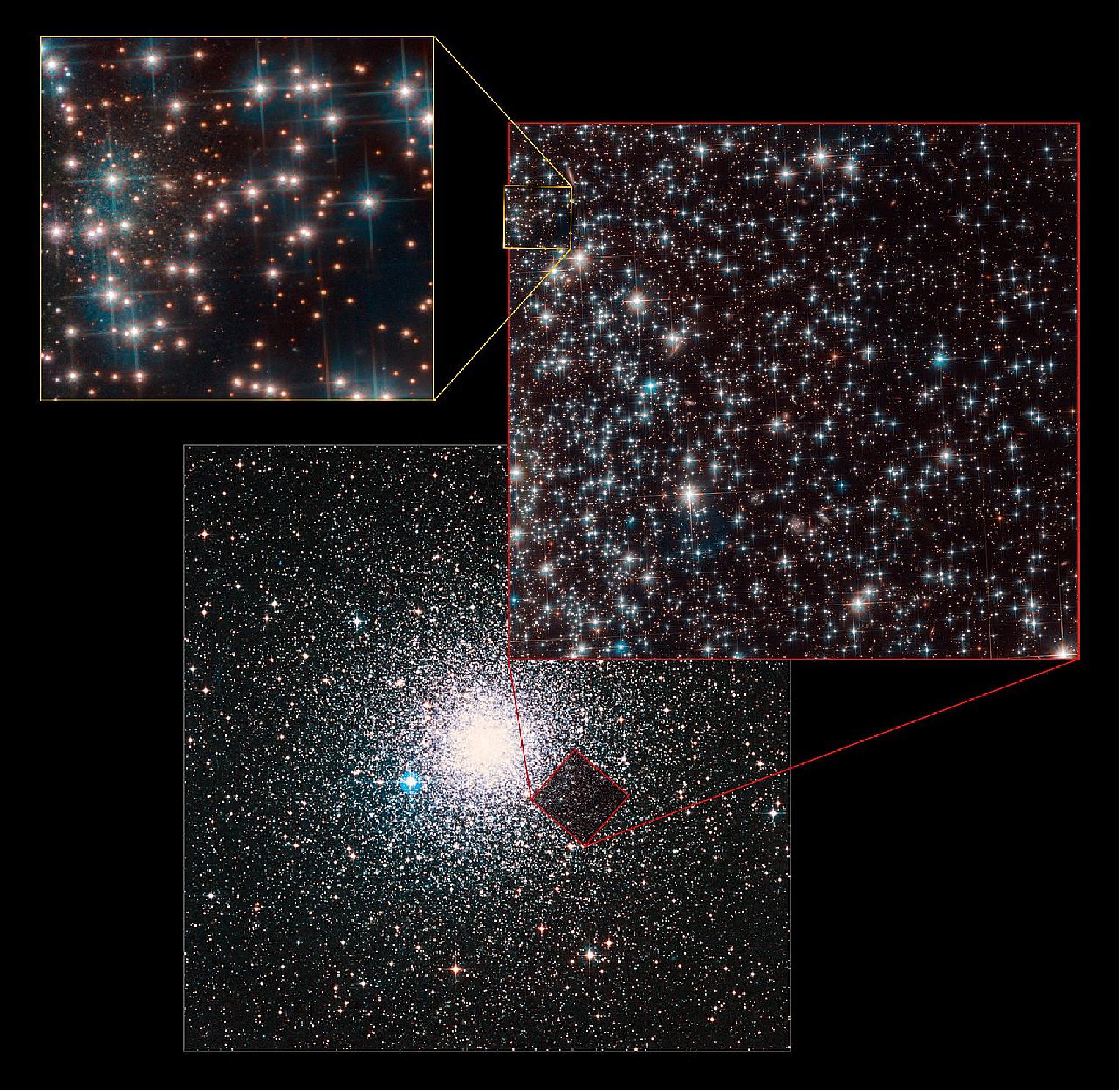
• 24 January 2019: The rough-and-tumble environment near the center of the massive Coma galaxy cluster is no match for a wayward spiral galaxy. New images from NASA's Hubble Space Telescope show a spiral galaxy being stripped of its gas as it plunges toward the cluster’s center. A long, thin streamer of gas and dust stretches like taffy from the galaxy's core and on into space. Eventually, the galaxy, named D100, will lose all of its gas and become a dead relic, deprived of the material to create new stars and shining only by the feeble glow of old, red stars. 91) 92)
- "This galaxy stands out as a particularly extreme example of processes common in massive clusters, where a galaxy goes from being a healthy spiral full of star formation to a 'red and dead galaxy,'" said William Cramer of Yale University in New Haven, Connecticut, leader of the team using the Hubble observations. "The spiral arms disappear, and the galaxy is left with no gas and only old stars. This phenomenon has been known about for several decades, but Hubble provides the best imagery of galaxies undergoing this process."
- Called "ram pressure stripping," the process occurs when a galaxy, due to the pull of gravity, falls toward the dense center of a massive cluster of thousands of galaxies, which swarm around like a hive of bees. During its plunge, the galaxy plows through intergalactic material, like a boat moving through water. The material pushes gas and dust from the galaxy. Once the galaxy loses all of its hydrogen gas — fuel for starbirth — it meets an untimely death because it can no longer create new stars. The gas-stripping process in D100 began roughly 300 million years ago.
- In the massive Coma cluster this violent gas-loss process occurs in many galaxies. But D100 is unique in several ways. Its long, thin tail is its most unusual feature. The tail, a mixture of dust and hydrogen gas, extends nearly 200,000 light-years, about the width of two Milky Way galaxies. But the pencil-like structure is comparatively narrow, only 7,000 light-years wide.
- "The tail is remarkably well-defined, straight and smooth, and has clear edges," explained team member Jeffrey Kenney, also of Yale University. "This is a surprise because a tail like this is not seen in most computer simulations. Most galaxies undergoing this process are more of a mess. The clean edges and filamentary structures of the tail suggest that magnetic fields play a prominent role in shaping it. Computer simulations show that magnetic fields form filaments in the tail's gas. With no magnetic fields, the tail is more clumpy than filamentary."
![Figure 76: The spiral galaxy D100, on the far right of this Hubble Space Telescope image, is being stripped of its gas as it plunges toward the center of the giant Coma galaxy cluster. The dark brown streaks near D100's central region are silhouettes of dust escaping from the galaxy. The dust is part of a long, thin tail, also composed of hydrogen gas, that stretches like taffy from the galaxy's core. Hubble, however, sees only the dust. The telescope's sharp vision also uncovered the blue glow of clumps of young stars in the tail. The brightest clump in the middle of the tail (the blue feature) contains at least 200,000 stars, fueled by the ongoing loss of hydrogen gas from D100 [image credit: NASA, ESA, M. Sun (University of Alabama), and W. Cramer and J. Kenney (Yale University)]](/api/cms/documents/163813/5502378/Hubble2019_Auto6.jpeg)
Legend to Figure 76: The gas-loss process occurs when D100, due to the pull of gravity, begins falling toward the dense center of the massive Coma cluster, consisting of thousands of galaxies. During its plunge, D100 plows through intergalactic material like a boat plowing through water. This material pushes gas and dust out of the galaxy. Once D100 loses all of its hydrogen gas, its star-making fuel, it can no longer create new stars. The gas-stripping process in the beleaguered galaxy began roughly 300 million years ago.
The reddish galaxies in the image contain older stars between the ages of 500 million to 13 billion years old. One of those galaxies is D99, just below and to the left of D100. It was stripped of its gas by the same process as the one that is siphoning gas from D100. The blue galaxies contain a mixture of young and old stars. Some of the stars are less than 500 million years old. The Coma cluster is located 330 million light-years from Earth. — The Hubble image is a blend of several exposures taken in visible light between May 10 and July 10, 2016, and November 2017 to January 2018, by the Advanced Camera for Surveys.
- The researchers' main goal was to study star formation along the tail. Hubble's sharp vision uncovered the blue glow of clumps of young stars. The brightest clump in the middle of the tail contains at least 200,000 stars, triggered by the ongoing gas loss from the galaxy. However, based on the amount of glowing hydrogen gas contained in the tail, the team had expected Hubble to uncover three times more stars than it detected.
- The Subaru Telescope in Hawaii observed the glowing tail in 2007 during a survey of the Coma cluster's galaxies. But the astronomers needed Hubble observations to confirm that the hot hydrogen gas contained in the tail was a signature of star formation.
- "Without the depth and resolution of Hubble, it's hard to say if the glowing hydrogen-gas emission is coming from stars in the tail or if it's just from the gas being heated," Cramer said. "These Hubble visible-light observations are the first and best follow-up of the Subaru survey."
- The Hubble data show that the gas-stripping process began on the outskirts of the galaxy and is moving in towards the center, which is typical in this type of mass loss. Based on the Hubble images, the gas has been cleared out all the way down to the central 6,400 light-years.
- Within that central region, there is still a lot of gas, as seen in a burst of star formation. "This region is the only place in the galaxy where gas exists and star formation is taking place," Cramer said. "But now that gas is being stripped out of the center, forming the long tail."
- Adding to this compelling narrative is another galaxy in the image that foreshadows D100's fate. The object, named D99, began as a spiral galaxy similar in mass to D100. It underwent the same violent gas-loss process as D100 is now undergoing, and is now a dead relic. All of the gas was siphoned from D99 between 500 million and 1 billion years ago. Its spiral structure has mostly faded away, and its stellar inhabitants consist of old, red stars. "D100 will look like D99 in a few hundred million years," Kenney said. — The Coma cluster is located 330 million light-years from Earth.
• 24 January, 2019: The Whirlpool Galaxy is a magnificent spiral galaxy that has been studied across the spectrum by NASA's Great Observatories. This remarkable video uses two dimensional images and three dimensional visualizations to contrast and compare the different views of infrared (Spitzer Space Telescope), visible (Hubble Space Telescope), and X-ray (Chandra X-ray Observatory) observations. Within these spectral bands, each wavelength region illustrates a different component of the stars, gas, and dust that comprise the galaxy. By both separating and combining seven multiwavelength views, astronomers gain a broader and richer look into the detailed structure of a spiral galaxy. 93)
• 21 January 2019: Gravitational lensing can help astronomers study objects that would otherwise be too faint or appear too small for us to view. When a massive object — such as a massive cluster of galaxies, as seen here — distorts space with its immense gravitational field, it causes light from more distant galaxies to travel along altered and warped paths. It also amplifies the light, making it possible for us to observe and study its source. 94)
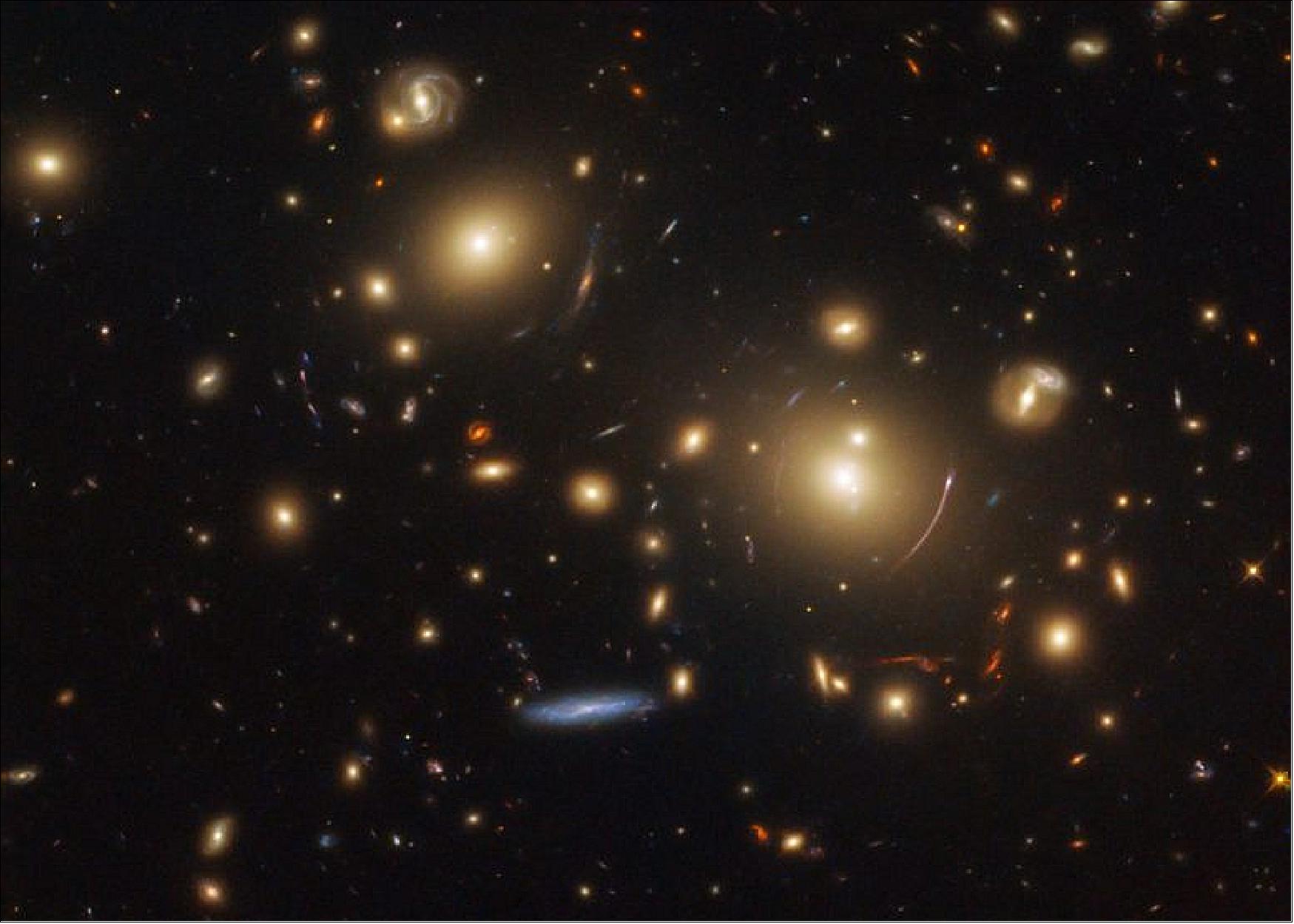
- In this image, we see two dominant elliptical galaxies near the center of the image. The gravity from the galaxy cluster that is the home of these galaxies is acting as the aforementioned gravitational lens, allowing us to view the more distant galaxies sitting behind them. We see the effects of this lensing as narrow, curved streaks of light surrounding both of the large galaxies.
- This image was observed by Hubble as part of the Sloan Giant Arcs Survey program.
• 17 January 2019: The Hubble Space Telescope’s Wide Field Camera 3 was brought back to full operational status and completed its first science observations just after noon EST today, 17 January. The instrument autonomously shut down on 8 January after internal data erroneously indicated invalid voltage levels. 95)
• 15 January 2019: NASA has moved closer to conducting science operations again with the Hubble Space Telescope's WFC3 (Wide Field Camera 3) instrument, which suspended operations on 8 January 2019. As of 15 January, the instrument was brought back to its operations mode. 96) 97)
- Shortly after noon EST (Eastern Standard Time) on 8 January, software installed on the Wide Field Camera 3 detected that some voltage levels within the instrument were out of the predefined range. The instrument autonomously suspended its operations as a safety precaution. Upon further investigation, the voltage levels appeared to be within normal range, yet the engineering data within the telemetry circuits for those voltage levels were not accurate. In addition, all other telemetry within those circuits also contained erroneous values indicating that this was a telemetry issue and not a power supply issue.
- After resetting the telemetry circuits and associated boards, additional engineering data were collected and the instrument was brought back to operations. All values were normal. Additional calibration and tests will be run over the next 48 to 72 hours to ensure that the instrument is operating properly. Further investigation using both the new and the previously collected engineering data will be conducted to determine why those data values were originally incorrect.
- Assuming that all tests work as planned, it is expected that the Wide Field Camera 3 will start to collect science images again by the end of the week.
- The Wide Field Camera 3 was installed during the last servicing mission to Hubble back in 2009. Over 2,000 peer-reviewed published papers have been produced from its data. Hubble itself is in its 29th year of operations, well surpassing its original 15-year lifetime.
- Hubble operations, like other satellite operations, are excepted activities as defined in the NASA furlough/shutdown plan. The current partial government shutdown does not affect its flight operations.
• 14 January 2019: Messier 89 is slightly smaller than the Milky Way, but has a few interesting features that stretch far out into the surrounding space. One structure of gas and dust extends up to 150 000 light-years out from the galaxy’s center, which is known to house a supermassive black hole. Jets of heated particles reach out to 100 000 light-years from the galaxy, suggesting that Messier 89 may have once been far more active — perhaps an active quasar or radio galaxy — than it is now. It is also surrounded by an extensive system of shells and plumes, which may have been caused by past mergers with smaller galaxies — and implies that Messier 89 as we know it may have formed in the relatively recent past. 98)
- Messier 89 was discovered by astronomer Charles Messier in 1781, when Messier had been cataloguing astronomical objects for 23 years — ever since he mistook a faint object in the sky for Halley’s Comet. Upon closer inspection, he realized the object was actually the Crab Nebula. To prevent other astronomers from making the same error, he decided to catalogue all the bright, deep-sky objects that could potentially be mistaken for comets. His methodical observations of the night sky led to the first comprehensive catalogue of astronomical objects: the Messier catalogue! Messier 89 holds the record for being the last ever giant elliptical to be found by Messier, and the most perfectly spherical galaxy in the entire catalogue of 110 objects.
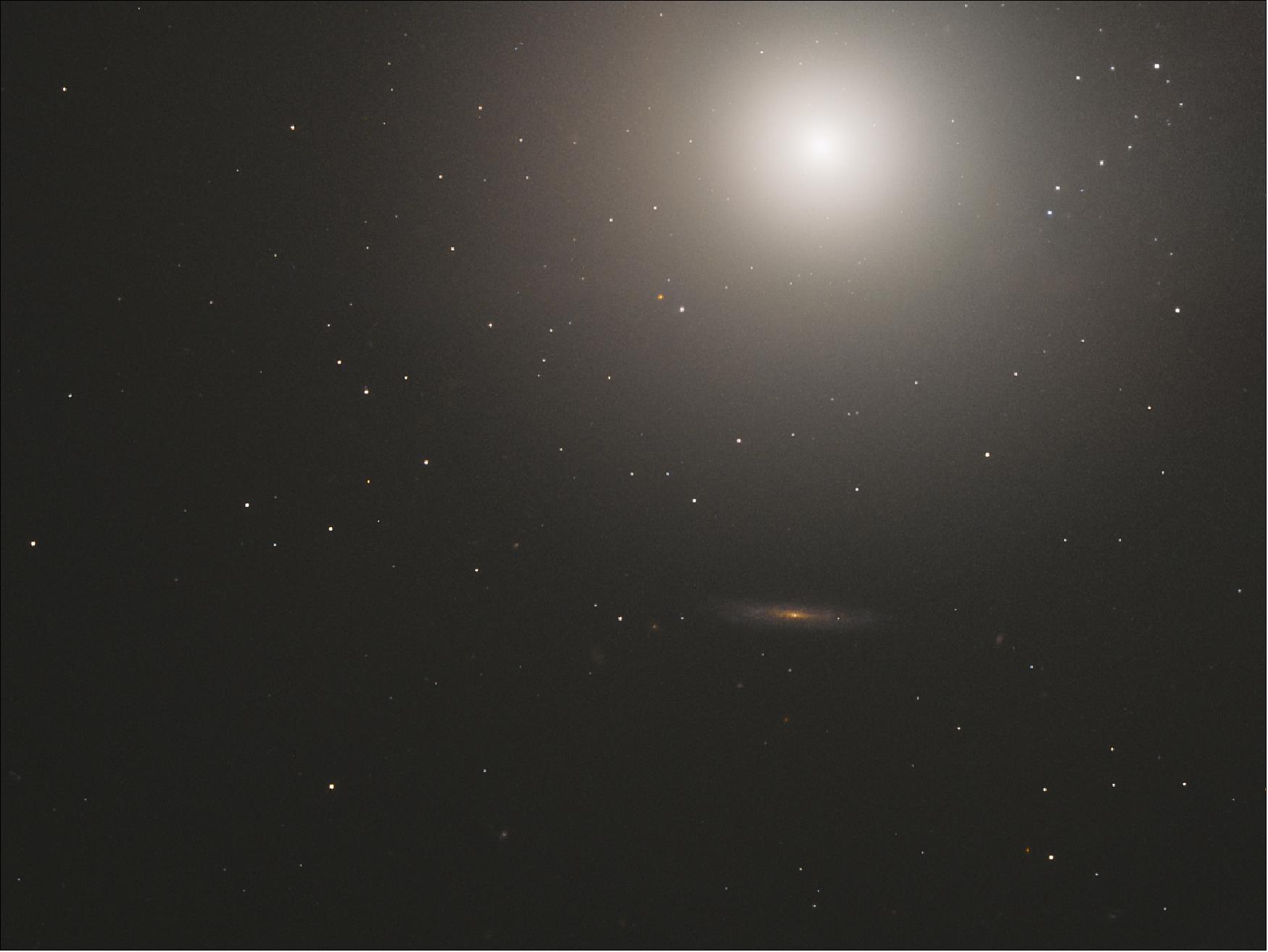
• 9 January 2019: At 17:23 UTC on 8 January, the WFC3 (Wide Field Camera 3) on the Hubble Space Telescope suspended operations due to a hardware problem. Hubble will continue to perform science observations with its other three active instruments, while the Wide Field Camera 3 anomaly is investigated. WFC3, installed during Servicing Mission 4 in 2009, is equipped with redundant electronics should they be needed to recover the instrument. 99)
- There are concerns, however, that "engineers are unlikely to be able to fix the aging telescope until the ongoing U.S. government shutdown ends — whenever that might be," according to the science journal Nature. Engineers are unlikely to be able to fix the ageing telescope until the ongoing US government shutdown ends — whenever that might be. 100)
- Hubble’s mission operations are based at NASA’s Goddard Space Flight Center in Greenbelt, Maryland, where most employees are on involuntary leave during the shutdown. A few people who operate spacecraft that are actively flying, including Hubble, have been allowed to keep working.
- But fixing the telescope, which is almost 30 years old, will almost certainly require additional government employees who are forbidden to work during the shutdown. NASA has formed an investigative team, composed primarily of contractors and experts from its industry partners, to examine the technical troubles.
- Federal law allows agencies to keep some personnel working during a shutdown if they are deemed necessary for protecting life and property. It is not clear whether NASA will request an emergency exception to allow repairs to Hubble before the shutdown — now on its nineteenth day — ends.
- An e-mail to a NASA press officer seeking comment prompted this automatic reply: “I am in furlough status and unable to respond to your message at this time.”
- Last October, Hubble stopped working entirely for three weeks after the failure of one of the gyroscopes that it uses to orient itself in space. Engineers fixed the problem, but the rescue effort required input from experts from across NASA, including many who are currently furloughed.
- The STScI (Space Telescope Science Institute) in Baltimore, Maryland, which runs Hubble’s science operations, remains open for now, using money it received from NASA before the shutdown started. But many of Hubble’s technical experts are based at Goddard, which is closed.
- The risk of not being able to fix Hubble if something broke is one of the impacts scientists were worried about as the government shutdown began on 22 December.
- The shutdown, which affects roughly 75% of the government, is now in its third week with no end in sight. If it persists until 12 January, it will break the record for longest shutdown, which was set by a 21-day event that began on 16 December 1995.
• 8 January 2019: Astronomers have found a new exoplanet that could alter the standing theory of planet formation. With a mass that's between that of Neptune and Saturn, and its location beyond the "snow line" of its host star, an alien world of this scale was supposed to be rare. 101)
- Aparna Bhattacharya, a postdoctoral researcher from the University of Maryland and NASA's Goddard Space Flight Center (GSFC), led the team that made the discovery, which was announced today during a press conference at the 233rd Meeting of the American Astronomical Society in Seattle.
- Using the Near-Infrared Camera, second generation (NIRC2) instrument on the 10-meter Keck II telescope of the W. M. Keck Observatory on Maunakea, Hawaii and the WFC3 (Wide Field Camera 3) instrument on the Hubble Space Telescope, the researchers took simultaneous high-resolution images of the exoplanet, named OGLE-2012-BLG-0950Lb, allowing them to determine its mass.
- "We were surprised to see the mass come out right in the middle of the predicted intermediate giant planet mass gap," said Bhattacharya. "It's like finding an oasis in the middle of the exoplanet desert!"
- "I was very pleased with how quickly Aparna completed the analysis," said co-author David Bennett, a senior research scientist at the University of Maryland and GSFC. "She had to develop some new methods to analyze this data — a type of analysis that had never been done before."
- In an uncanny timing of events, another team of astronomers (which included Bhattacharya and Bennett) published a statistical analysis at almost the same time showing that such sub-Saturn mass planets are not rare after all.
- "We were just finishing up the analysis when the mass measurements of OGLE-2012- BLG-0950Lb came in," said lead author Daisuke Suzuki of Japan's ISAS (Institute of Space and Astronautical Science). "This planet confirmed our interpretation of the statistical study."
- The teams' results on OGLE-2012-BLG-0950Lb are published in the December issue of The Astronomical Journal and the statistical study was published in the December 20th issue of the Astrophysical Journal Letters. 102)
- OGLE-2012-BLG-0950Lb was among the sub-Saturn planets in the statistical study; all were detected through microlensing, the only method currently sensitive enough to detect planets with less than Saturn's mass in Jupiter-like orbits.
- Microlensing leverages a consequence of Einstein's theory of general relativity: the bending and magnification of light near a massive object like a star, producing a natural lens on the sky. In the case of OGLE-2012-BLG-0950Lb, the light from a distant background star was magnified by OGLE-2012-BLG-0950L (the exoplanet's host star) over the course of two months as it passed close to perfect alignment in the sky with the background star.
- By carefully analyzing the light during the alignment, an unexpected dimming with a duration of about a day was observed, revealing the presence of OGLE-2012-BLG-0950Lb via its own influence on the lensing.
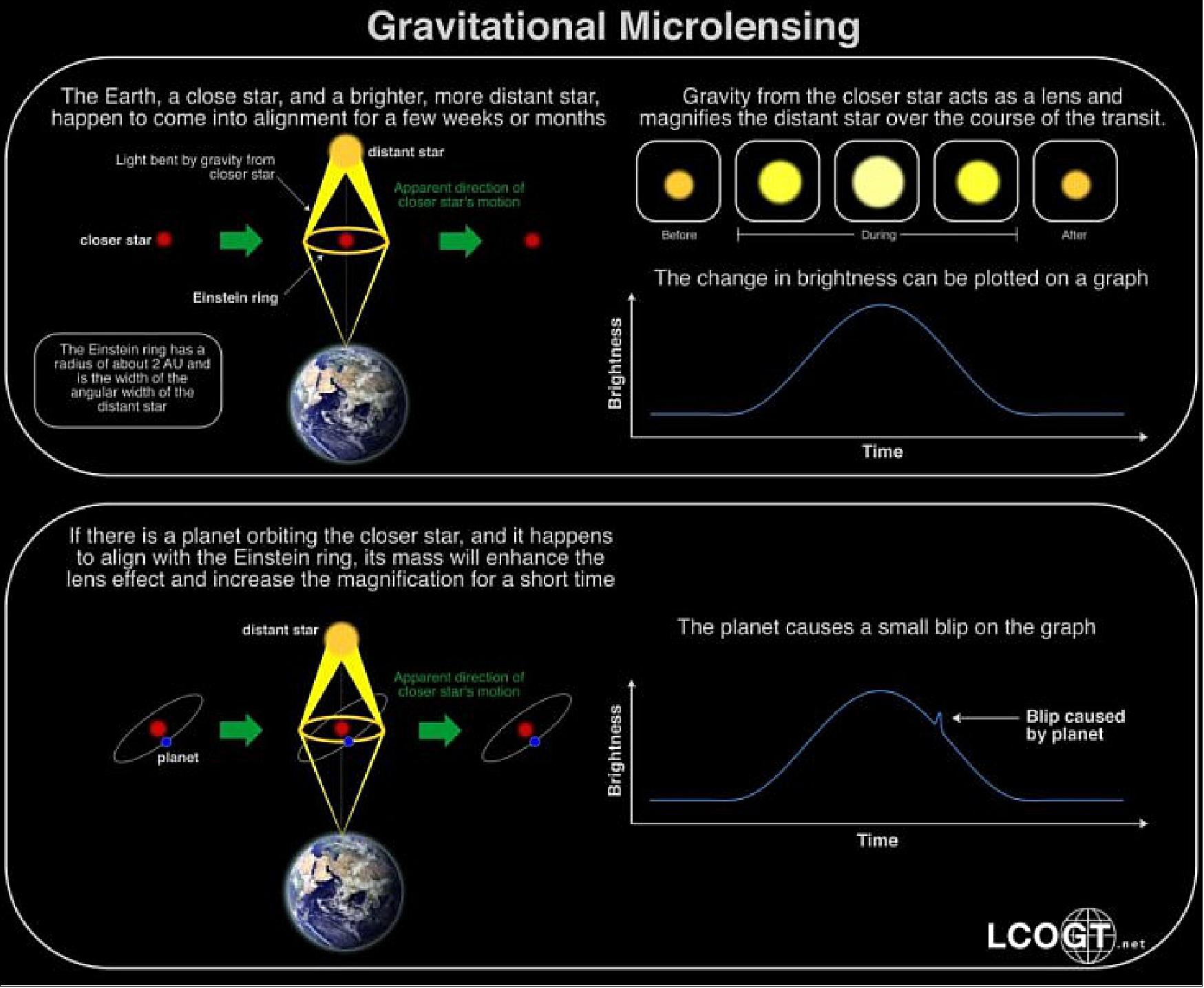
Methodology
- OGLE-2012-BLG-0950Lb was first detected by the microlensing survey telescopes of the Optical Gravitational Lensing Experiment (OGLE) and the Microlensing Observations in Astrophysics (MOA) collaborations.
- Bhattacharya's team then conducted follow-up observations using Keck Observatory's powerful adaptive optics system in combination with NIRC2.
- "The Keck observations allowed us to determine that the sub-Saturn or super-Neptune size planet has a mass of 39 times that of the Earth, and that its host star is 0.58 times the mass of the Sun," said Bennett. "They measured the separation of the foreground planetary system from the background star. This allowed us to work out the complete geometry of the microlensing event. Without this data, we only knew the star-planet mass ratio, not the individual masses."
- For the statistical study, Suzuki's team and MOA analyzed the properties of 30 sub-Saturn planets found by microlensing and compared them to predictions from the core accretion theory.
Challenging the Theory
- What is unique about the microlensing method is its sensitivity to sub-Saturn planets like OGLE-2012-BLG-0950Lb that orbit beyond the "snow line" of their host stars.
- The snow line, or frost line, is the distance in a young solar system, (a.k.a. a protoplanetary disk) at which it is cold enough for water to condense into ice. At and beyond the snow line there is a dramatic increase in the amount of solid material needed for planet formation. According to the core accretion theory, the solids are thought to build up into planetary cores first through chemical and then gravitational processes.
- "A key process of the core accretion theory is called "runaway gas accretion," said Bennett. "Giant planets are thought to start their formation process by collecting a core mass of about 10 times the Earth mass in rock and ice. At this stage, a slow accretion of hydrogen and helium gas begins until the mass has doubled. Then, the accretion of hydrogen and helium is expected to speed up exponentially in this runaway gas accretion process. This process stops when the supply is exhausted. If the supply of gas is stopped before runaway accretion stops, we get "failed Jupiter" planets with masses of 10-20 Earth-masses (like Neptune)."
- The runaway gas accretion scenario of the core accretion theory predicts that planets like OGLE-2012- BLG-0950Lb are expected to be rare. At 39 times the mass of the Earth, planets this size are thought to be continuing through a stage of rapid growth, ending in a much more massive planet. This new result suggests that the runaway growth scenario may need revision.
- Suzuki's team compared the distribution of planet-star mass ratios found by microlensing to distributions predicted by the core accretion theory. They found that the core accretion theory's runaway gas accretion process predicts about 10 times fewer intermediate mass giant planets like OGLE-2012- BLG-0950Lb than are seen in the microlensing results.
- This discrepancy implies that gas giant formation may involve processes that have been overlooked by existing core accretion models, or that the planet forming environment varies considerably as a function of host star mass.
Next Steps
- This discovery has not only called into question an established theory, it was made using a new technique that will be a key part of NASA's next big planet finding mission, the Wide Field Infra-Red Survey Telescope (WFIRST), which is scheduled to launch into orbit in the mid-2020s.
- "This is exactly the method that WFIRST will use to measure the masses of the planets that it discovers with its exoplanet microlensing survey. Until WFIRST comes online, we need to develop this method with observations from our Keck Key Strategic Mission Support (KSMS) program as well as observations from Hubble," said Bennett.
- "It's very exciting to see Keck and Hubble combine forces to provide this surprising new result," said Keck Observatory Chief Scientist John O'Meara. "And it's equally exciting to know that we can make these kind of advances today to help facilitate the best science from WFIRST and Keck's partnership in the future."
- The NASA Keck KSMS program will continue to make follow-up observations of microlensing events detected by telescopes on the ground and in space.
• 8 January 2019: Rocky planets orbiting red dwarf stars may be bone dry and lifeless, according to a new study using NASA's Hubble Space Telescope. Water and organic compounds, essential for life as we know it, may get blown away before they can reach the surface of young planets. 103)
- This hypothesis is based on surprising observations of a rapidly eroding dust-and-gas disk encircling the young, nearby red dwarf star AU Microscopii (AU Mic) by Hubble and the European Southern Observatory's VLT (Very Large Telescope) in Chile. Planets are born in disks like this one. - Red dwarfs, which are smaller and fainter than our Sun, are the most abundant and longest-lived stars in the galaxy.
- Fast-moving blobs of material appear to be ejecting particles from the AU Mic disk. If the disk continues to dissipate at this rapid pace, it will be gone in about 1.5 million years. In that short time, icy material from comets and asteroids could be cleared out of the disk. Comets and asteroids are important because they are believed to have seeded rocky planets such as Earth with water and organic compounds, the chemical building blocks for life. If this same transport system is needed for planets in the AU Mic system, then they may end up "dry" and dusty—inhospitable for life as we know it.
- "The Earth, we know, formed 'dry,' with a hot, molten surface, and accreted atmospheric water and other volatiles for hundreds of millions of years, being enriched by icy material from comets and asteroids transported from the outer solar system," said co-investigator Glenn Schneider of Steward Observatory in Tucson, Arizona. The observations are led by John Wisniewski of the University of Oklahoma in Norman, whose team is composed of 14 astronomers from the U.S. and Europe. 104)
- If the activity around AU Mic is typical of the planet-birthing process among red dwarfs, it could further reduce prospects of habitable worlds across our galaxy. Previous observations suggest that a torrent of ultraviolet light from young red dwarf stars quickly strips away the atmosphere of any orbiting planets. This particular star is only 23 million years old.
![Figure 81: These two NASA Hubble Space Telescope images, taken six years apart, show fast-moving blobs of material sweeping outwardly through a debris disk around the young, nearby red dwarf star AU Microscopii (AU Mic). Red dwarfs are the most abundant and longest-lived stars in our Milky Way galaxy. AU Mic is approximately 23 million years old. The top image was taken in 2011; the bottom in 2017. Hubble's Space Telescope Imaging Spectrograph (STIS) took the images in visible light. This comparison of the two images shows the six-year movement of one of the known blobs (marked by an arrow). Researchers estimate that the blob, which is zipping along at nearly 15,000 miles an hour, traveled more that 820 million miles between 2011 and 2017. That is about the distance from Earth to Saturn. Astronomers do not know how the blobs are launched through the system. Eventually, the blob highlighted in the image will sweep through the disk, escape the star's gravitational grip, and race out into space. Astronomers expect the string of blobs to clear out the disk within 1.5 million years. Their estimated ejection speeds are between 9,000 miles per hour and 27,000 miles per hour, fast enough to escape the star's gravitational clutches. They currently range in distance from roughly 930 million miles to more than 5.5 billion miles from the star. The disk, seen edge-on, is illuminated by scattered light from the star. The glare of the star, located at the center of the disk, has been blocked out by the STIS coronagraph so that astronomers can see more structure in the disk. The bright dot above the left side of the disk in the 2017 image is a background star. The system resides 32 light-years away in the southern constellation Microscopium [image credit: NASA, ESA, J. Wisniewski (University of Oklahoma), C. Grady (Eureka Scientific), and G. Schneider (Steward Observatory)]](/api/cms/documents/163813/5502378/Hubble2019_Auto2.jpeg)
- Surveys have shown that terrestrial planets are common around red dwarfs. In fact, they should contain the bulk of our galaxy's planet population, which could number tens of billions of worlds. Planets have been found within the habitable zone of several nearby red dwarfs, but their physical characteristics are largely unknown.
Blown Out by Blobs
- Observations by Hubble's Space Telescope Imaging Spectrograph (STIS) and the VLT show that the AU Mic circumstellar disk is being excavated by fast-moving blobs of circumstellar material, which are acting like a snowplow by pushing small particles—possibly containing water and other volatiles—out of the system. Researchers don't yet know how the blobs were launched. One theory is that powerful mass ejections from the turbulent star expelled them. Such energetic activity is common among young red dwarfs.
- "These observations suggest that water-bearing planets might be rare around red dwarfs because all the smaller bodies transporting water and organics are blown out as the disk is excavated," explained Carol Grady of Eureka Scientific in Oakland, California, co-investigator on the Hubble observations.
- Conventional theory holds that billions of years ago Earth formed as a comparatively dry planet. Gravitationally perturbed asteroids and comets, rich in water from the cooler outer solar system, bombarded Earth and seeded the surface with ice and organic compounds. "However, this process may not work in all planetary systems," Grady said.
![Figure 82: The Hubble Space Telescope image on the left is an edge-on view of a portion of a vast debris disk around the young, nearby red dwarf star AU Microscopii (AU Mic). Though planets may have already formed in the disk, Hubble is tracking the movement of several huge blobs of material that could be "snowplowing" remaining debris out of the system, including comets and asteroids. The box in the image at left highlights one blob of material extending above and below the disk. Hubble's Space Telescope Imaging Spectrograph (STIS) took the picture in 2018, in visible light. The glare of the star, located at the center of the disk, has been blocked out by the STIS coronagraph so that astronomers can see more structure in the disk. The STIS close-up image at right reveals, for the first time, details in the blobby material, including a loop-like structure and a mushroom-shaped cap. Astronomers expect the train of blobs to clear out the disk within only 1.5 million years. The consequences are that any rocky planets could be left bone-dry and lifeless, because comets and asteroids will no longer be available to glaze the planets with water or organic compounds. AU Mic is approximately 23 million years old. The system resides 32 light-years away in the southern constellation Microscopium. Credit: NASA, ESA, J. Wisniewski (University of Oklahoma), [image credit: C. Grady (Eureka Scientific), and G. Schneider (Steward Observatory)]](/api/cms/documents/163813/5502378/Hubble2019_Auto1.jpeg)
- The team determined the disk's lifespan by using an estimated mass of the disk from an independent study, as well as calculating the mass of the escaping blobs in their STIS visible-light data. The mass of each blob is about four ten-millionths the mass of Earth. The disk's mass—about 1.7 times more massive than Earth—is based on data taken by the ALMA (Atacama Large Millimeter/submillimeter Array ).
- Although the mass of the wayward blobs seems tiny, the diameter of each blob could stretch at least from the Sun to Jupiter. At present, the team has spotted six outbound blobs, but it is possible that there is a continuous stream of them. Groups of blobs careening through the disk could sweep out material fairly quickly.
- "The fast dissipation of the disk is not something I would have expected," Grady said. "Based on the observations of disks around more luminous stars, we had expected disks around fainter red dwarf stars to have a longer time span. In this system, the disk will be gone before the star is 25 million years old." She added that AU Mic likely started out with an outer rim of small icy bodies, like the Kuiper belt found within our own solar system. If the disk weren't being eroded, it would have provided ices to any dry inner planets.
Probing the Blob Mystery
- Hubble astronomers spotted the blobs in STIS visible-light images taken in 2010-2011. As a follow-up to the Hubble study, the SPHERE (Spectro-Polarimetric High-contrast Exoplanet Research) instrument mounted on the European Southern Observatory's Very Large Telescope in Chile, made near-infrared observations. Features in the disk were hinted at in observations taken in 2004 by ground-based telescopes and Hubble's Advanced Camera for Surveys.
- So far, the team has uncovered blobs on the disk's southeast side, with estimated ejection speeds between 9,000 miles per hour and 27,000 miles per hour, fast enough to escape the star's gravitational clutches. They currently range in distance from roughly 930 million miles to more than 5.5 billion miles from the star.
- Hubble is also showing that these blobs may not just be giant balls of dusty debris. The telescope has resolved substructure in one of the blobs, including a mushroom-shaped cap above the plane of the disk itself and a complex "loop-like" structure below the disk. "These structures could yield clues to the mechanisms that drive these blobs," Schneider said. - The system resides 32 light-years away in the southern constellation Microscopium.
- "AU Mic is ideally placed," Schneider said. "But it is only one of about three or four red-dwarf systems with known starlight-scattering disks of circumstellar debris. The other known systems are typically about six times farther away, so it's challenging to conduct a detailed study of the types of features in those disks that we see in AU Mic."
- However, astronomers are beginning to identify some possibly similar activity in these other systems. "It shows that AU Mic is not unique," Grady said. "In fact, you could argue that because it is one of the nearest systems of this type, it would be unlikely that it would be unique."
- The AU Mic observations show the importance of a star's disk environment on planet formation and evolution. "What we have learned is that disks seem to be a normal part of the history of planetary systems," Grady said. "If you don't understand a star's disk, you don't have a good understanding of the resulting planetary system."
• 7 January 2019: The NASA/ESA Hubble Space Telescope has captured the most detailed image yet of a close neighbor of the Milky Way – the Triangulum Galaxy, a spiral galaxy located at a distance of only three million light-years. This panoramic survey of the third-largest galaxy in our Local Group of galaxies provides a mesmerizing view of the 40 billion stars that make up one of the most distant objects visible to the naked eye. 105)
- This new image of the Triangulum Galaxy – also known as Messier 33 or NGC 598 – has a staggering 665 million pixels and showcases the central region of the galaxy and its inner spiral arms. To stitch together this gigantic mosaic, Hubble's ACS (Advanced Camera for Surveys) needed to create 54 separate images.
- Under excellent dark-sky conditions, the Triangulum Galaxy can be seen with the naked eye as a faint, blurry object in the constellation of Triangulum (the Triangle), where its ethereal glow is an exciting target for amateur astronomers.
- At only three million light-years from Earth, the Triangulum Galaxy is a notable member of the Local Group – it is the group's third-largest galaxy, but also the smallest spiral galaxy in the group [1]. It measures only about 60 000 light-years across, compared to the 200 000 light-years of the Andromeda Galaxy; the Milky Way lies between these extremes at about 100 000 light-years in diameter [2].
Note 1: Our galaxy, the Milky Way, is part of the Local Group, an assembly of more than 50 galaxies bound together by gravity. Its largest member is the Andromeda Galaxy – also known as Messier 31 – followed by the Milky Way and the Triangulum Galaxy. The remaining members of the Local Group are dwarf galaxies, each orbiting one of the three larger ones.
Note 2: The much bigger Andromeda Galaxy was mapped by Hubble in 2015, creating the sharpest and largest image of this galaxy and the largest Hubble image ever (heic1502).
- The Triangulum Galaxy is not only surpassed in size by the other two spirals, but by the multitude of stars they contain. The Triangulum Galaxy has at least an order of magnitude less stars than the Milky Way and two orders of magnitude less than Andromeda. These numbers are hard to grasp when already in this image 10 to 15 million individual stars are visible.
![Figure 83: This gigantic image of the Triangulum Galaxy – also known as Messier 33 – is a composite of about 54 different pointings with Hubble's Advanced Camera for Surveys. With a staggering size of 34,372 times 19,345 pixels, it is the second-largest image ever released by Hubble. The mosaic of the Triangulum Galaxy showcases the central region of the galaxy and its inner spiral arms. Millions of stars, hundreds of star clusters and bright nebulae are visible. This image is too large to be easily displayed at full resolution and is best appreciated using the zoom tool [image credit: NASA, ESA, and M. Durbin, J. Dalcanton, and B. F. Williams (University of Washington)]](/api/cms/documents/163813/5502378/Hubble2019_Auto0.jpeg)
- In contrast to the two larger spirals, the Triangulum Galaxy doesn't have a bright bulge at its center and it also lacks a bar connecting its spiral arms to the center. It does, however, contain a huge amount of gas and dust, giving rise to rapid star formation. New stars form at a rate of approximately one solar mass every two years.
- The abundance of gas clouds in the Triangulum Galaxy is precisely what drew astronomers to conduct this detailed survey. When stars are born, they use up material in these clouds of gas and dust, leaving less fuel for new stars to emerge. Hubble's image shows two of the four brightest of these regions in the galaxy: NGC 595 and NGC 604. The latter is the second most luminous region of ionized hydrogen within the Local Group and it is also among the largest known star formation regions in the Local Group.
- These detailed observations of the Triangulum Galaxy have tremendous legacy value – combined with those of the Milky Way, the Andromeda Galaxy and the irregular Magellanic Cloud galaxies, they will help astronomers to better understand star formation and stellar evolution.
References
1) ”Hubble Spots Galaxy With Active Galactic Nucleus,” NASA, 27 December 2019, URL: https://www.nasa.gov/image-feature/goddard/2019/hubble-views-a-galaxy-with-an-active-center
2) ”'Cotton Candy' Planet Mysteries Unravel in New Hubble Observations,” NASA Hubblesite, 19 December 2019, URL: https://hubblesite.org/contents/news-releases/2019/news-2019-60
3) ”Hubble Observes a Mystery: 'Cotton Candy' Planets,” NASA Exoplanet Exploration, 24 December 2019, URL: https://exoplanets.nasa.gov/news/1614/hubble-observes-a-mystery-cotton-candy-planets/
4) ”Hubble’s celestial peanut,” ESA Science & Exploration, 16 December 2019, URL: http://www.esa.int/ESA_Multimedia/Images/2019/12/Hubble_s_celestial_peanut
5) ”Hubble watches interstellar Comet Borisov speed past the Sun,” ESA, 13 December 2019, URL: http://www.esa.int/About_Us/Corporate_news/Week_in_images_9-13_December_2019
6) ”Interstellar Comet 2I/Borisov Swings Past the Sun,” NASA Hubblesite, 12 December 2019, URL: https://hubblesite.org/contents/news-releases/2019/news-2019-61
7) ”Comet 2I/Borisov and Distant Galaxy in November 2019,” ESA, 12 December 2019, URL: https://sci.esa.int/web/hubble/-/comet-2i/borisov-and-distant-galaxy-in-november-2019
8) ”A dramatic demise,” ESA Science & Exploration, 6 December 2019, URL: http://www.esa.int/About_Us/Corporate_news/Week_in_images_2-6_December_20192
9) ”A close relationship,” Hubble Space Telescope, 25 November 2019, URL: https://www.spacetelescope.org/images/potw1947a/, https://www.esa.int/About_Us/Corporate_news/Week_in_images_br_25-29_November_2019
10) ”Hubble studies gamma-ray burst with the highest energy ever seen,” ESA Science & Exploration, 21 November 2019, URL: http://www.esa.int/About_Us
/Corporate_news/Week_in_images_br_18-22_November_2019
11) ”Hubble Studies Gamma-Ray Burst with the Highest Energy Ever Seen,” NASA Hubblesite, Release ID: 2019-56, 20 November 2019, URL: https://hubblesite.org/contents/news-releases/2019/news-2019-56
12) ”Hubble Studies Gamma-Ray Burst with the Highest Energy Ever Seen,” Hubble Space Telescope, heic1921 — Science Release, 20 November 2019, URL: https://www.spacetelescope.org/news/heic1921/
13) ”A rival to the Milky Way,” ESA Science & Exploration, 15 November 2019, URL: http://www.esa.int/About_Us/Corporate_news/Week_in_images4
14) ”Hubble Captures a Dozen Sunburst Arc Doppelgangers,” Hubble Space Telescope, heic1920 — Photo Release, 07 November 2019, URL: https://spacetelescope.org/news/heic1920/
15) ”A ghost in the Pleiades,” ESA Science & Exploration, Space Science image of the week, 01 November 2019, URL: http://www.esa.int/
16) ”Hubble Captures Cosmic Face,” Hubble Space Telescope, heic1919 — Photo Release, 28 October 2019, URL: https://www.spacetelescope.org/news/heic1919/?lang
17) ”Hubble Captures Galaxies' Ghostly Gaze,” Hubblesite, 28 October 2019, Release ID: 2019-51, URL: https://hubblesite.org/contents/news-releases/2019/news-2019-51
18) ”A familiar sight,” ESA, 25 October 2019, URL: http://www.esa.int/About_Us/Corporate_news/Week_in_images
19) ”A galactic portal,” ESA, Our week through the lens, 18 October 2019, URL: https://www.esa.int
/spaceinimages/Images/2019/10/A_galactic_portal
20) ”Dark matter tugs the most massive spiral galaxies to breakneck speeds,” NASA, Hubblesite, Release ID: 2019-54, 17 October 2019: URL: https://hubblesite.org/contents/news-releases/2019/news-2019-54
21) ”Foreground asteroid passing the Crab Nebula,” ESA, 14 October 2019, URL: http://www.esa.int
/spaceinimages/Images/2019/10/Foreground_asteroid_passing_the_Crab_Nebula
22) Claire Andreoli, Ray Villard, Stuart Volpert, David Jewitt, ”Hubble Observes 1st Confirmed Interstellar Comet,” NASA Feature, 16 October 2019, URL: https://www.nasa.gov/feature
/goddard/2019/hubble-observes-1st-confirmed-interstellar-comet
23) ”A spiral in profile,” ESA Picture of the Week, 11 October 2019, URL: http://www.esa.int/spaceinimages/Images/2019/10/A_spiral_in_profile
24) ”Snakes and stones,” ESA, 4 October 2019, URL: http://www.esa.int/spaceinimages/Images/2019/09/Snakes_and_stones
25) ”Beacon of Light,” HST, 23 September 2019, URL: https://www.spacetelescope.org/images/potw1938a/
26) ”Beacon of Light,” ESA, Space Images, 27 September 2019, URL: http://www.esa.int/spaceinimages/Images/2019/09/Beacon_of_light
27) ”Not so dead after all,” ESA, 20 September 2019, URL: https://www.esa.int/spaceinimages/Images/2019/09/Not_so_dead_after_all
28) ”Not So Dead After All,” Hubble Space Telescope, 16 September 2019, URL: https://www.spacetelescope.org/images/potw1937a/
29) ”Saturn's Rings Shine in Hubble's Latest Portrait,” NASA, 12 September 2019, URL: https://www.nasa.gov/feature/goddard/2019/saturns-rings-shine-in-hubbles-latest-portrait
30) ”Hubble finds water vapor on habitable-zone exoplanet for the first time,” ESA, heic1916, 11 September 2019, URL: https://sci.esa.int/web/hubble/-
/hubble-finds-water-vapour-on-habitable-zone-exoplanet-for-the-first-time-heic1916-
31) ”NASA’s Hubble Finds Water Vapor on Habitable-Zone Exoplanet for 1st Time,” NASA, 11 September 2019, URL: https://www.nasa.gov/feature/goddard/2019
/nasa-s-hubble-finds-water-vapor-on-habitable-zone-exoplanet-for-1st-time
32) The observations were achieved from 9 transits of K2-18b with the NASA/ESA Hubble Space Telescope's Wide Field Camera 3 (WFC3), as part of the HST proposals 13665 and 14682 (PI: Björn Benneke).
33) Angelos Tsiaras, Ingo P. Waldmann, Giovanna Tinetti, Jonathan Tennyson & Sergey N. Yurchenko, ”Water vapor in the atmosphere of the habitable-zone eight-Earth-mass planet K2-18 b,” Nature Astronomy Letter, https://doi.org/10.1038/s41550-019-0878-9, Published: 11 September 2019
34) ”Hubble Explores the Formation and Evolution of Star Clusters in the Large Magellanic Cloud,” heic1915 — Science Release, 9 September 2019, URL: https://www.spacetelescope.org/news/heic1915/?lang
35) F. R. Ferraro, B. Lanzoni, E. Dalessandro, M. Cadelano, S. Raso, A. Mucciarelli, G. Beccari & C. Pallanc, ”Size diversity of old Large Magellanic Cloud clusters as determined by internal dynamical evolution,” Nature Astronomy, Published 9 September 2019, https://doi.org/10.1038/s41550-019-0865-1
36) ”Hubble’s legacy,” ESA, Our week through the lens, 06 September 2019, URL: http://www.esa.int/spaceinimages/Images/2019/09/Hubble_s_legacy
37) ”The death of a star,” ESA, 23 August 2019, URL: https://www.esa.int/spaceinimages/Images/2019/08/The_death_of_a_star
38) ”The inky abyss,” ESA, Our week through the lens:12 - 16 August 2019, URL: http://www.esa.int/spaceinimages/Images/2019/08/The_inky_abyss
39) ”Hubble Showcases New Portrait of Jupiter,” heic1914 — Photo Release, Hubble Space Telescope, 8 August 2019, URL: https://www.spacetelescope.org/news/heic1914/?lang
40) ”Feeling edgy,” ESA image of the week, 02 August 2019, URL: http://www.esa.int/spaceinimages/Images/2019/07/Feeling_Edgy
41) ”Heavy elements detected for first time escaping exoplanet,” Hubblesite, 01 August 2019, Release ID: 2019-19, URL: https://hubblesite.org/contents/news-releases/2019/news-2019-19
42) David K. Sing, Panayotis Lavvas, Gilda E. Ballester, Alain Lecavelier des Etangs, Mark S. Marley, Nikolay Nikolov, Lotfi Ben-Jaffel, Vincent Bourrier, Lars A. Buchhave, Drake L. Deming, David Ehrenreich, Thomas Mikal-Evans, Tiffany Kataria, Nikole K. Lewis, Mercedes López-Morales, Antonio García Muñoz, Gregory W. Henry, Jorge Sanz-Forcada, Jessica J. Spake, Hannah R. Wakeford (The PanCET collaboration), ”The Hubble Space Telescope PanCET Program: Exospheric Mg ii and Fe ii in the Near-ultraviolet Transmission Spectrum of WASP-121b Using Jitter Decorrelation,” The Astronomical Journal, Volume 158, Number 2, Published on 1 August 2019, https://doi.org/10.3847/1538-3881/ab2986, URL: https://hubblesite.org/uploads/science_paper/file_attachment/484/AJ_Sing_AJ_080119.pdf
43) Rob Garner, ”Hubble Snaps a Galactic Potpourri of Particles,” NASA, 26 July 2019, URL: https://www.nasa.gov/image-feature/goddard/2019/hubble-snaps-a-galactic-potpourri-of-particles
44) ”Up and Over,” ESA, Our week through the lens, 22-26 July 2019, URL: http://www.esa.int/Highlights/Week_In_Images_22_26_July_2019
45) ”New Hubble Constant Measurement Adds to Mystery of Universe's Expansion Rate,” Hubblesite, Release ID: 2019-28, 16 July 2019, URL: https://hubblesite.org
/contents/news-releases/2019/news-2019-28.html
46) Wendy L. Freedman, Barry F. Madore, Dylan Hatt, Taylor J. Hoyt, In-Sung Jang, Rachael L. Beaton, Christopher R. Burns, Myung Gyoon Lee, Andrew J. Monson, Jillian R. Neeley, Mark M. Phillips, Jeffrey A. Rich, Mark Seibert, ” The Carnegie-Chicago Hubble Program. VIII. An Independent Determination of the Hubble Constant Based on the Tip of the Red Giant Branch,” The Astrophysical Journal, Draft Version 16 July 2019, URL: https://arxiv.org/pdf/1907.05922.pdf
47) ”Hubble Discovers Mysterious Black Hole Disc,” heic1913 — Science Release, 11 July 2019, URL: https://www.spacetelescope.org/news/heic1913/?lang
48) Claire Andeoli, Donna Weaver, Ray Villard, Stefano Bianchi, Marco Chiaberge, Rob Garner, ”Hubble Uncovers Black Hole Disk that Shouldn't Exist,” NASA, 11 July 2019, URL: https://www.nasa.gov/feature/goddard/2019/hubble-uncovers-black-hole-that-shouldnt-exist
49) Stefano Bianchi, Robert Antonucci, Alessandro Capetti, Marco Chiaberge, Ari Laor, Loredana Bassani , Francisco J Carrera, Fabio La Franca, Andrea Marinucci , Giorgio Matt, Riccardo Middei, Francesca Panessa, ”HST unveils a compact mildly relativistic broad-line region in the candidate true type 2 NGC 3147,” Monthly Notices of the Royal Astronomical Society: Letters, Volume 488, Issue 1, September 2019, Pages L1–L5, https://doi.org/10.1093/mnrasl/slz080, Published: 11 July 2019
50) ”Galactic Cherry Blossom,” Hubble Space Telescope, 8 July 2019, URL: https://www.spacetelescope.org/images/potw1927a/
51) ”Atmosphere of Midsize Planet Revealed by Hubble, Spitzer,” NASA/JPL, 02 July 2019, URL: https://www.jpl.nasa.gov/news/news.php?feature=7444&utm_source=iContact&
utm_medium=email&utm_campaign=nasajpl&utm_content=spitzer-20190702-1
52) ”Hubble Captures Cosmic Fireworks in Ultraviolet,” Hubble Space Telescope, heic1912 — Photo Release, 1 July 2019, URL: https://www.spacetelescope.org/news/heic1912/?lang
53) ”Galaxies – with a chance of asteroids,” ESA, 24 June 2019, Space Science Image of the Week: Spot the trails left by asteroids in archive images from the Hubble Space Telescope, URL: http://www.esa.int/spaceinimages/Images/2019/06/Galaxies_with_a_chance_of_asteroids
54) ”Spiral, elliptical, irregular,” ESA, Space in images, 21 June 2019, URL: https://www.esa.int/spaceinimages/Images/2019/06/Spiral_elliptical_irregular
55) ”Hubble Observes Tiny Galaxy with Big Heart,” Hubble Space Telescope, heic1911 — Photo Release, 13 June 2019, URL: https://www.spacetelescope.org/news/heic1911/?lang
56) ”Galactic maturity,” ESA, 07 June 2019, URL: http://www.esa.int/Highlights/Week_In_Images_3_7_June_2019
57) ”Mature Galaxy Mesmerizes in New Hubble View,” NASA, 0 7 June 2019, URL: https://www.nasa.gov/image-feature/goddard/2019/mature-galaxy-mesmerizes-in-new-hubble-view
58) ”A Pair of Fledgling Planets Directly Seen Growing Around a Young Star,” Hubblesite, 3 June 2019, URL: http://hubblesite.org/news_release/news/2019-26
59) S. Y. Haffert, A. J. Bohn, J. de Boer, I. A. G. Snellen, J. Brinchmann, J. H. Girard, C. U. Keller and R. Bacon, ”Two accreting protoplanets around the young star PDS 70,” Nature Astronomy Letters, Published: 03 June 2019, https://doi.org/10.1038/s41550-019-0780-5, URL: http://imgsrc.hubblesite.org/hvi/uploads/science_paper/file_attachment/388/s41550-019-0780-5.pdf
60) Rob Garner, ”Hubble Sees a Galaxy Bucking the Trend,” NASA, 31 May 2019, URL: https://www.nasa.gov/image-feature/goddard/2019/hubble-sees-a-galaxy-bucking-the-trend
61) ”Hubble Observes Creative Destruction as Galaxies Collide,” heic1910 Photo Release,ESA/Hubble News, 16 May 2019, URL: https://www.spacetelescope.org/news/heic1910/?lang
62) ”Distant and Ancient,” ESA, Hubble Image of the Week, 10 May 2019, URL: http://www.esa.int/spaceinimages/Images/2019/05/Distant_and_ancient
63) Rob Garner, ”Hubble Spots Stunning Spiral Galaxy,” NASA, 3 May 2019, URL: https://www.nasa.gov/image-feature/goddard/2019/hubble-spots-stunning-spiral-galaxy
64) Donna Weaver , Ray Villard, Garth Illingworth, Claire Andreoli, ”Hubble Astronomers Assemble Wide View of the Evolving Universe,” NASA, 02 May 2019, URL: https://www.nasa.gov
/feature/goddard/2019/hubble-astronomers-assemble-wide-view-of-the-evolving-universe
65) ”Crowded cluster,” ESA, 26 April 2019, URL: http://m.esa.int/spaceinimages/Images/2019/04/Crowded_cluster
66) ”Mystery of the Universe's Expansion Rate Widens with New Hubble Data,” Hubblesite, News Release number: STScI-2019-25, 25 April 2019, URL: http://hubblesite.org/news_release/news/2019-25
67) ”Hubblecast 120 Light: Continued Discrepancy in the Universe's Expansion Rate,” HST, 25 April 2019, URL: https://www.spacetelescope.org/videos/heic1908a/
68) ”Hubble celebrates its 29th birthday with unrivaled view of the Southern Crab Nebula [heic1907],” ESA Science & Technology, 18 April 2019, URL: http://sci.esa.int/hubble
/61308-hubble-celebrates-its-29th-birthday-with-unrivaled-view-of-the-southern-crab-nebula-heic1907/
69) ”Understanding the Egg Nebula,” ESA, Space Science Image of the Week: Unwrapping the Egg Nebula to reveal the late stages of a star's life, 15 April 2019, URL: http://m.esa.int/spaceinimages/Images/2019/04/Understanding_the_Egg_Nebula
70) ”Hubble Snares Bevy of Shimmering Stars,” NASA, 5 April 2019, URL: https://www.nasa.gov
/image-feature/goddard/2019/hubble-snares-bevy-of-shimmering-stars
71) ”NASA Awards 2019 Postdoctoral Fellowships,” NASA, 4 April 2019, URL: https://www.nasa.gov/feature/goddard/2019/nasa-awards-2019-postdoctoral-fellowships
72) ”Hubble to Conduct Largest-Ever Survey of Kuiper Belt,” NASA, 2 April 2019, URL: https://solarsystem.nasa.gov/news/891/hubble-to-conduct-largest-ever-survey-of-kuiper-belt/
73) ”Wild cosmic ducks,” ESA, 29 March 2019, URL: https://www.esa.int/spaceinimages/Images/2019/03/Wild_cosmic_ducks
74) Donna Weaver, Ray Villard,Claire Andreoli, Rob Garner, ”Hubble Watches Spun-Up Asteroid Coming Apart,” NASA, 28 March 2019, URL: https://www.nasa.gov
/feature/goddard/2019/hubble-watches-spun-up-asteroid-coming-apart
75) ”Invisible X-rays,” Hubble Space Telescope, 18 March 2019, URL: https://spacetelescope.org/images/potw1911a/
76) ”Hubble & Gaia accurately weigh the Milky Way [heic1905],” ESA Science & Technology, 7 March 2019, URL: http://sci.esa.int/hubble/61198-hubble-and-gaia-accurately-weigh-the-milky-way-heic1905/
77) ”What Does the Milky Way Weigh? Hubble and Gaia Investigate,” Hubblesite, 07 March 2019, Release ID: STScI-2019-16, URL: http://hubblesite.org/news_release/news/2019-16
78) Laura L. Watkins, Roeland P. van der Marel, Sangmo Tony Sohn, N. Wyn Evans, ”Evidence for an Intermediate-Mass Milky Way from Gaia DR2 Halo Globular Cluster Motions,” The Astrophysical Journal, Draft version, 11 February 2019, URL: https://arxiv.org/pdf/1804.11348.pdf
79) ”Hubble's Advanced Camera for Surveys Resumes Operations,” Hubblesite, 06 March 2019, News Release number: STScI-2019-23, URL: http://hubblesite.org/news_release/news/2019-23
80) ”Advanced Camera for Surveys Anomaly on Hubble Space Telescope,” Hubblesite News, Release ID: STScI-2019-21, 1 March 2019, URL: http://hubblesite.org/news_release/news/2019-21
81) ”The two mysterious populations of NGC 2419,” ESA, 01 March 2019, URL: http://m.esa.int/spaceinimages/Images/2019/03/The_two_mysterious_populations_of_NGC_2419
82) ”Tiny Neptune Moon Spotted by Hubble May Have Broken from Larger Moon,” Hubblesite, Release ID: STScI-2019-04, 20 February 2019, URL: http://hubblesite.org/news_release/news/2019-04
83) ”Hubble helps uncover origin of Neptune's smallest moon Hippocamp [heic1904],” ESA Science & Technology, 20 February 2019, URL: http://sci.esa.int/hubble
/61142-hubble-helps-uncover-origin-of-neptune-s-smallest-moon-hippocamp-heic1904/
84) M. R. Showalter, I. de Pater, J. J. Lissauer & R. S. French, ”The seventh inner moon of Neptune,” Nature Letter, Vol. 566, pp:350-353, Published: 20 February 2019, Issue date: 21 February 2019, https://doi.org/10.1038/s41586-019-0909-9
85) ”Hubble Captures Smoking Gun of a Newborn Star,” NASA, 15 February 2019, URL: https://www.nasa.gov/image-feature/goddard/2019/hubble-captures-smoking-gun-of-a-newborn-star
86) Ray Villard , Claire Saravia, Rob Garner, ”Hubble Reveals Dynamic Atmospheres of Uranus, Neptune,” NASA, 11 February 2019, URL: https://www.nasa.gov/feature
/goddard/2019/hubble-reveals-dynamic-atmospheres-of-uranus-neptune
87) ”Blue Marbles,” ESA, 18 February 2019, URL: http://m.esa.int/spaceinimages/Images/2019/02/Blue_marbles
88) ”The darkness within?,” HST (Hubble Space Telescope), 4 February 2019, URL: https://www.spacetelescope.org/images/potw1905a/
89) ”Hubble fortuitously discovers a new galaxy in the cosmic neighborhood [heic1903],” ESA, Hubble Science & Technology, 31 January 2019, URL: http://sci.esa.int/hubble
/61075-hubble-fortuitously-discovers-a-new-galaxy-in-the-cosmic-neighbourhood-heic1903/
90) L. R. Bedin, M. Salaris, R. M. Rich, H. Richer, J. Anderson, D. Bettoni, D. Nardiello, A. P. Milone, A. F .Marino, M. Libralato, A. Bellini, A. Dieball, P. Bergeron, A. J. Burgasser, D. Apai, ”The HST Large Program on NGC 6752. I. Serendipitous discovery of a dwarf Galaxy in background,” Monthly Notices of the Royal Astronomical Society: Letters, Volume 484, Issue 1, 21 March 2019, Pages L54–L58, https://doi.org/10.1093/mnrasl/slz004,
91) ”Hubble Sees Plunging Galaxy Losing Its Gas,” Hubblesite, 24 January 2019, URL: http://hubblesite.org/news_release/news/2019-05
92) W. J. Cramer, J. D. P. Kenney, M. Sun, H. Crowl, M. Yagi, P. Jáchym, E. Roediger, W. Waldron, ”Spectacular Hubble Space Telescope Observations of the Coma Galaxy D100 and Star Formation in Its Ram Pressure–stripped Tail,” The Astrophysical Journal, Vol. 870, No 2, Published 8 January 2019, https://doi.org/10.3847/1538-4357/aaefff, URL: https://iopscience.iop.org
/article/10.3847/1538-4357/aaefff/pdf
93) ”Shedding new light on the Whirlpool Galaxy,” Hubblesite, 24 January 2019, URL: http://hubblesite.org/video/1195/category/109-scientific-visualizations
94) ”Hubble Image of the Week – Peering Into The Past,” Scitech Daily, 21 January 2019, URL: https://scitechdaily.com/hubble-image-of-the-week-peering-into-the-past/
95) ”Hubble’s Wide Field Camera 3 Recovered, Collecting Science Data,” NASA, 17 January 2019, URL: https://www.nasa.gov/feature/goddard/2019
/wide-field-camera-3-anomaly-on-hubble-space-telescope
96) ”Hubble's Wide Field Camera 3 to Resume Operations,” Hubblesite, News Release number: STScI-2019-10, 15 January 2019, URL: http://hubblesite.org/news_release/news/2019-10
97) ”Hubble’s Wide Field Camera 3 to Resume Operations,” NASA, 15 January 2019, URL: https://www.nasa.gov/feature/goddard/2019/wide-field-camera-3-anomaly-on-hubble-space-telescope
98) ”Messier Monday,” ESA, 14 January 2019, URL: https://www.spacetelescope.org/images/potw1902a/
99) Rob Garner, ”Wide Field Camera 3 Anomaly on Hubble Space Telescope,” NASA, 9 January 2019, URL: https://www.nasa.gov/feature/goddard/2019/wide-field-camera-3-anomaly-on-hubble-space-telescope
100) Alexandra Witze, ”Hubble telescope camera is broken — and US government shutdown could delay repairs,” Nature News, 9 January 2019, URL: https://www.nature.com/articles/d41586-019-00094-0
101) ”Nature's magnifying glass reveals unexpected intermediate mass exoplanets,” Science Daily, 8 January 2019, URL: https://www.sciencedaily.com/releases/2019/01/190108141339.htm
102) Daisuke Suzuki, David P. Bennett, Shigeru Ida, Christoph Mordasini, Aparna Bhattacharya, Ian A. Bond, Martin Donachie, Akihiko Fukui, Yuki Hirao, Naoki Koshimoto, Shota Miyazaki, Masayuki Nagakane, Clément Ranc, Nicholas J. Rattenbury, Takahiro Sumi, Yann Alibert, and Douglas N. C. Lin, ”Microlensing Results Challenge the Core Accretion Runaway Growth Scenario for Gas Giants,” The Astrophysical Journal Letters, Volume 869, Number 2, Published 19 December 2018, L34 DOI: 10.3847/2041-8213/aaf577, URL of abstract: http://iopscience.iop.org/article/10.3847/2041-8213/aaf577/meta
103) ”Young planets orbiting red dwarfs may lack ingredients for life,” Phys.org, 8 January 2019, URL: https://phys.org/news/2019-01-young-planets-orbiting-red-dwarfs.html
104) A. Boccaletti, E. Sezestre, A.-M. Lagrange, P. Thébault, R. Gratton, M. Langlois, C. Thalmann, M. Janson, P. Delorme, J.-C. Augereau, G. Schneider, J. Milli, C. Grady, J. Debes, Q. Kral, J. Olofsson, J. Carson, A. L. Maire, T. Henning, J. Wisniewski, J. Schlieder, C. Dominik, S. Desidera, C. Ginski, D. Hines, F. Ménard, D. Mouillet, N. Pawellek, A. Vigan, E. Lagadec, H. Avenhaus, J.-L. Beuzit, B. Biller, M. Bonavita, M. Bonnefoy, W. Brandner, F. Cantalloube, G. Chauvin, A. Cheetham, M. Cude, C. Gry, S. Daemgen, M. Feldt, R. Galicher, J. Girard, J. Hagelberg, P. Janin-Potiron, M. Kasper, H. Le Coroller, D. Mesa, S. Peretti, C. Perrot, M. Samland, E. Sissa, F. Wildi, A. Zurlo, S. Rochat, E. Stadler, L. Gluck, A. Origné, M. Llored, P. Baudoz, G. Rousset, P. Martinez and F. Rigal, ”Observations of fast-moving features in the debris disk of AU Mic on a three-year timescale: Confirmation and new discoveries,” Astronomy & Astrophysics, Volume 614, 15 June 2018, https://doi.org/10.1051/0004-6361/201732462, URL: https://www.aanda.org/articles/aa/pdf/2018/06/aa32462-17.pdf
105) ”Hubble takes gigantic image of the Triangulum Galaxy [heic1901],” ESA Science % Technology, 7 January 2019, URL: http://sci.esa.int/hubble
/61036-hubble-takes-gigantic-image-of-the-triangulum-galaxy-heic1901/
The information compiled and edited in this article was provided by Herbert J. Kramer from his documentation of: ”Observation of the Earth and Its Environment: Survey of Missions and Sensors” (Springer Verlag) as well as many other sources after the publication of the 4th edition in 2002. - Comments and corrections to this article are always welcome for further updates (eoportal@symbios.space).